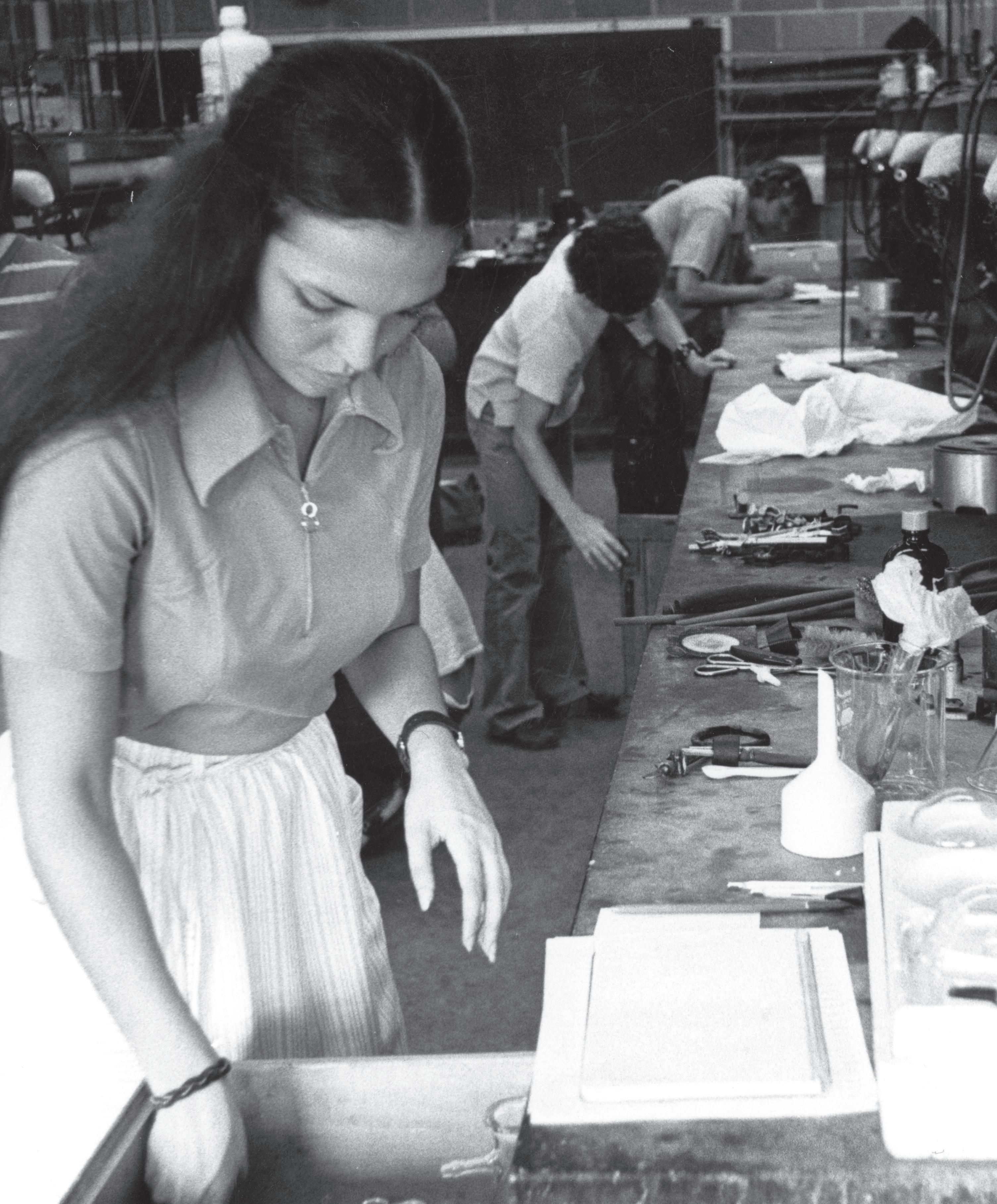
SPRING 2024
50 YEARS OF COEDUCATION
MANHATTAN COLLEGE
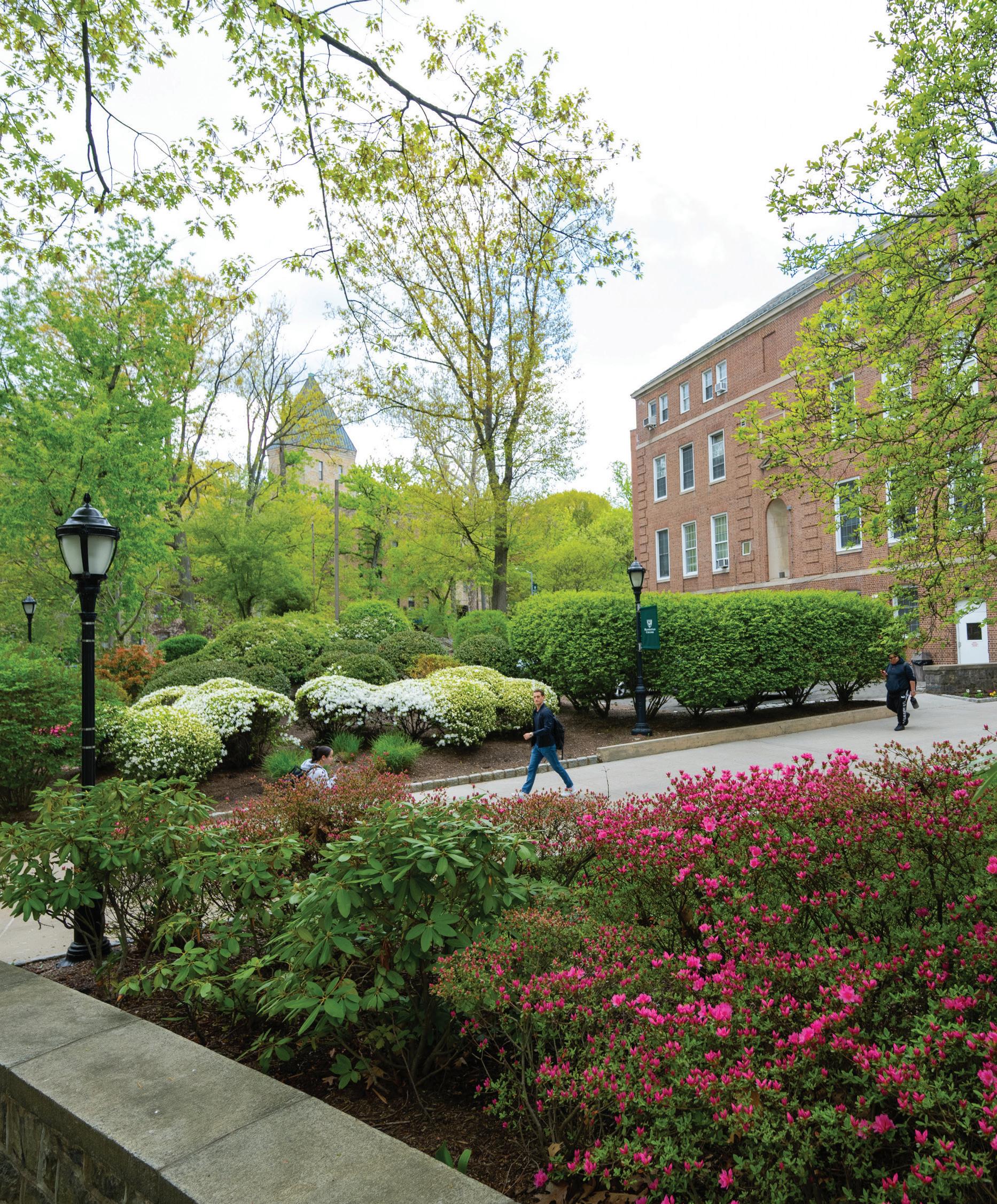

EDITOR
MANHATTAN COLLEGE SPRING 2024
VOLUME 50 • NUMBER 1
Kristen Cuppek
ASSISTANT EDITOR
Cecilia Donohoe
DESIGNER
Kat Lepak
CONTRIBUTORS
Patrice Athanasidy
Taylor Brethauer
Lydia Gray
Barry Moskowitz
Amy Surak
Denise Thompson
INTERN
Bianca Schad
PHOTOGRAPHERS
Ben Asen
Josh Cuppek
Brian Hatton
Angelina Perez
Ryan Werner
Mission Statement
M Magazine highlights Manhattan College’s community news primarily for our alumni, as well as faculty, staff, students, parents and friends.
With every issue, M Magazine strives to strengthen the valuable bond between the College and alumni by sharing reports of major accomplishments and activities, as well as compelling stories about our community. In informing and entertaining our readers, the magazine fosters a sense of pride and motivates engagement and support among all audiences.
ON THE COVER
Follow the journey that Manhattan women have taken during these past 50 years of coeducation highlighted in photos, such as this one from the 1970s.
magazine@manhattan.edu
2 ON CAMPUS
New Dorothy Day Center opens on campus, College is named a HispanicServing Institution, alumna becomes first Payne Fellow, and so much more.
26 SPORTS
Irma Garcia starts new chapter as director of athletics, plus news and fun facts from the past academic year.
30 50 YEARS OF COEDUCATION
The College celebrates 50 years of coeducation and the impact women have had on its history.
38 ACE MENTORING MILESTONE
Manhattan marks its 30th anniversary with the ACE Mentor Program and looks back on some pivotal moments.
42 DEVELOPMENT
Meet a student scholarship recipient, Patterson Scholarships are awarded, and how to give back to the College.
46 ALUMNI
Jaspers catch a Yankees game to celebrate the College's 100 years in the Bronx, alumnotes, profiles, and reminiscing about a once-popular tradition.
58 OBITUARIES
In memoriam, Henry Petroski, Michael Passarella, Father Greg Lyttle, Brother John Muller, FSC, Charles Thornton, Father James Cerbone, SDB
64 PARTING SHOT

Business School Formally Dedicates Third Floor

AFTER AN EXTENSIVE RENOVATION TO THE THIRD FLOOR OF DE LA SALLE HALL, the College hosted a dedication ceremony in October to showcase the new facilities and thank the many donors who made this experiential space possible.
Donald Gibson, dean of the O’Malley School of Business, welcomed guests and detailed the “journey” taken to accomplish these renovations.
“This endeavor has been a journey, one that began over four years ago and has culminated in the creation of a dynamic learning environment that harmoniously blends modern aesthetics with the latest in educational technology,” Gibson said. “This renewal signals the innovation, collaboration and academic excellence that exemplify the O’Malley School and Manhattan College.”
Working with the school’s advisory board, Gibson had emphasized the need for an environment that helps to prepare students for the technology-driven careers they will be seeking. He noted, “The Advisory Board and a range of other Jasper donors responded to this call to excellence: They truly understood the importance of the dream.”
This dream-come-true third floor now boasts a new Business Analytics Lab with 30 Dell OptiPlex 3090 computers; seven refurbished classrooms with new furniture, technology, floors and lighting; three student team-based work rooms with glass walls facing student lounge space; a large student lounge for work, study and meetings; as well as open and bright hallways with better wayfinding and large video display screens.
President Milo Riverso ’81 then discussed how these renovated rooms will not only improve the student learning process but also help drive enrollment to the business school.
“The lab places us at the forefront of the critical field of data analytics, which touches every industry and sector of American business,” Riverso said. “The student team workrooms and student lounge, along with the other new facilities, will allow business students
President Milo Riverso ’81, alongside Donald Gibson, dean of the O’Malley School of Business, and a dedicated group of donors celebrate with a ribbon-cutting ceremony.
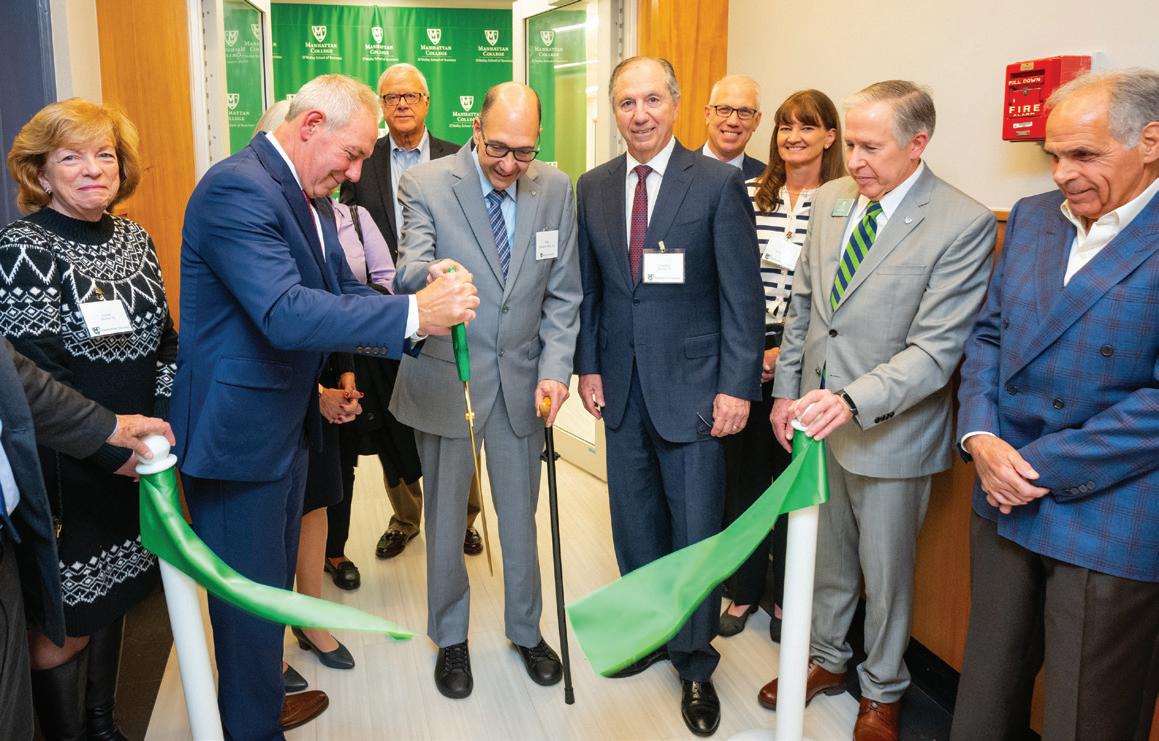
to study and collaborate on projects together, creating our business community and providing a ‘home away’ environment when not at their dorm or off-campus home.”
Mark Pfaff ’80, retired executive vice president of New York Life Insurance Company, was instrumental in jumpstarting the renovation project. He discussed the importance of giving back.
In answering the question why he gives his time and money, Pfaff advised, “Pay it forward, and leave the place better than when you got there.” A proud Jasper, he also noted what he loves about the College: its Lasallian values. “Lasallian is in our DNA,” he said. “It makes us special.”
Pfaff and his wife, Claudia, sponsored the High-Tech Collaboration Classroom, and were part of a dedicated group of donors to the renovation project, including Thomas O’Malley ’63, Michael Kelly ’80, Peter Musumeci Jr. ’72, Carlos Onis ’76 and family, Philip ’71 and Diane Simonetti, Thomas J. Stephens III ’88, Peter ’88 and Patricia Torrente ’88, Jeanne Altenau ’79, Kenneth Aspinall ’69, Gabriella TestaOsso ’97, Valentine ’70 and Gay Ann Zammit, Salesforce, and the O’Malley School of Business Advisory Board.
In offering the student perspective, accounting major Theresa Donlon ’24 also thanked these donors for their generosity.
“The business school here at Manhattan College has become a hub for innovation and excellence, drawing in students who will break through the glass ceiling and abandon the status quo,” she said. “I have already observed these newly renovated spaces as the sites of brainstorming and collaboration, and I’m so excited for what the future holds. On behalf of the entire student body, I would like to offer my sincerest thanks to our generous donors who continue to give back to their Jasper community, who continue to give back to this special place.”
Afterward, Brother Daniel Gardner, FSC, executive director of Campus Ministry and Social Action, gave a blessing, and the ceremonial ribbon was cut, allowing eager attendees the opportunity to explore the bright, modern spaces.
ON CAMPUS
2 N spring 2024
(Left) Mark Pfaff ’80, one of the lead donors to the third floor renovation of De La Salle Hall, discusses why it was important to give to this project. (Right)
The College Opens Center Devoted to Dorothy Day, Candidate for Sainthood
KELLY COMMONS WAS THE SETTING FOR A LARGE AND JOYFUL GATHERING on Feb. 22 as the Manhattan College community, together with a wide circle of friends from the Archdiocese of New York, celebrated the opening of the Dorothy Day Center for the Study and Promotion of Social Catholicism. The center, located in the Social Action Suite, will serve as an educational resource on the work of Day, who was a journalist, cofounder of the Catholic Worker Movement and tireless activist on behalf of social justice causes. The cause for her sainthood officially was opened by Cardinal John O’Connor in 2000.
Kevin Ahern, professor of religious studies and director of peace studies, leads the center, which will also house the Dorothy Day Guild, an Archdiocesan-affiliated association charged with coordinating efforts for Day’s canonization. He notes that Manhattan students will have opportunities to volunteer for the Catholic Worker directly or for other related organizations that embody social Catholicism.
In addition, the center is working with Day’s family and Catholic Workers to preserve her personal artifacts. Several items are currently on display for visitors: items of clothing, postcards to family members, prayer books, and personal messages from Pope Paul VI and Mother Teresa. Although Day’s extensive writings are archived at Marquette University, Ahern explains, “what they don’t have are the physical objects of Dorothy’s life … We think it’s important to sharing Dorothy’s story that these items don’t get lost to time.”
The official opening was attended by a range of people who are deeply invested in Day’s life and legacy, including her granddaughter, Martha Hennessy; participants in and supporters of the Catholic Worker Movement; representatives of Catholic Charities; donors to the center; clergy; and members of the Manhattan College community.
In his welcoming remarks, President Milo Riverso ’81 noted that Day had a deep connection with the College that lasted many years. “The Lasallian core principles at the center of Manhattan’s mission aligned perfectly with [Day’s] passions — especially inclusion, social justice and respect for all people,” he said. “She first spoke on campus in 1949 and continued to return here over the decades, culminating in the College presenting her with the De La Salle Medal in 1974. That relationship with Dorothy Day continues, 24 years after her passing.”
Ahern noted that students who are exposed to Day’s teachings “are inspired, challenged and sometimes even perplexed by Dorothy’s understanding of what it means to live as Catholic, or, as she often said, to ‘practice the presence of God.’”
James Boyle ’61, a board member of the Dorothy Day Guild, sponsor of Manhattan College’s annual Dorothy Day Lecture and donor to the Dorothy Day Center, recalled meeting Day on campus in 1961, following a lecture she delivered. “You immediately knew you were in
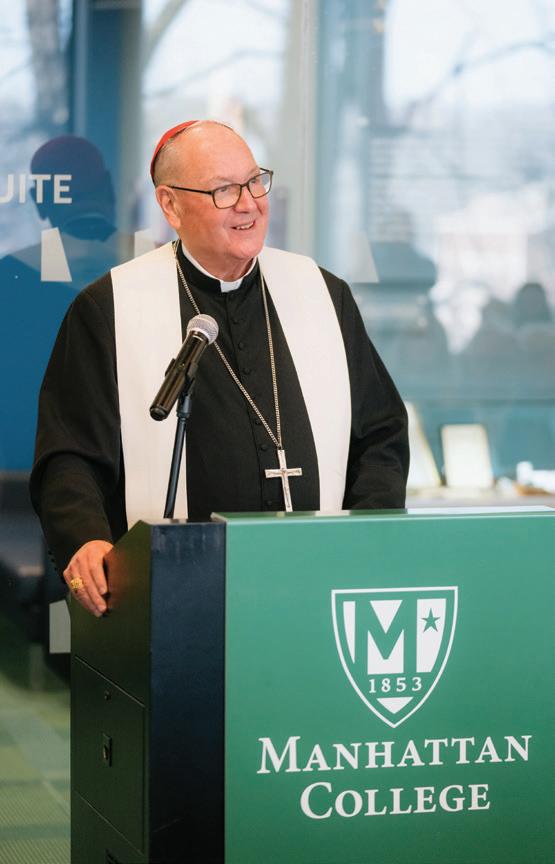
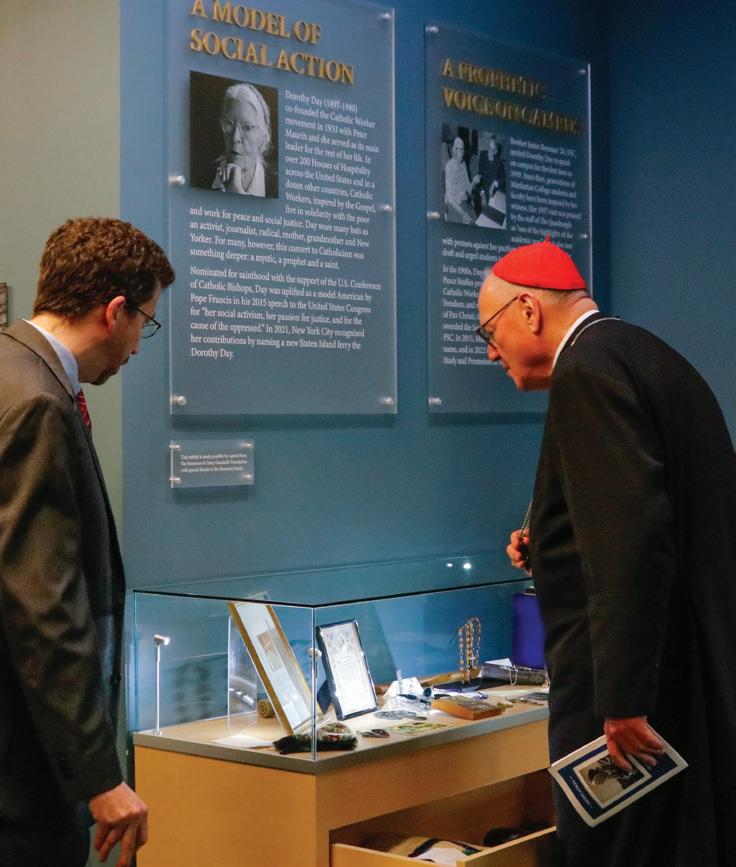
the presence of a very special person,” he said. “Dorothy told us we had to do more for the poor and not think only of ourselves.”
The archbishop of New York, Cardinal Timothy Dolan, delivered the opening prayer and Gospel reading, followed by remarks in which he noted that he had just visited Dominican sisters in the Bronx who devote their lives to prayer and service. “It symbolized for me the magic of the life of Dorothy Day,” he said. “Love of God and love of neighbor.”
“I’m particularly proud that our young people will be able to hear about her and come to know her,” he continued. “We’re working hard for the beatification and canonization. I don’t think Dorothy could care less! She doesn’t need it … but we need it. We need her example and intercession.”
Hennessy shared one of the many columns her grandmother wrote in the Catholic Worker. Entitled Love is the Measure, it read in part: “To accept the least place, to sit back, to ask nothing for ourselves, to serve each other, to lay down our lives for our brothers, this is the strange upside-down teaching of the Gospel.”
The ceremony was followed by a panel discussion featuring Manhattan College alumni who are walking in Day’s footsteps: Alannah Boyle ’18 and Rebecca Kranich ’24, former interns for the Dorothy Day Guild; Mark Colville ’85, founder of the Amistad Catholic Worker community in New Haven, Connecticut; and Thomas Dobbins ’86, director of justice and peace for Catholic Charities New York. Each attested to the impact Day has had on their work and interactions with others.
In response to the question of why a young person would be drawn to Day in the 21st century, Kranich responded: “She really reflects the energy that a lot of young people have in terms of wanting to change the world.”
MA nHATTA n .EDU N 3
(Left) Cardinal Timothy Dolan, archbishop of New York, delivers the opening prayer and Gospel reading in honor of the opening of the Dorothy Day Center for the Study and Promotion of Social Catholicism at Manhattan College. (Right) Kevin Ahern, professor of religious studies and director of the Center, and Cardinal Dolan peruse several of Dorothy Day’s personal items on display in the new space.

With a $3 Million Federal Grant, Manhattan Aims to Improve Outcomes for Hispanic Students
IN SPRING 2023, MANHATTAN WAS NAMED A HISPANICSERVING INSTITUTION (HSI) by the U.S. Department of Education. According to data collected by the Hispanic Association of Colleges and Universities (HACU), this makes Manhattan one of only 172 private colleges in the nation to be granted the HSI designation, reflecting the College’s ongoing commitment to serving a diverse population.
Throughout the past decade, Manhattan College’s Hispanic enrollment has climbed steadily. In fall 2013, 18.4% of the student population was Hispanic, and by fall 2022, Hispanic enrollment had grown to 28.5%. (To be recognized as an HSI, an institution’s enrollment of Hispanic students must reach at least 25%.)
With its new standing as an HSI, the College was eligible to apply for a Title V Developing Hispanic-Serving Institution Grant. These grants can provide funding for many different projects, including the development of new academic programs and courses and the expansion of student support services. There was only a matter of weeks from when the grant was announced until when the application was due, recalls Brendan Considine, director of grants administration.
“This particular grant is already kind of complicated, so it took a team effort to get everything together and submitted,” he says. Ultimately, Manhattan’s efforts came to fruition: The College was awarded a grant of $3 million over five years.
Andy Burns, Title V project director and executive director of advising, says that the HSI designation “gives institutions the ability to start programs, initiatives or structures. They’re going to really improve the outcomes for Hispanic and other underrepresented students. So, to that end, the institution then needs to understand where the gaps are that can be addressed, that are going to benefit this student population to the highest degree.”
Grant funds must be used for new initiatives, not existing ones, Burns explains. Three areas that Manhattan College intends to focus on are centralized advising, professional development for faculty and staff, and improving resources. “We want to really influence the student satisfaction and retention of Hispanic and other underrepresented student groups,” he says.
The switch to centralized advising has already been made, with academic advisement services now consolidated and located together in Thomas Hall, rather than spread among the three academic schools.
“We wanted to bring that into one physical location, working under the same umbrella,” Burns says. “So the policies and procedures are all uniform, and the students are all receiving the same experience.”
In addition, the College is working with groups like NACADA, the Global Community for Academic Advising, to set up opportunities for faculty advisers to attend conferences, and the Association of College and University Educators (ACUE) to provide professional development for faculty working directly with students in the classroom, targeting mathematics and English courses with a high DFW rate (the
percentage of students who receive a D, an F or withdraw).
Lastly, Manhattan is exploring several ways to provide students with greater resources. These include a laptop borrowing program, and dedicated spaces on campus for commuter students, of which a substantial proportion are Hispanic.
There are many advantages to achieving HSI status that are beneficial to the entire campus community. Latino students at Hispanic-Serving Institutions generally have higher graduation rates than Latino students at non-HSIs, according to a December 2017 report from The Education Trust, a nonprofit organization that advocates for low-income students.
Considine and Burns agree that by next year, there should be substantive outcomes as a result of the HSI designation and grant award. At that point, the College will be able to study the data and determine how well these interventions are impacting retention and education of Hispanic students.
“There’s an equity factor here,” Burns adds. “We want all students to receive the same experience regardless of race, ethnicity or income.”

As a Hispanic-Serving Institution, Manhattan can now access federal grants through the Developing Hispanic-Serving Institutions Program. Funds may be used for purposes including scientific or lab equipment, tutoring or counseling programs, distance-learning instruction, and teacher education.
ON CAMPUS 4 N spring 2024
Student Commons Receives LEED Gold Certification for the Second Time
THE RAYMOND W. KELLY ’63 STUDENT COMMONS received the LEED (Leadership in Energy and Environmental Design) gold operations and maintenance (O+M) certification, which is awarded to already constructed buildings that are operated and managed in a sustainable manner. This is the second time the building has achieved LEED gold certification. In 2015, the Kelly Commons was granted gold status in building design and construction (BD+C).
LEED is recognized around the world as the premier mark of achievement in the design, construction and operation of green buildings. Obtaining gold-level status is the next-to-last step toward achieving the ultimate level of platinum certification in the green buildings rating system.
“The LEED system provides a framework for healthy, efficient, carbon and cost-saving green buildings,” says Richard Ross, director of Graduate Recruitment Programs and visiting instructor of real estate in the O’Malley School of Business. “It is widely recognized as the industry standard for green buildings in the United States and used in over 160 countries worldwide.”
Ross said that the Kelly Commons certification “shows our students, our stakeholders and the world that Manhattan College cares about our planet and reducing our contribution to global warming.”
During the spring 2023 semester, Ross and the students in his LEED Lab class used data and other information provided by the facilities department that helped the College achieve the new
certification. Students in the lab toured Kelly Commons and took detailed notes about its characteristics and equipment. They identified areas where the building complied with LEED standards and in the areas where it fell short. They also made recommendations to make the building more sustainable and to comply with LEED requirements.
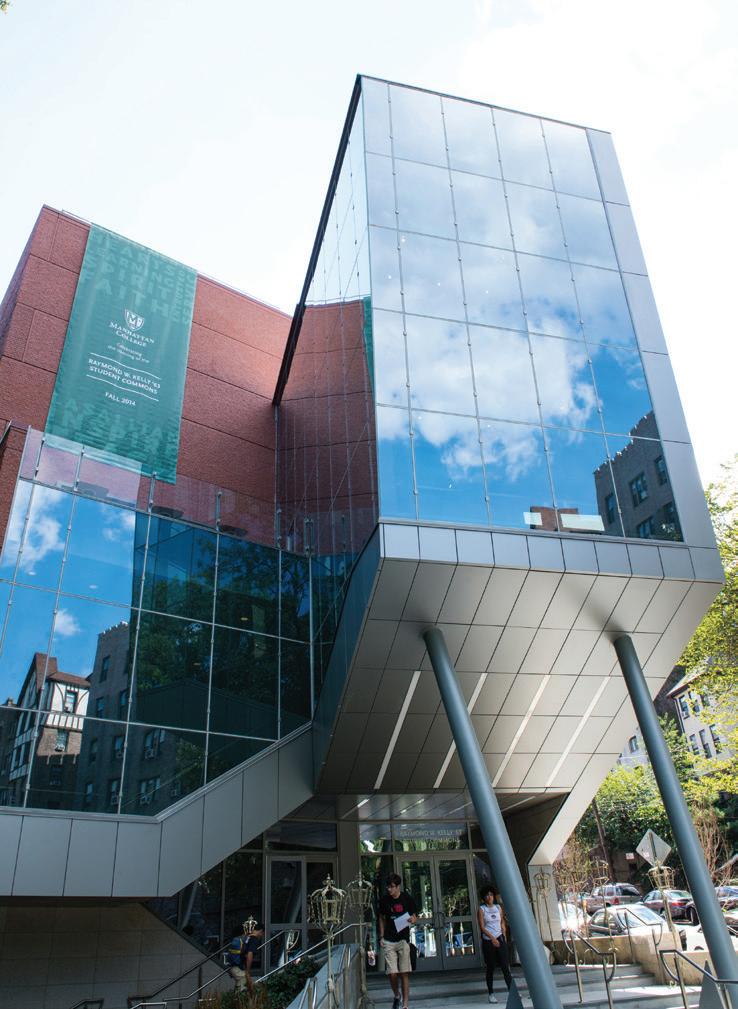
This spring, the real estate program and LEED Lab will continue working on earning new certifications and will focus on achieving LEED gold O+M status for the Patricia and Cornelius J. Higgins ’62 Engineering and Science Center. Shortly after the Higgins Center opened in 2021, it received LEED gold in BD+C.
Earning LEED ratings are part of the College’s Strategic Plan for 2020-2025. Ross explained that a key priority is for the College “to continue to improve existing facilities and infrastructure and strategically develop new facilities with an emphasis on sustainability and efficiency.”
College Gets Grant to Improve Campus Networking Infrastructure
MANHATTAN COLLEGE RECEIVED A $639,778 GRANT from the National Science Foundation’s (NSF) Campus Cyberinfrastructure program. The grant is the largest NSF grant that the College has ever received and will be used to improve Manhattan’s campus networking infrastructure, which will enable and advance research across multiple disciplines.
The grant funds a two-year project entitled CC Networking Infrastructure: Improving Science Data Flows with Advanced Networking and Cyberinfrastructure, and allows for a reconfiguring of the campus network to create something more efficient and reliable — one that can better support the needs of faculty, researchers and students.
The new network will be designed to improve the flow of scientific data, which will facilitate research in a variety of disciplines.
Funding for the network includes the purchase of new routing infrastructure and switches that will be used to construct a Science DMZ, a network component that allows scientific data to flow in and out of the campus unimpeded by firewalls and other enterprise network bottlenecks.
The project also funds the design, implementation and purchase of specially built data transfer nodes connected to the Science DMZ that will be used to help move massive amounts of data between the College’s researchers and their collaborators. The project will provide them a connection to
local, state and national research networks such as NYSERNet and Internet2, providing the community unprecedented access to scientific research networks. These networks are part of the interconnected fabric of the nation’s leading research and education networks, which includes the Department of Energy’s Energy Sciences Network.
These new and improved capabilities are expected to be transformational for research and education efforts, providing faculty and students with access to resources typically only available at large research institutions.
“The benefit of the grant is wide-reaching and heavily interdisciplinary,” says Wyatt Madej, systems administrator. “This is for everyone.”
MA nHATTA n .EDU N 5

College Restructures Schools to Enhance Student Experience
MANHATTAN COLLEGE HAS RESTRUCTURED ITS SIX SCHOOLS into three to better position its students to acquire career-ready skills while building on the supportive, highquality academic experience provided by its distinguished faculty. The resulting schools are the Kakos School of Arts and Sciences, the O’Malley School of Business, and the School of Engineering. The education and health programs, as well as the School of Continuing and Professional Studies, will be integrated into the Kakos School of Arts and Sciences. Each school is committed to providing a smooth transition for its students, while offering a campus environment that is encouraging and caring.
“I am committed to excellence in education, and as a Manhattan College graduate myself, I well appreciate the supportive academic experiences that our superior faculty offer, as well as the professional connections offered by our extensive alumni network,” says Milo Riverso ’81, president of Manhattan College. “The three schools will provide laser-focus emphasis on top-tier education to our entire student body — whether the student’s primary major be one of the arts, the sciences, engineering or business.”
Rani Roy, the College’s interim provost, adds: “The three-school structure will allow us to enhance our students’ academic experiences by concentrating interconnected areas of study within a given school. This affords our students both depth and breadth of choices while preparing them for a world beyond Manhattan College that is filled with both challenges and opportunities.”
Marcy Kelly has been appointed as dean of the Kakos School of Arts and Sciences. Kelly joined Manhattan College in 2022 as dean of the Kakos School of Science, and previously served as the department
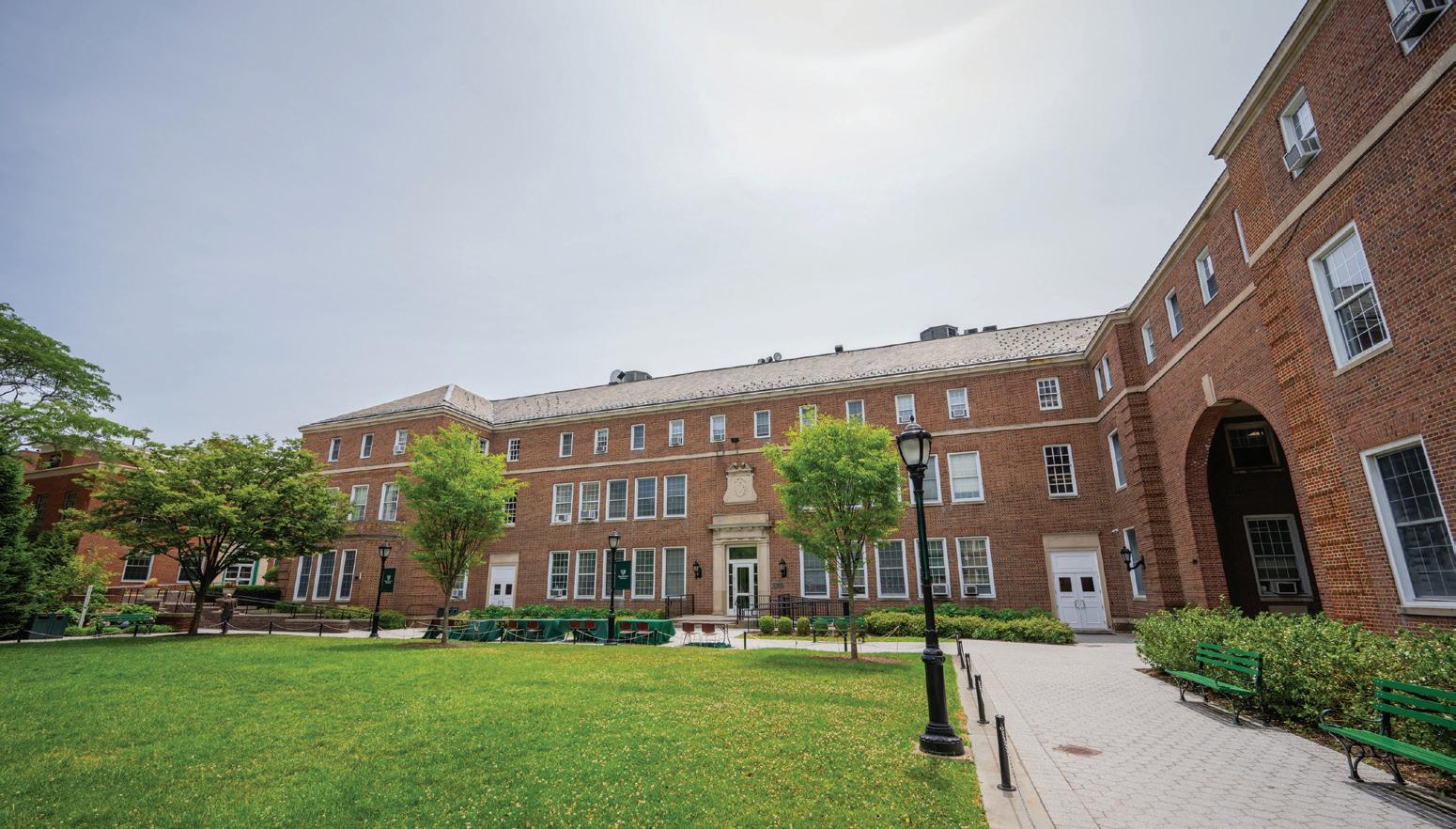
chair and professor of biology at Pace University’s Dyson College of Arts and Sciences. At Manhattan, she has prioritized undergraduate research, including a focus on the Jasper Summer Scholars Program; co-created the First Year Experience course, which advises students using a holistic, strategic caseload management model; developed the Teaching and Learning Ambassador’s Workshop and Residency program to engage faculty in best practices of teaching and learning science, technology, engineering and mathematics (STEM); and assisted in creating a major in Game Design and Production.
“I am honored to continue the work in building a community of scholars and augmenting the student experience in teaching and learning,” Kelly says. “To guide our trajectory, we will work collaboratively to create a unified vision for this new school. In keeping with the Manhattan College tradition in all our schools, the new Kakos School of Arts and Sciences will maintain a student-centered approach to education.”
She continues: “The Kakos School of
Arts and Sciences will provide students with a unique opportunity to scaffold their disciplinary passions within a framework of the humanities, arts, natural sciences, social sciences and mathematics. This will help students broaden their critical thinking skills, creative inquiry skills, and social and cultural awareness.”
Kelly received her bachelor’s degree in biological sciences from the University of Buffalo, and her Ph.D. in microbiology and molecular genetics from the University of Medicine and Dentistry of New Jersey.
In addition, Bridget Chalk, professor of English, will serve as associate dean of the Kakos School of Arts and Sciences. A respected scholar in the field of 20th- and 21st-century British and Anglophone literature, Chalk has been a cornerstone of the English department since 2009. Read more about the restructuring and new program alignments in the fall issue.
ON CAMPUS 6 N spring 2024
Physics and Astronomy Department Takes the Top Spot for Journal Articles
THE MEMBERS OF THE PHYSICS AND ASTRONOMY DEPARTMENT have cause for celebration: the work of their fellow faculty and students has produced the most journal articles in the country. According to Scopus, the abstract and citation database for scientific literature, the department came in at the top spot for publications in the past decade under the High Energy Physics and Astrophysics category. That rank places them first among 486 undergraduate colleges within the United States, with a total of 898 articles. The large volume of articles published has led to 150,000 citations. Select Manhattan College articles, among those leading in citations, have been featured in publications such as the peer-reviewed journal Physics Review Letters
What’s the secret to such a high number of successful journal publications? Simply put, “We love science,” says Rostislav Konoplich, current chair and professor of physics.
He considers the students and faculty to be a proactive bunch, citing their eagerness to participate in the latest research and expand their knowledge within their discipline.
The department’s research has intersected with many major projects and publications within the fields of physics and astronomy. Konoplich shared that they had a hand in research involving the Higgs boson, a major aspect of quantum particle physics theory. He and a cohort of his students are also members of the ATLAS Collaboration, which experimented with and researched the Large Hadron Collider (LHC) located in Switzerland.
“A lot of our publications [come from our] participation in this LHC experiment, a huge machine in Switzerland to accelerate particles. It’s considered the most complicated machine humans have ever built,” he explains. “We get many references from that experiment.”
These research discoveries were cited when the theorists François Englert and Peter W. Higgs received the Nobel Prize in Physics in 2013.

Their predictions were confirmed by the ATLAS and Compact Muon Solenoid (CMS) experiments at the European Organization for Nuclear Research (also known as CERN) LHC.
The opportunities provided by the ATLAS Collaboration have continued to be fruitful. Prior to the COVID-19 pandemic, Konoplich and students of the department traveled to Switzerland to participate in ongoing research. While they hope to return to Switzerland soon, the partnership with CERN has allowed for important networking opportunities in the United States, as well.
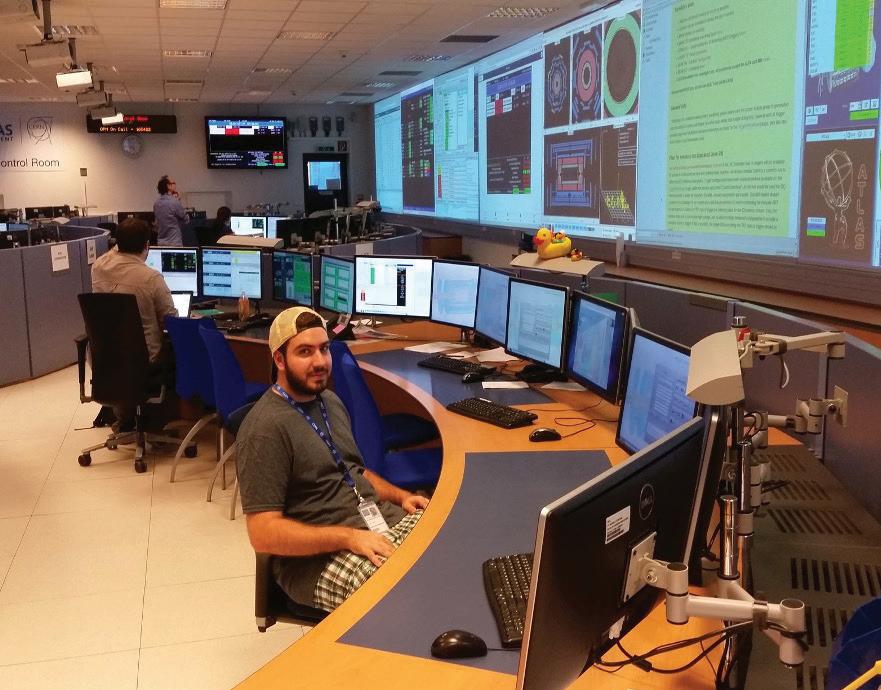
“When you are a student at Manhattan College, you know we have very good faculty,” Konoplich says. “With CERN, you can communicate with additional professors from around the world, those that are also the best in this field.”
These ongoing research collaborations between the faculty and students, along with a desire for a better understanding of the world, have led the department to the top of the leader board. Whatever the next decade brings in the field, there is no doubt that the department will strive for excellence, as Jaspers are apt to do.
Marking 50 Years of the Christian Brothers Center on Campus
FIFTY YEARS AGO, THE MANHATTAN COLLEGE COMMUNITY CELEBRATED the completion of the Christian Brothers’ Center, the first permanent residence built for the Brothers. After decades of living on the top floors of primarily academic buildings surrounding the Quadrangle, the Brothers supported moving off campus and building a modern community house that would also serve the needs of their retired brethren. A piece of property located on the northeast tip of the campus at Post Road was determined as the best location to construct the center, a five-story structure that provided a chapel, dining room, meeting facilities and permanent residence for 30 Brothers. To honor the Brothers, Manhattan College alumni not only made financial contributions but also donated their time and expertise in construction, architecture and engineering to help erect the building. The Christian Brothers Center was completed in 1974.
MA nHATTA n .EDU N 7
Physics major Dylan Gray ’16 gains hands-on experience working in the ATLAS control room. ATLAS is a collaboration of physicists, engineers, technicians, students and staff from around the world working with research teams at CERN in Switzerland.

Squeri Hall Officially Dedicated in Honor of Legacy Family
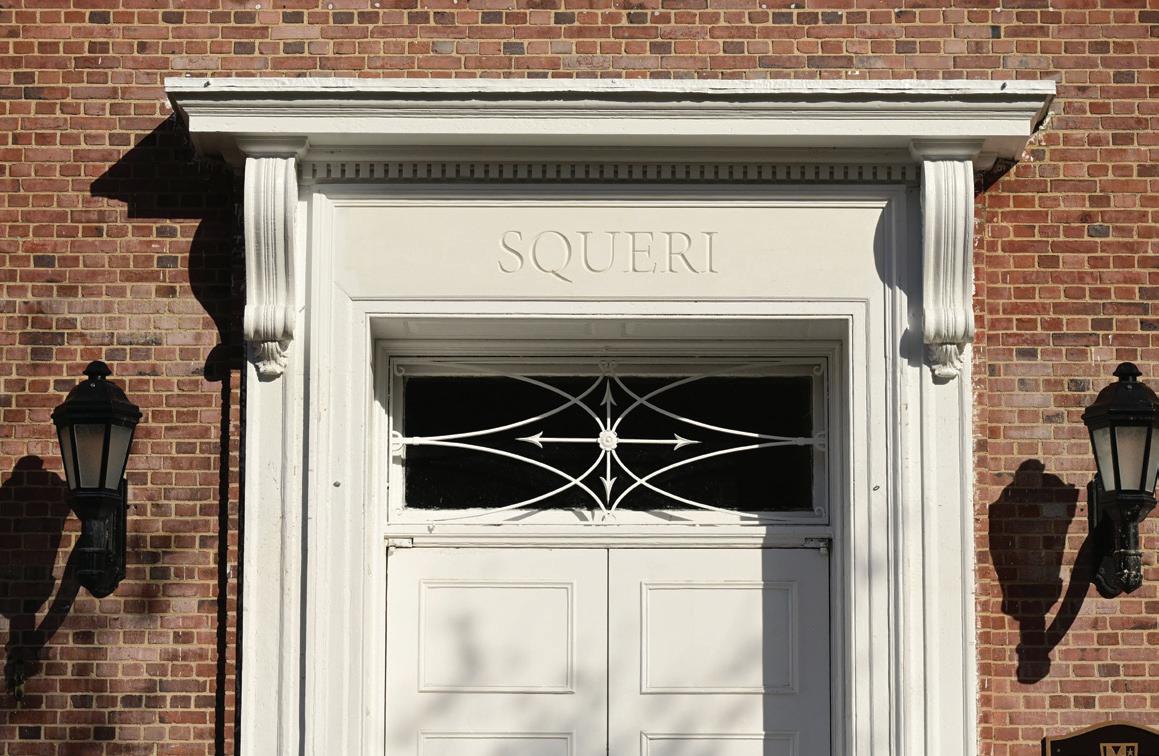

SMITH AUDITORIUM AND THE CHAPEL OF DE LA SALLE AND HIS BROTHERS are officially part of Squeri Hall, which was formally dedicated in December. The building was renamed in recognition of a $10 million gift to Manhattan made by Stephen Squeri ’81, ’86 (MBA) and in honor of the Squeri family’s longstanding generosity to the College. Squeri is chairman and chief executive officer of American Express and chair of the Manhattan College Board of Trustees. He has deep Jasper roots going back to his father, Joseph Squeri ’54, who earned a bachelor’s degree in business management. Stephen Squeri’s generous gift was made in 2021 and supports enhancing facilities and infrastructure.
“This is a very special moment for me, my brothers and my entire family,” Squeri said at the dedication ceremony. “But it is even more of a special moment for all those members of the Squeri family who are no longer with us: my grandfather, my grandmother, my aunts and uncles, and my parents because they made the sacrifice, they made the investment, and they instilled the values in me that made this day possible.”
Squeri told the story of his grandfather immigrating to America and the sacrifices his parents made to educate him and his siblings.
“As my journey continued, I ultimately found myself at American Express, where I can see Ellis Island from my office, which is where my family’s journey began in America, bringing the Squeri family journey full circle,” Squeri said. “It would have been unimaginable to my grandfather that his entry through Ellis Island in 1907 set in place a series of events that his grandson would one day be the chairman and CEO of something called American Express. When there are tough days at work, I find myself looking out at Ellis Island.”
Calling Squeri Hall “the geographic and spiritual heart of our campus,” President Milo Riverso ’81 said, “In the many decades ahead, new generations of young Jaspers also will make use of our auditorium and worship in the venerable chapel above us.”
He described the need to care for this integral part of campus, which had been weathered by time. The Squeri gift supported recent structural renovations to enhance and restore its iconic architectural features, including the cupola. “And we continue to restore the rest of the building to its original splendor, in many ways making it even better,” Riverso said.
“Let us join once again in expressing our gratitude to the Squeri family for giving this historic edifice back to us — and for all that they continue to do on our College’s behalf,” Riverso continued. “At the same time, may we always reflect upon how very much Squeri Hall means to us — and to all of those who will follow.”
Squeri summarized his feelings — as well as for many of those in attendance — about the day as he closed his speech.
“I hope that the students here today, and for generations to come, will continue to be shaped by the same values and principles my parents and Manhattan College instilled in me. If you work hard and value education, that will bring success,” he said. “I know my grandfather and my father would be proud to know there is now another marker that says the Squeri family was on this earth, and that the name Squeri will be a part of the future of this great college forever.”
8 N spring 2024 ON CAMPUS
Recognizing the Squeri family’s longstanding generosity to the College, Manhattan College renames the building that houses Smith Auditorium and the Chapel of De La Salle and His Brothers as Squeri Hall. (From left to right) Thomas Mauriello, senior vice president for college advancement, President Milo Riverso ’81, Stephen Squeri ’81, ’86 (MBA) and Brother Daniel Gardner, FSC, executive director of Campus Ministry and Social Action, at a special gathering to celebrate the dedication.
College Receives NSF Grant Focused on STEM Teaching and Learning
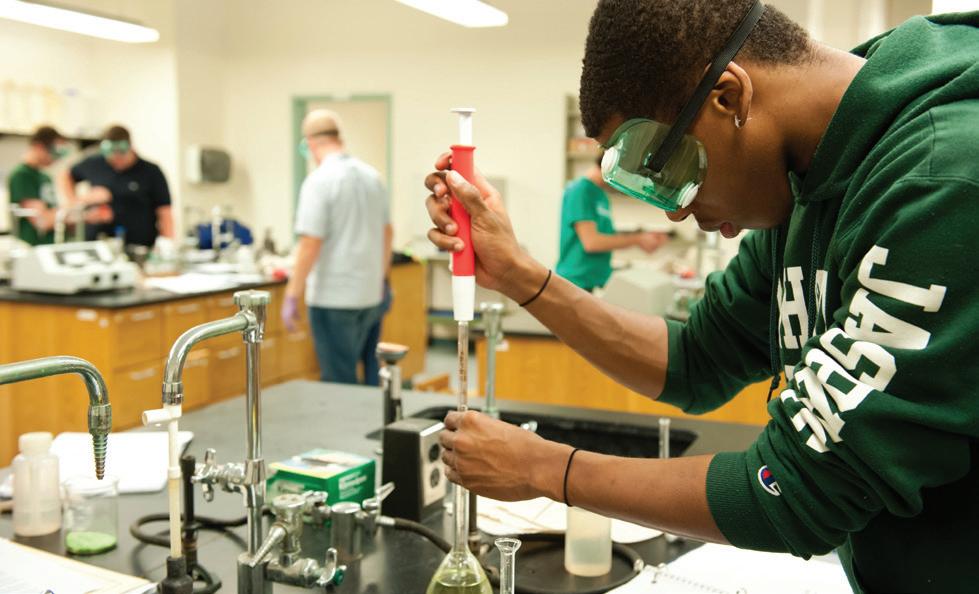
MANHATTAN COLLEGE HAS RECEIVED a National Science Foundation (NSF) grant for the establishment of a STEM Teaching and Learning Excellence Center.
The Center will support supplemental instruction in introductory biology, chemistry and physics courses; the Teaching and Learning Ambassador’s Workshop and Residency Program — a weeklong workshop on the best teaching practices coupled with a yearlong professional development residency; and the first-year experience course, SCI 100, which includes stipends for faculty to work with firstyear students as they transition to college.
“As professors advance during their careers, there must be a simultaneous focus on enhancing their teaching skills and their abilities to impart knowledge to all students within their classes,” says Marcy Kelly, dean of the Kakos School of Arts and Sciences. “The NSF grant, through the establishment of the Teaching and Learning Center, will embrace conversations on scholarly teaching methods; spotlight support on the best ways to teach first-year students in science, particularly those students from underresourced high schools; and build a strong feeling of community among science students from diverse backgrounds.”
As a lead-up to receiving the NSF grant, a group of science professors focused on and developed best teaching practices to ensure that course content was understood by all students. The students in those classes excelled, performed better on exams, and generally had a more indepth appreciation for the overall course content. The grant will enable the continuation of this trend in other science classes. Faculty will receive a stipend for teaching STEM gateway courses taken during the first two years, which typically have the highest failure rate among students; develop a primer for supplemental instruction in which upper-class students will be given the opportunity to assist professors by peer tutoring; and have research opportunities that focus on support for first-year science students.
Physics Chapter is Outstanding

THE MANHATTAN COLLEGE SOCIETY OF PHYSICS STUDENTS received a 2022-2023 Outstanding Chapter Award from the Society of Physics Students (SPS) National. The chapter was recognized for its “dedication and commitment to the SPS mission and vision.” Only 10% to 15% of student physics society chapters are able to attain the Outstanding Chapter Award each year. This is the second time that Manhattan students have received the honor in the past four years.
The awards are presented annually and are based on criteria that includes participation in SPS programs, outreach efforts to grades K-12 or the general public, participation in community service, and contributions to student recruitment and retention.
“We are thrilled to have our students’ hard work over the past year recognized by SPS National, and we hope this will inspire more students in STEM at Manhattan College,” says Bart Horn, associate professor of physics and the group’s faculty adviser since 2018.
Horn said that the Society of Physics Students and its related honor society, Sigma Pi Sigma, serve as a social hub and informal advising network for students interested in physics, astronomy and related fields.
Some of the organization’s accomplishments that led to the award included Manhattan College’s first annual STEM Outreach Day. Thirty-six Bronx students from grades six through 12 were invited to a daylong event where they participated in experiments covering engineering, math, biology, chemistry, physics and computer science. The event was organized by the society’s co-president, Sarah Rosen ’23, and mathematics major Kate Cappabianca ’23. For their efforts, Rosen and Cappabianca were named New Yorkers of the Week by Spectrum NY1 News, and featured in an on-air interview with the station.
In addition, Lara Celik ’25 and Johely Aguilar ’25 developed and organized an activity to build working batteries using potatoes. Rebecca Coglianese ’24, Anthony Rizzo ’24, Sarah Rosen ’23, Shaib Sharhan ’24, Bhavya Mishra ’25 and David Muqattash ’25 also conducted research with faculty and presented it at the annual Student Research Symposium.
“I am incredibly proud of our Society of Physics Students for receiving this prestigious recognition,” says Marcy Kelly, dean of the Kakos School of Arts and Sciences. “Their exceptional work shows the depth and breadth of talent in our STEM programs, and their commitment to outreach is truly commendable.”
MA nHATTA n .EDU N 5
n .EDU N 9

Newest Epsilon Sigma Pi Members
Inducted
at Fall Honors Convocation
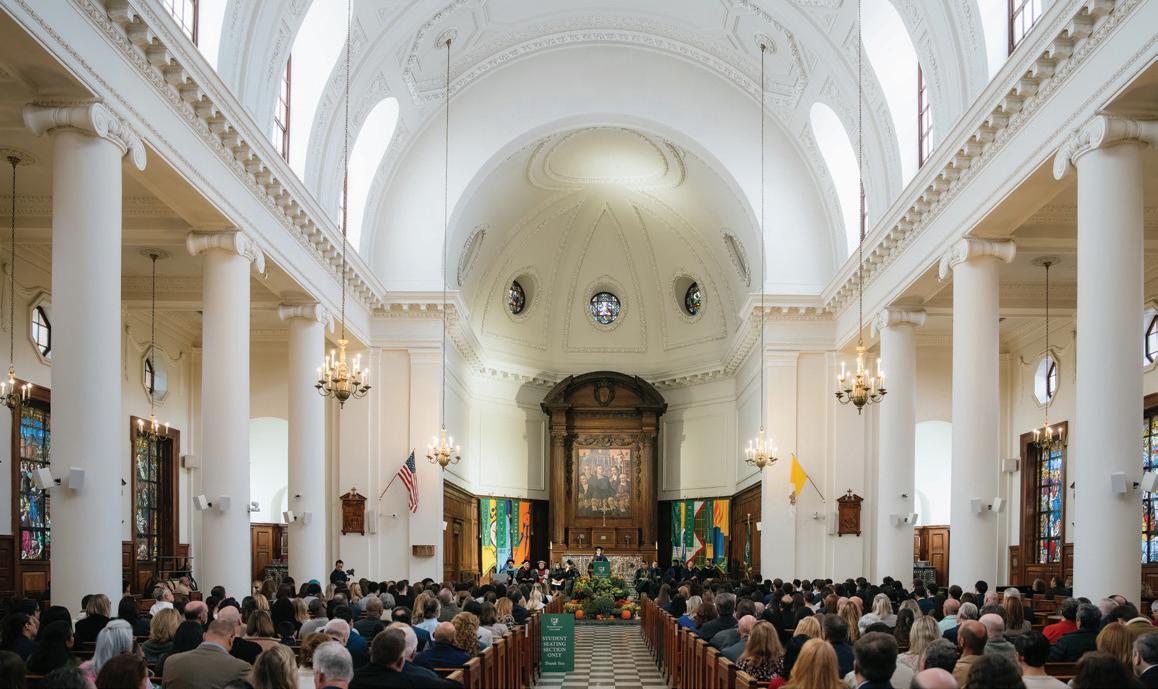
THE CHAPEL OF DE LA SALLE AND HIS BROTHERS was the setting for one of Manhattan College’s most hallowed and enduring traditions: Fall Honors Convocation. The October ceremony brought students, faculty, parents and friends together to celebrate the accomplishments of 134 high-achieving students as they were inducted into the College’s exclusive honor society, Epsilon Sigma Pi (ESP).
Membership in ESP is the highest academic honor that a Manhattan College student can attain, engaging its members to promote and foster cultural and intellectual pursuits by their example and activities on campus. Each member is expected to develop in scholarship by undertaking a program of independent study.
“After three years of hard work and long hours studying, I was very glad to have gotten inducted into Epsilon Sigma Pi,” said Kevin McGoldrick ’24, who will receive an accounting degree in May. “Everything that the class of 2024 had worked on lead to this very event.”
The Convocation began with a faculty address by Sarah Wacker, assistant professor of chemistry and biochemistry. She received her B.S. in biochemistry and molecular biology from the University of Richmond and her Ph.D. from The Rockefeller University, and conducted postdoctoral studies at Harvard University. Wacker has mentored more than 20 students in independent research projects. Her research on how bacterial communities form and the role of protein interactions in this process has received funding from the National Institutes of Health, and she has been named a faculty fellow of the Michael J. and Aimee Rusinko Kakos Endowed Chair in Science.
Wacker’s remarks centered on three traits that she believes play an integral role for a successful life: talent, hard work and “the oftenoverlooked quality of kindness, which includes giving back to our communities,” she said. She shared her experiences of pursuing her interest in theater before realizing that her strengths are in the sciences.
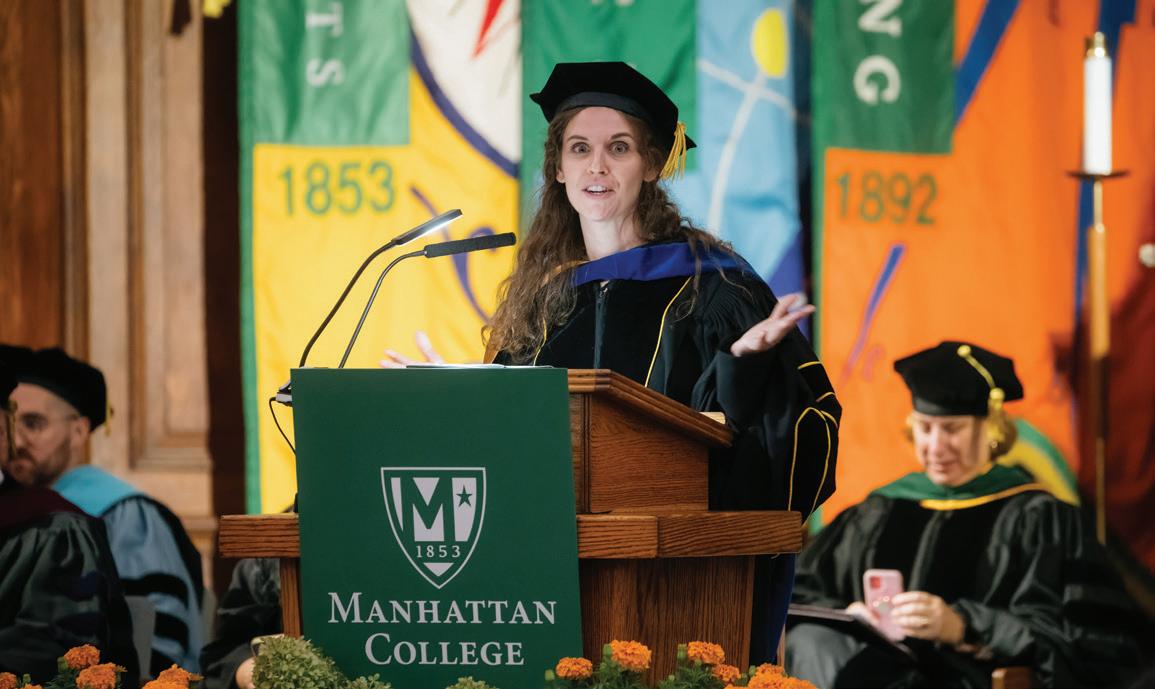
“We can’t control natural talent, just like we can’t dictate luck, but we can choose whether or not to nurture our talents,” she said. “One only has certain talents and recognizing them is an important step to figuring out what path you should be on.” Wacker then gave her perspective on hard work, noting that hacks and streamlining processes may help, “but these tools will not negate the need for hours of practice, of study, of trial and error.”
The new inductees then received their Epsilon Sigma Pi Honor Society certificates and keys from President Milo Riverso ’81, and Interim Provost Rani Roy, who serves as moderator for ESP. Before the ceremony’s conclusion, Riverso delivered congratulatory remarks. He began by calling to mind his own experience as an Epsilon Sigma Pi inductee.
“It seems not so long ago — well, to me at least — that I was sitting where you are right now, during the October 1980 Fall Honors Convocation,” he said. “Standing before you today brings back a rush of memories of my time as a student in this great institution, and brings full circle the ability that you each have to nurture your own potential to achieve that which you most desire in life.” He noted that, by accepting induction into Epsilon Sigma Pi, students are choosing to use their gifts and talents to make the world “more peaceful, more sustainable, and more just.”
Most of McGoldrick’s family was back home in Louisiana and unable to attend the ceremony, but he reported that they were happy to see the large certificate when he spoke to them on a video call.
“The Convocation event was great,” he said. “I saw many friends from the same major and from the last three years receiving this great honor, too. I enjoyed the community aspect of having all the schools there in person together. People that I had spent hours with — whether it was in the library or working on schoolwork and tests — brought us to here in our senior year.”
ON CAMPUS 10 N spring 2024
Sarah Wacker, assistant professor of chemistry and biochemistry, delivers the faculty address at the 2023 Fall Honors Convocation, which honors students inducted into Epsilon Sigma Pi.
Two New Trustees Join the Board
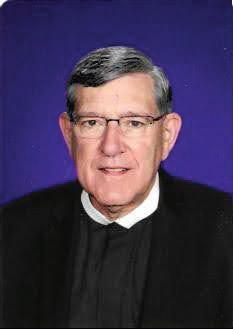

BROTHER DENNIS LEE, FSC, AND BROTHER THOMAS ZOPPO ’85 (M.S.), FSC, are the newest members of the College’s board of trustees.
A Christian Brother for more than 50 years, Brother Dennis is the project director for the establishment of La Salle College of Education, Science and Technology in Nairobi, Kenya. He has dedicated more than 40 years to education, serving as an elementary school and high school religion teacher, campus minister and missionary.
For the past 20 years, he has enjoyed four stints as a missionary at Christ the Teacher Institute for Education, also in Kenya. In between those stints, he has served in leadership for the legacy Long Island-New England District and for the District of Eastern North America of the Brothers of the Christian Schools.
From 1998 to 2002, Brother Dennis served as the director of Campus Ministry and Social Action at Manhattan College.
A native of Queens, New York, Brother Dennis earned a bachelor’s degree in sociology and a master’s degree in education from Fordham University, and a master’s in catechetical ministry from St. John’s University in Queens. He also has an honorary doctorate in humane letters from Manhattan, presented at its 2021 Commencement.
“I have a special place in my heart for the College and look forward to helping to shape its legacy in the future,” Brother Dennis says.
Brother Thomas has been a De La Salle Christian Brother since 1979 and has dedicated more than 40 years to education as a school administrator and mentor. From 2013 to 2019, he was principal and head of school at Bishop Fenwick High School in Peabody, Massachusetts, a 600-student diocesan preparatory school. Most recently, as president of Cardinal Newman High School in West Palm Beach, Florida, he oversaw a 27% increase in enrollment and raised more than $10.5 million for capital improvements. For six years, he was an academic adviser in the School of Engineering at Manhattan College.
In 2015, Cardinal Sean Patrick O’Malley, archbishop of the Archdiocese of Boston, presented Brother Thomas with the Cheverus Medal for his distinguished service to the Church. He also was awarded a Legacy Honorary Alumni Award from Cardinal Newman High School.
Originally from Massachusetts, Brother Thomas earned his undergraduate degree in business administration from Villanova University and a master’s in school administration and professional diploma in administration from Manhattan College. Additional advanced studies were completed at Boston College and the University of Notre Dame.
“It is a particular privilege to contribute to a mission and vision that I believe in so strongly,” Brother Thomas says.
(From top to bottom) Brother Thomas Zoppo ’ 85, FSC, and Brother Dennis Lee, FSC.
College Can Claim One of the World’s Top Scientists

GEORGE GIAKOS, PROFESSOR OF ELECTRICAL AND COMPUTER ENGINEERING, has been selected as one of the world’s top industry scientists by the Artificial Intelligence Infrastructure Alliance (AIIA). The designation is given to scholars and scientists whom the organization believes can contribute toward the growth and dissemination of artificial intelligence (AI) principles within the industry.
As a member of this alliance, Giakos will promote the practical applications of AI across various industries, fostering economic development and societal progress and facilitating industry connections.
“I am incredibly honored to be named one of the world’s top industry scientists by the AIIA,” Giakos says. “This recognition is a testament to the hard work and dedication of my research team, colleagues and students at Manhattan College. We are constantly striving to push the boundaries of artificial intelligence and its applications, and I am excited to continue working alongside such a talented group of individuals.”
Selected for his research in and contributions to the field, Giakos’ research interests are primarily in technology innovation, through the integration of physics, engineering and AI. He has more than 20 U.S. and foreign patents and has published 350 peer reviewed papers. He also is the founding director of the Laboratory of Quantum Cognitive Imaging and Neuromorphic Engineering and Bioinspired Space Systems.
Since 2000, Giakos has conducted research at prestigious U.S. national laboratories and for NASA, the Air Force Research Laboratory, the Office of Naval Research and Lockheed Martin on the development and advancement of polarimetric imaging systems. Polarimetric imaging systems can capture hidden details and information that ordinary cameras miss and can be used for many applications, including medical imaging, environmental monitoring and art restoration.
In addition, Giakos and his Manhattan College students pioneered an artificial intelligence vision sensor technology called “Polarimetric Dynamic Vision Sensor p(DVS)s,” blending neuromorphic processors (types of computer chips modeled on the structure and function of the brain) with polarimetric principles (based on the understanding and manipulating the polarization of light) that can process visual information in a way that is similar to the human optical system.
Established in 2023, the AIIA brings together scholars, scientists, government agencies and universities that are engaged in technology, research and development, applications, scientific education, consulting and investment and financing in the field of artificial intelligence.
MA nHATTA n .EDU N 11

Team Jasper Named a Regional Finalist in College Fed Challenge


Manhattan College’s Federal Reserve Challenge team analyzed economic and financial conditions and formulated monetary policy recommendations, modeling the Federal Open Market Committee, and nabbed a regional finalist recognition.
THE MANHATTAN COLLEGE FEDERAL RESERVE CHALLENGE TEAM
WAS NAMED A REGIONAL FINALIST in the prestigious College Fed Challenge, a national competition that tests students’ understanding of economic and financial conditions. The College Fed Challenge requires students to formulate a monetary policy recommendation to a panel of judges who work at the Federal Reserve Bank of New York. This recognition marks a significant achievement for the team and highlights the exceptional academic environment fostered by the O’Malley School of Business.
“Achieving recognition as a regional finalist for the Federal Reserve Challenge is a true honor for Manhattan College and the O’Malley School of Business,” says Donald Gibson, dean of the O’Malley School of Business. “This program demonstrates the strong relationship we foster between our faculty and students. With Dr. Hany Guirguis’ great guidance, our student team worked tirelessly to present a sophisticated model of the macroeconomic forces facing the Fed.”
The 2023 team was composed of five student presenters — Rehan Mehta ’24 (economics and mathematics), Theresa Donlon ’24 (accounting), Giovanni Casonato ’24 (economics), Clay Pinkham ’26 (economics and finance) and Cara Loganadhan ’26 (finance and global business) — who impressed the judges with their in-depth analysis of the current economic landscape and well-articulated recommendations for monetary policy.
The team’s journey began with a meticulously crafted 15-minute presentation that they submitted to the Federal Reserve in early October and earned them a coveted spot among the top 18 teams out of more than 100 competing colleges nationwide. In November, they advanced to the semifinals, where they showcased their knowledge and critical thinking skills in a rigorous Q&A session with senior Federal Reserve officials. Unfortunately, the team did not advance
beyond the semifinals, despite a compelling performance against multiple Ivy League universities.
“The 2023 Fed Challenge was a fantastic experience that allowed us to dive deep into macroeconomic analysis beyond the classroom,” says Guirguis, professor of economics and finance and the team’s adviser.
“I’m incredibly proud of our team for working long and hard behind the scenes to deliver a concise and data-driven thesis. Our five governors gave a compelling presentation that brought us to the semifinals for the first time in seven years. Aggregating data and meeting four to six days per week for months were a testament to the team’s determination to succeed in this highly competitive competition.”
The team’s dedication and hard work were evident in their preparation process. They began meeting last summer and devoted countless hours to refining their presentation. The month before the challenge, the group met every day for at least three or four hours. During the week of the challenge, the group devoted themselves entirely to improving their presentation, with every meeting running more than eight hours a day.
“The Federal Reserve Challenge has helped us understand the economy and economics in a way that will benefit us throughout our lives, whether making investments or out on a job search,” Mehta says. “We’ve met with people from the Federal Reserve, and the networking opportunities are amazing.”
“The primary goal of the challenge is to allow undergraduate students to gain real-life experience in researching economic factors and understanding monetary policy,” Loganadhan says. “I’ve learned so much.”
Building on this year’s momentum, the team is already gearing up for next year’s competition with renewed enthusiasm and a strong sense of purpose.
ON CAMPUS 12 N spring 2024
Saran Camara ’21 Earns Distinction as First Payne Fellow from Manhattan College
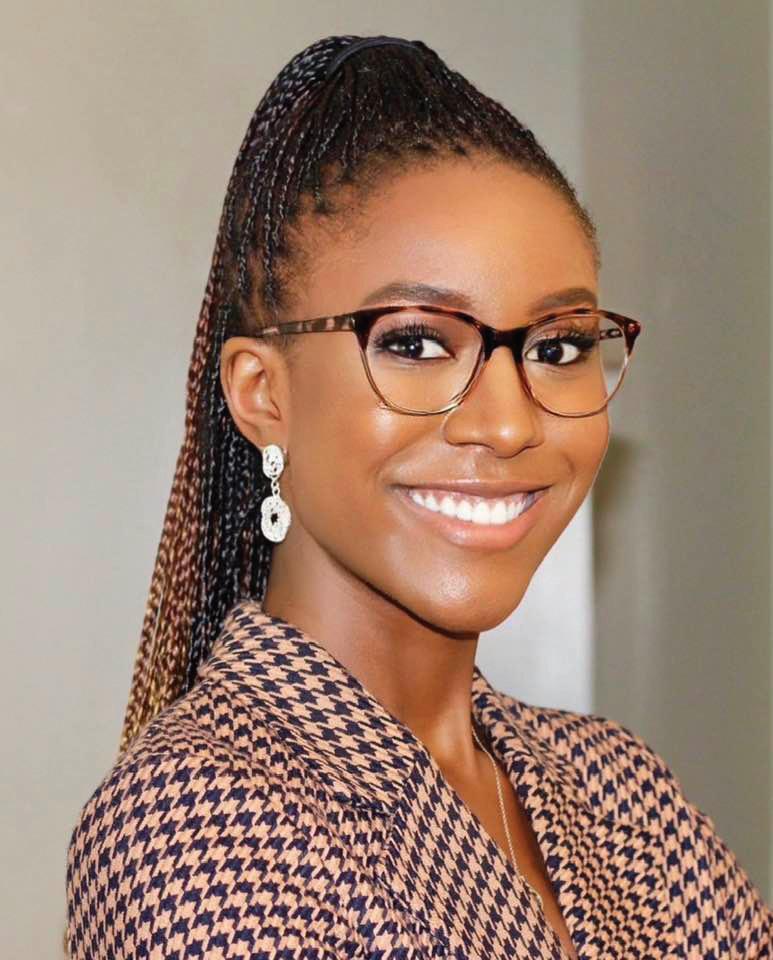
SARAN CAMARA ’21 IS THE FIRST STUDENT FROM MANHATTAN COLLEGE TO RECEIVE the prestigious honor of being a 2024 United States Agency International Development (USAID) Donald M. Payne Fellow. The fellowship program seeks individuals interested in pursuing careers in the USAID Foreign Service. With a 3% acceptance rate this year, the Payne Fellowship is highly competitive — only 30 fellows are selected each year.
During her time at the College, Camara pursued a double major in economics and finance. Highly involved on campus, she was a two-time Jasper Summer Research Scholar, a peer tutor for the Center for Academic Success, a Women Inspiring Successful Enterprise (WISE) fellow, and a member of the Economics and Finance Society.
Camara, who currently works as a financial analyst on the global deal management team at Syneos Health, credits several professors with supporting her in both her professional and personal endeavors. “Dr. [Natalia] Boliari, associate professor of economics and finance, significantly ignited and shaped my passion
for economics and helped me understand that it can be used as a tool for tackling real-world problems. She became my go-to person,” Camara says. The international courses she took with Boliari cemented Camara’s interests in international economics and development.
She notes that all the professors and staff at the College left a lasting impression on her education and always connected her to the right opportunities. “The professors and faculty were like a support system I didn’t know I needed. A special mention goes out to Brother Daniel Gardner, from whom I learned about this fellowship and who helped prepare me with feedback when I was a finalist,” Camara says.
Camara’s endeavors extended beyond the boundaries of the campus. As an undergraduate, she tutored children at a community center in New York and engaged in two summer research projects in environmental and development economics. The projects aimed to contribute to solving some of the most pressing challenges of our times, such as climate change and inequality. During the COVID-19 pandemic, she also worked as an accounting assistant at the Fordham Bedford Housing Corporation in New York City and assisted low- and middle-income tenants applying for rental assistance.
All participants who are awarded the USAID Payne Fellowship are required to pursue a graduate degree in international development or other areas of relevance to the work of the USAID Foreign Service at a U.S. graduate or professional school. Although Camara is still deciding which school she will attend, she plans to pursue a master’s degree in international affairs, specializing in international development.
The awardees are also provided with monetary benefits over two years for graduate school, internships, mentoring and professional development activities. Fellows
who successfully complete the Payne Program and USAID Foreign Service entry requirements will receive appointments as foreign service officers.
Born in America to Guinean parents, Camara spent her formative years in Guinea, which shaped her passion and commitment to public service. Her interest in international development began at the age of 10, when she witnessed the impactful work of international institutions. A polyglot, Camara is fluent in English, as well as Soussou and Maninka, both of which are spoken in Guinea. She also has intermediate proficiency in Arabic, Spanish and Portuguese.
Through the fellowship, Camara hopes to bring about positive change with the help of her diverse background.
“It is humbling and gratifying to receive this fellowship and know that all the hard work you’ve done over the years finally paid off,” Camara says. “In a way, obtaining this fellowship is a testament to Manhattan College fulfilling its mission of providing an excellent education that follows us throughout the rest of our lives.”
MA nHATTA n .EDU N 13


LASALLIAN LOOK

LIFT Retreats: Deepening Relationships with God
IN TODAY’S FAST-PACED, DRIVEN AND OFTEN-OVERWHELMING
WORLD, the idea of a spiritual retreat holds allure for many. For more than 10 years, Manhattan College’s office of Campus Ministry and Social Action (CMSA) has been offering students the opportunity to reflect, connect and rejuvenate on off-campus retreats offered by the LIFT Program (Lasallians In Faith Together).
Each retreat is unique in the goals that it aims to accomplish, the population it serves, and the themes it explores, explains Conor Reidy, former campus minister for CMSA. Early retreats were held for the women’s lacrosse team and Catholic Relief Services ambassadors. In recent years, retreats have been targeted to groups including firstyear students, seniors and women. For nature lovers, there’s a one-day spring hiking retreat at Bear Mountain, New York, and for those who are interested in pursuing social justice causes, there’s a trip to the Ignatian Family Teach-In in Washington, D.C.
“Retreats are really an important part of theological and spiritual development for our students because it gives them an opportunity to come out of the busyness of college life, their own life and society (which is constantly peppering them with messages and noise), and allows them to think about God, to meet God and develop a relationship,” says Brother Daniel Gardner, FSC, executive director of CMSA.
The hiking retreat appeals to young people who find God in creation, Brother Daniel explains. “I think that shows their passion for ecological sustainability, which translates to their spiritual lives as well.” This is also in line with Pope Francis’ encyclicals Laudato Si’ and Laudate Deum, which are part of the Church’s move toward ecological spirituality.
A popular LIFT retreat experience, Kairos, is the regional youth program of an international, ecumenical association of Christian communities. It welcomes students of all religious or spiritual backgrounds who desire to grow in their relationship with God and faith. “Kairos” is the ancient Greek word for a time when conditions are right for the accomplishment of a crucial action; the opportune and decisive moment. According to Kairos North America, “Young people live in just this sort of time. It’s when they make the decisions that determine the person they will become and when they have the opportunity to give their whole lives for something truly significant.”
Shantel Perez ’23, a student in Manhattan’s marriage and family therapy graduate program, first attended a Kairos retreat in 2022 as an undergraduate. She admits to feeling some skepticism at first. That soon changed.
“It was amazing, hands-down,” she recalls. “As soon as I walked in, I was greeted with open arms by the leaders. There was a mix of Muslim, Christian and nonreligious students, and everyone shared stories and made strong emotional connections. That was so impactful for me.”
“Of all the work we’ve done on retreats, I’m very proud of students who feel as if they connect more deeply to their relationship with
God, with others and with their families,” Reidy says. Leadership development, he notes, has also been a key component of LIFT, as those who initially attend retreats as participants often return as co-leaders or leaders.
Recalling the program’s early days, he recalls, “Students who participated in the women’s lacrosse retreat became some of the firstever leaders for the new students retreat, and those who attended the CRS retreat became my leaders for a Kairos retreat.” That pattern has continued until the present day. Indeed, Perez returned as a co-leader for the 2023 Kairos retreat.
Retreat preparations include interviews and training for leaders. Weekly meetings involve presentations and meditation, as well as planning, scheduling and organizing supplies. There are often waiting lists for retreats, and their popularity is expected to increase as COVID19-related concerns fade.
LIFT retreats truly live up to the “Lasallian” in their title, explains Brother Daniel. “Saint John Baptist de La Salle was not interested in students knowing about God through his schools,” he says. Rather, “He wanted them to know God.”
He continues, “It was not just a bunch of theories and academic texts, he was really into them having a relationship with God and Jesus that would animate the students for the rest of their lives. And I think that LIFT retreats speak to that almost directly.”
Perez agrees that her LIFT retreat experiences as a participant and leader have given her a stronger foundation in what it is to be Lasallian.
“They gave me an opportunity to be grateful and to realize, ‘I made the right decision in coming to Manhattan College.’”
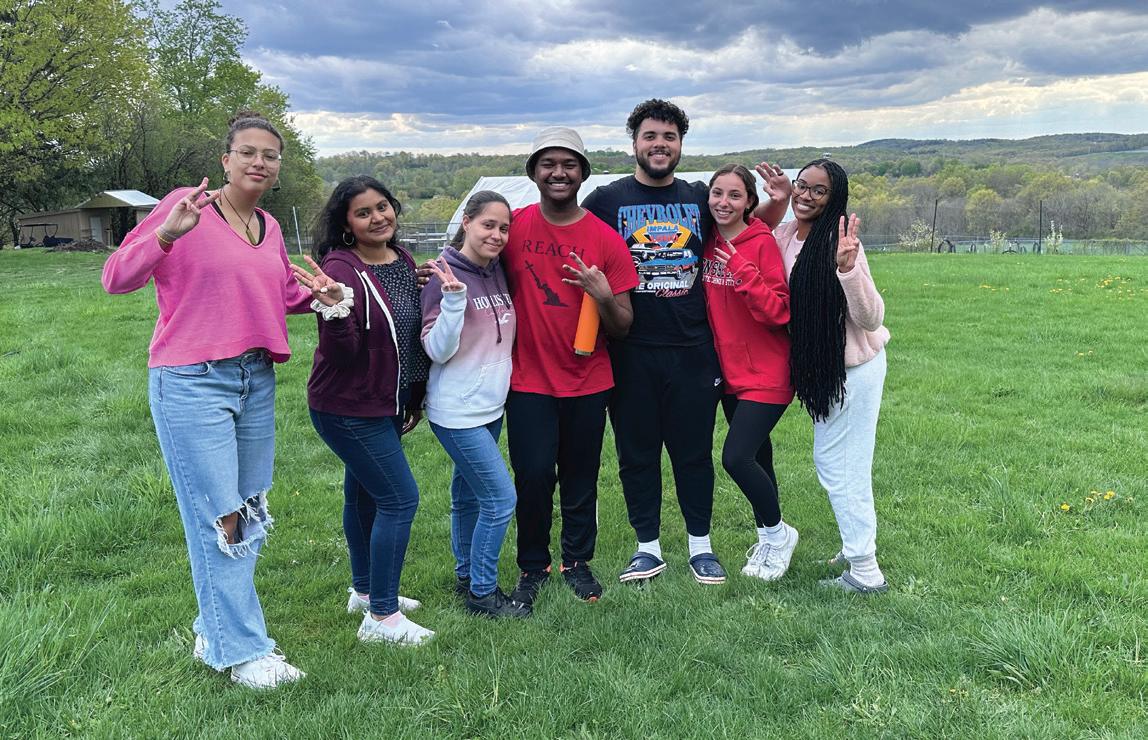
14 N spring 2024 ON CAMPUS
Jaspers bond at Kairos X, one of Campus Ministry and Social Action’s many Lasallians in Faith Together (LIFT) retreats held annually. Kairos X was held last April in the tranquil surroundings of Goshen, New York.
The Culture of Games (ART
134)
Course Description:
THE VIDEO GAME INDUSTRY is one of the fastest-growing sectors in the entertainment business. For students who are interested in a career in the gaming field, Manhattan College now offers a major and minor in game design and production in the Kakos School of Arts and Sciences.
The Culture of Games explores why people play games, the history and structure of the industry, genres, marketing, and job opportunities in the business. It introduces students to the specific divisions of gaming, which include design, coding and narrative. All majors begin their studies with this course and learn about the different concentrations within the game design and production major (students who follow the coding concentration will earn a B.S. degree, while those following the design or narrative concentration will earn a B.A.). Students will learn the subcultures, controversies and related media that make up gaming culture, as well as the history of the video game industry from its precursors in the pre-digital culture to the present and near future.
This course also explores the emerging field of video game production, which includes the stages and departments of game development, including narrative construction, character design, animation, lighting, game mechanics, and the coding that supports it all. In addition, students will explore how AI is being integrated into video games and as plugins to help design video games. As an introductory course, the class helps to guide students in considering which path of game design and production they would like to take.
Texts: Various reading materials include the articles, “Why Do People Love Games?” from The New York Times; “The Evolution of Game Console Design” from WIRED; and an excerpt from the book, Moral Combat: Why the War on Violent Video Games is Wrong (BenBella Books, 2017).
Lectures: Monday, Wednesday and Thursday, 3-3:50 p.m.
Professor: Michael Grabowski
About the Professor:
Michael Grabowski is director of the Game Design and Production program, professor in the Communication department, and coordinator of media technology at Manhattan College. Grabowski has a dual Bachelor of Arts and Master of Arts from The Ohio State University, and a doctorate from New York University. His research interests include the emerging field of neurocinematics and bridging the disciplines of media studies and neuroscience. His work on documentaries, feature films, commercials, music videos, and news have played at the Guggenheim and Smithsonian, several film festivals, and on broadcast and cable networks. Currently, he is working on a book about the perception of the real world through virtual environments.

Professor of Religious Studies Receives National Peacemaker Award
KEVIN AHERN, PROFESSOR OF RELIGIOUS STUDIES and director of the new Manhattan College Dorothy Day Center, received the Eileen Egan National Peacemaker Award by Pax Christi Metro New York. Ahern was honored for his work as the director of Peace and Justice Studies at Manhattan College and for his efforts as a leader with several international Catholic peace movements.
Pax Christi, an international Catholic peace movement organization, cited Ahern for his leadership in the canonization process for Dorothy Day. Pax Christi Metro New York was founded in 1972 by noted peace scholars and activists at Manhattan College.
“I am honored with this award, which I believe speaks to the peacebuilding power and potential of Manhattan College faculty and students,” Ahern says. “I hope that we as a College can continue to embody the Gospel call to be peacebuilders in our Lasallian Catholic mission.”
During his leadership work, Ahern facilitated a series of listening sessions with Catholic lay leaders in more than 50 countries. These listening sessions were accompanied by a series of online dialogues among professionals and young adult leaders on various themes, including good governance, human rights and the crisis of democracy worldwide.
As part of his work with the Pax Romana movements, Ahern has been involved in advocacy work for issues of peace, human rights and youth participation in the United Nations system for 20 years.
“Your peacemaking efforts have reached far and wide,” reads the citation Ahern received. “Here at home, you have served as director of peace and justice studies at Manhattan College. Farther afield, you have been a leader of several national and international organizations, including the International Movement of Catholic Students and the International Catholic Movement for Intellectual and Cultural Affairs.”
The Eileen Egan National Peacemaker Award is presented to a person or organization whose peacemaking efforts have reached people across the nation through teaching peace, making peace and being peace, as inspired by faith. It is named after Eileen Egan, a co-founder of Pax Christi USA.
COURSE SPOTLIGHT
MA nHATTA n .EDU N 15
Kevin Ahern (third from the left)

Model UN Delegates Gain Insight and Experience at Conferences
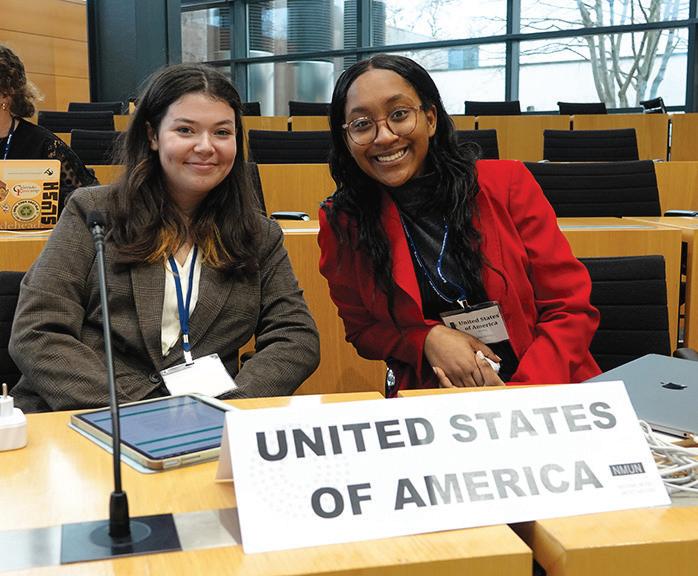
IT WAS A BUSY NOVEMBER FOR MANHATTAN COLLEGE
STUDENTS PARTICIPATING IN MODEL UN activities. For the first time since 2015, the College took part in two fall Model UN conferences in the span of less than one month. Fourteen students represented the Russian Federation at the National Model UN conference in Washington, D.C., and a week later, eight students represented the United States at the National Model UN-Europe (NMUN) conference in Erfurt, Germany.
Model UN gives students the opportunity to experience what it’s like to be a United Nations delegate, writing resolutions and discussing topics ranging from nuclear energy to sustainable development.
“It is one of the most fascinating but intense experiences,” says Jazi Riley ’25, a political science and philosophy double major and student body president. “It requires you to test your research and presenting abilities while diplomatically negotiating or creating new innovative ideas. It simply puts you to work.”
Model UN is an extracurricular activity, so students need to put in the extra time to research and write their position papers and prepare for the conferences — on top of their courses.
“It’s difficult for students in the fall because Model UN is like adding an additional class to their already busy schedules,” says Pamela Chasek, professor of political science and longtime Model UN adviser. “They all did an amazing job dedicating their time to prepare for the conference and representing two very difficult countries.”
And their dedicated work paid off. Both the Washington and Germany groups were awarded honorable mentions for their efforts.
While visiting Germany, Chasek and her students also had
the opportunity to take in a few sights and learn about medieval German history (Wartburg Castle and Jewish Erfurt), as well as the horrors of World War II (Buchenwald Memorial) and the Cold War era (Observation Post Alpha and the Stasi Museum). It was a oncein-a-lifetime experience for the students.
“We celebrated where the world has come and how the UN has brought countries to the table to talk out their problems rather than jumping to war,” Riley says. “The group I was with was wonderful, the culture tours were insightful, and we all had an amazing time at the conference. We even brought home an award, so it was all-around amazing.”
Montserrat Nicasio ’25, a psychology major who participated in the conference in Washington, D.C., was grateful for the opportunity to participate in the Model UN.
“I don’t think there’s one word that can describe what it’s like and how it feels to be a part of both the Model UN team at Manhattan and being a delegate in whichever committee I’m in during the conferences,” Nicasio says. “You truly experience every emotion being a delegate, such as confidence, professionalism, motivation to be your best self, and pure inspiration by the other fellow delegates you work with. I have gained a tremendous amount of communication skills.”

the United States at the National Model UN-Europe conference in Erfurt, Germany. This Germany group was awarded an honorable mention for their efforts. In addition to the conference, delegates had the chance to visit a few historical sights during their trip abroad.
ON CAMPUS 16 N spring 2024
(Left) Quinn Nagle ’25 and Jazi Riley ’25, and (right) other Model UN delegates from Manhattan College represent
Professor Awarded Grants to Diversify Economics Education
 JIMENA GONZÁLEZRAMÍREZ, ASSOCIATE PROFESSOR OF
JIMENA GONZÁLEZRAMÍREZ, ASSOCIATE PROFESSOR OF
ECONOMICS AND FINANCE, has been awarded two grants totaling $56,365. The grants are part of a larger $600,000 from the National Science Foundation (NSF) and the CSWEP-SSRC Women in Economics and Mathematics Research Consortium for her project, “Diversifying Economics in the Undergraduate Classroom: Plug and Play Video Modules with Diverse Role Models, Relevant Research and Active Learning.” The project is designed to increase the numbers and success of women and other historically underrepresented groups in the economics field. The grants began in January.
The project builds on evidence from the STEM education literature that active, engaging instructional techniques, including those using media, improve student performance and provide even greater benefits to students from underrepresented groups. The intervention that the team will create and evaluate utilizes plug-and-play modules featuring diverse economists discussing their policy-relevant research. At the core of this intervention is a series of professionally produced videos with accompanying research and curricular materials. The grant targets undergraduate economics courses.
“I am thrilled to have received these grants to support this important project and to collaborate with this terrific team,” González-Ramírez says. “I believe that economics is a vital subject for all students to learn, and I am committed to making it more inclusive and engaging for everyone. This project will allow us to develop and test a new intervention that has the potential to make a real difference in the lives of our students.”
Student impacts will be measured using econometric analysis of pre- and post-surveys of the student participants and institutional data on their continuation in economics. This project will assess whether an intervention that introduces gender-related material into economics courses improves female students’ sense of relevance and belonging, test scores and continuation in additional economics and mathematics classes.
González-Ramírez says that the project will be especially helpful for diverse students and improve their perceptions about economics. The goals are to also build a student’s sense of belonging, economic identity and self-efficacy, persistence and retention in economics.
Mechanical Engineering Faculty Member Receives Outstanding Advisor Award
 PARISA SABOORI, PROFESSOR AND CHAIR OF THE MECHANICAL ENGINEERING DEPARTMENT
PARISA SABOORI, PROFESSOR AND CHAIR OF THE MECHANICAL ENGINEERING DEPARTMENT
, has been named the 2023 recipient of the Outstanding Student Section Advisor Award from the American Society of Mechanical Engineers (ASME).
The award recognizes the leadership and service qualities of an ASME Student Section Advisor who has completed at least three academic years in the role, providing guidance to the student section on the activities and programs that will stimulate interest in the engineering profession, and creating a professional awareness in student members that will inspire them to maintain a continuous active membership in ASME. The award honors recipients that encourage student section officers to get involved and participate at ASME training, conferences and competitions, and acts as a liaison between ASME and the student section members.
“I was very excited and happy that my efforts were recognized by ASME,” Saboori says. “The relationship that I establish with our students is something that I enjoy and is extremely important to me. There is something very gratifying about working with students and seeing them develop and grow both academically, professionally and personally.”
In addition to her work with the ASME student section, Saboori is a highly accomplished researcher and educator. She has been an ASME fellow since 2020, and her research has led to new insights into the mechanisms of traumatic brain injury, shaken baby syndrome and biomechanics of knee and leg injuries in women’s sports. She is also the program coordinator of the biomechanics program at Manhattan College, which provides research experiences for high school and undergraduate students, and is the treasurer of ASME’s bioengineering executive committee.
Her dedication to education and her commitment to diversity and inclusivity have made her a role model for students and colleagues alike. Saboori is a tireless advocate for STEM education for women and her work has helped to inspire and motivate students to pursue careers in the engineering and biomedical fields. She takes tremendous personal satisfaction in mentoring female students and helping them navigate a primarily male dominated field.
Saboori earned her Master of Science and Ph.D. in mechanical engineering from The City University of New York. She is a fellow of the American Society of Mechanical Engineers, and a member of the Society of Women Engineers and American Society for Engineering Education.
MA nHATTA n .EDU N 17

Racking up the Rankings
The College continues to stand out in national measures of success.
PAYSCALE COLLEGE SALARY REPORT
Manhattan College ranked No. 46 on the 2023 Payscale College Salary Report of Best Universities for a Bachelor’s Degree. The ranking, which is based solely on earning potential, notes that the College’s midcareer salary of $152,400 outpaces universities such as the University of Southern California, the University of Chicago and Wesleyan University. Manhattan graduates can also expect an early career salary of $77,300.
The national ranking places the College in the top 2% of U.S. colleges. Manhattan also placed 12th in New York State out of 118 schools, ahead of New York University, Fordham University and Barnard College. Among faith-based institutions, Manhattan ranked No. 6 in the nation out of 559 schools, ahead of Fairfield University, Boston College and Providence College.
Payscale also listed Manhattan College in the top 100 in its College Return on Investment (ROI) Report.
The rankings come from the alumni salary data of 3.5 million respondents, representing more than 2,400 colleges and universities across the U.S.
U.S. NEWS & WORLD REPORT
U.S. News & World Report has ranked Manhattan College 13th in its 2024 listings of the nation’s best regional colleges and universities in the North. In fact, the College made major gains in all of the publication’s performance categories.
One of Manhattan’s biggest gains came in the area of best colleges in the region for social mobility, moving up from 86th in that category to 51st in 2023. Manhattan College also entered the top 50 of best value colleges in the region, ranking 49th.
Among student veterans, the College ranked third among regional universities, continuing its perennial recognition as a school that embraces those who have served in the military. In the undergraduate teaching category, Manhattan placed eighth, extending its run of top10 rankings.
The College was also recognized as one of the best schools for undergraduate engineering among institutions that do not grant doctorate degrees, finishing 40th. Manhattan made major strides in the rankings for its undergraduate business program, as well.
U.S. News provides rankings of more than 1,800 colleges and universities, as well as hundreds of graduate school programs. The company ranks colleges based on data it annually collects from administrators about their academic offerings. They also include analytics such as the student-faculty ratio and the average federal loan debt of graduates. U.S News & World Report considers data it gathers from surveys of students at the colleges who rate and report on various aspects of their campus and community experiences.
MONEY
Manhattan College has been recognized as one of the Northeast’s top private institutions and as one of the best Catholic colleges in the region by Money in its 2023 Best Colleges in America ratings. Manhattan received 4 ½ stars on Money’s five-star ratings system. This is the first year the publication has used the star ratings, replacing its former numerical ratings.
The personal finance digital platform ranks Manhattan first among all Catholic colleges in New York State and tied for first among 44 ranked Catholic institutions in the Northeast. The College tied for fourth out of 41 ranked private institutions in New York and tied for 13th out of 155 private colleges and universities in the Northeast.
To find colleges that combine quality and affordability, Money’s ratings are based on dozens of factors, including graduation rates, affordability, quality of education, financial aid, economic mobility and alumni salaries.
Manhattan College has previously been ranked by Money as one of its top 10 most transformative colleges.
FORBES
Manhattan College graduates are well-positioned for success in their careers, according to new college rankings by Forbes. The College ranked 41st for its high median 10-year alumni salary of $148,800, surpassing many universities, including New York University and the University of Chicago. Manhattan’s high median salary is a result of its strong academic programs and commitment to preparing students for success in the workforce.
Overall, the College ranked 246th on the prominent business publication’s 2023 list of America’s Top 500 Colleges. Manhattan finished 28th among best colleges in New York State and 49th among colleges classified as medium-sized.
Forbes uses multiple criteria in making its selection, including student success, return on investment, alumni influence, retention and graduation rates, securing high alumni salaries and low debt, and how well the school serves low-income students.
WASHINGTON MONTHLY
Manhattan College ranks as the fifth-best college in the nation in the Master’s Colleges and Universities category for the earnings performance of its graduates, according to the 2023 Washington Monthly College Guide and Rankings. The College improved on its strong 2022 rankings, jumping from 42nd to 29th in the publication’s Best Master’s Colleges and Universities category, largely based on its contribution to the public good in social mobility and the previously mentioned earning performance of its alumni.
Washington Monthly also recognized Manhattan as the 40thranked Best Bang for the Buck in the Northeast. This ranking is based on a number of factors, including the College’s affordability,
ON CAMPUS
18 N spring 2024
graduation rate and alumni earnings.
Since 2005, Washington Monthly, a bimonthly political magazine and website, has ranked schools based on their contribution to the public good in social mobility, research and providing opportunity for public service. All three of these measures are weighed equally, meaning that a college must excel in all of these areas, rather than just excelling in one. The Best Bang for the Buck colleges are rated based on helping non-wealthy students obtain marketable degrees at affordable prices.
THE PRINCETON REVIEW
For the eighth consecutive year, Manhattan has been ranked as one of the nation’s best institutions for undergraduates and best colleges in the Northeast region.
Manhattan College has been recognized as one of the top colleges in the country in the Princeton Review’s Best 389 Colleges for 2024. The College was also rated as one of the best regional schools in the Northeast.
The publication praised the College’s strong academics, commitment to service and vibrant campus life. Manhattan was also noted for its strong alumni network, which provides students with opportunities for internships and job placements.
Students emphasized the College’s focus on the “five Lasallian values” of “faith, respect, education, community and social justice,” which shape the culture on campus, primarily in its commitment to service.
They also highlighted that Manhattan “carries prestige” and has “a lot of connections” in the “public sector and private industry,” so students have a “greater chance of being placed/connected with an internship that closely relates to their field of choice.”
Only about 15% of America’s four-year colleges are profiled in the book, which is one of The Princeton Review’s most popular publications. The Princeton Review gathers data from its surveys of college students who rate and report on various aspects of their campus and community experiences. Students are asked to rate their schools on a variety of factors, including academics, campus life and extracurricular activities.
Civil Engineering Students Earn Scholarships

NINE MANHATTAN COLLEGE CIVIL ENGINEERING STUDENTS RECEIVED SCHOLARSHIPS from the American Council of Engineering Companies (ACEC) of New York for a total of $34,500. The scholarship amounts range from $1,500 to $10,000 and are awarded based on students’ cumulative grade point averages, college activities, work experiences and essays.
John Ng ’23 was awarded a $10,000 American Council of Engineering Companies of New York Merit Scholarship-New York City Department of Environmental Protection.
John Ng ’23, a Brooklyn native, was awarded a $10,000 ACEC New York Merit Scholarship-New York City Department of Environmental Protection. He interned at Mueser Rutledge Consulting Engineers in Manhattan this past summer and previously worked as a New York City Transit infrastructure engineering intern and as a field engineer intern for Judlau Contracting, a division of construction company OHLA. Ng has served as president of the Institution of Transportation Engineers Student Chapter, an officer of the College’s Train Club, and a student representative to a Manhattan College Board of Trustees subcommittee.
As a student at Brooklyn Technical High School, Ng also was a student mentee in the ACE Mentor Program of Greater New York, which paired him with professional mentors who offer an introduction to careers in the design and construction industry. (Read more about ACE on page 38.)
“Very few engineers are still alive today who have witnessed the construction of our subways, sewers and roads,” Ng says. “I chose a career in civil engineering to carry on the legacy of building infrastructure that keeps the city running. To me, the scholarship is an affirmation that I can make a real impact on improving the infrastructure of our cities to meet 21st century demands.”
Emily Specht ’24 was named the recipient of a $5,000 Hazen and Sawyer Scholarship. Orlando Blanco ’23 (Langan Engineering, Environmental, Surveying and Landscape Architecture, DPC Scholarship, in memory of Maria I. Ramirez, 9-11-01) and Nicholas Badillo ’24 (WSP USA Inc. Scholarship), received $3,500 scholarships. In addition, the following five students received $2,500 scholarships: Evan Rivera ’24 (Stantec Scholarship), Samantha Perricelli ’24 (Sam Schwartz Engineering Scholarship), Edgar Moreno ’24 (Infrastructure Engineering, Inc., P.C. Scholarship), John Henry Genualdo ’23 (Arup Scholarship) and Maryam Asgari ’24 (Mueser Rutledge Consulting Engineers Scholarship).
The ACEC scholarship program was launched in 2002 to support up-and-coming engineers and, thus, ensure a strong future for the profession in New York State.
“The ACEC scholarships recognize talented engineering students for their academic excellence and involvement in the engineering discipline,” says Anirban De, interim dean of the School of Engineering and professor of civil and environmental engineering. “It shows the collective commitment of the engineering firms and encourages the next generation of engineers to consider careers in engineering. The financial award helps our students cover a portion of their tuition or other financial needs. On behalf of the engineering students and faculty of Manhattan College, I am grateful to the members of ACEC New York for their continued support.”
MA nHATTA n .EDU N 19

Physics Professor Receives $135,000 NSF Grant
BART HORN, ASSOCIATE PROFESSOR OF PHYSICS
, has received a $135,000 grant from the National Science Foundation (NSF) to support his research on early universe cosmology. The grant, Pion Lagranian for Large Scale Structure in Cosmology, is part of the NSF’s Research at Undergraduate Institutions (RUI) program, which supports research projects that involve undergraduates.
Horn is focused on developing new and more efficient algorithms to simulate the evolution of large-scale structure (LSS) in the early universe. The research is an important step toward understanding how the universe formed and evolved, and how the laws of physics have changed over time. By studying the evolution of LSS, Horn is attempting to learn more about the properties of dark matter and dark energy, which are two of the most mysterious substances in the universe. LSS is the pattern of galaxies and clusters of galaxies that are seen in the universe. It is thought to have formed from tiny density fluctuations in the early universe that were amplified by gravity over time.
“Surveys of large-scale structure in the universe are poised to transform the field of cosmology over the next five to 10 years,” Horn says. “By measuring the distribution and evolution of galaxies and matter over time, physicists hope to probe the age, composition and early history of the universe to unprecedented levels of precision.”
Horn said the work will apply effective field theory techniques from high-energy physics to LSS. The research will develop connections between physics and related fields and will create multiple opportunities for undergraduate students to participate in cutting-edge research. In addition, this program will help make the field of early universe cosmology accessible to a new generation of researchers by supporting outreach to local high schools and other venues in New York City.
Horn is working with two student researchers, Bhavya Mishra ’25, a computer science major, and David Muqattash ’25, a physics major, both of whom presented on the topic during the College’s summer
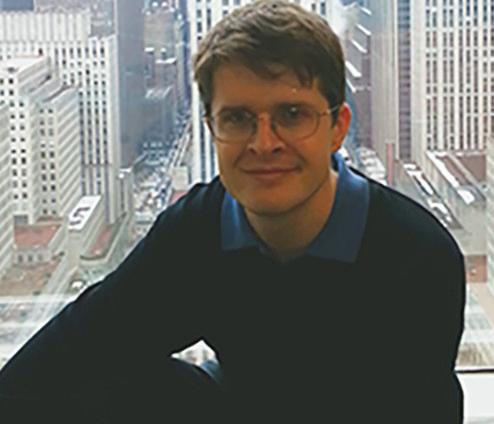
symposium. The team is using a new approach to simulating LSS based on the pion field. Their simulations are still under development, but they have already shown promising results, accurately reproducing the evolution of LSS at early times. Horn and his team are working to improve their simulations so they can be used to study a wider range of cosmological phenomena. They also plan to compare their simulations against theoretical predictions and experimental data.
Pioneering Professor Inducted Into Women’s Hall of Fame
JUDITH PLASKOW, PROFESSOR EMERITA OF RELIGIOUS STUDIES at Manhattan College, is one of eight inductees into the National Women’s Hall of Fame for 2024. Plaskow joins an elite group of 315 women that includes historical figures such as Clara Barton and Helen Keller and more contemporary individuals such as Jane Fonda and Aretha Franklin. Other 2024 inductees include tennis great Serena Williams.
“When I actually read it and looked at the list of past inductees, I was blown away,” Plaskow says, admitting that she had initially deleted the induction email, thinking it was part of a fundraising campaign. “Me in a Hall of Fame with Harriet Tubman, Elizabeth Cady Stanton, Sojourner Truth, Michelle Obama and Ruth Bader Ginsberg? What I feel good about is that I’m the first inductee with a degree in religious studies and the first whose work focuses on Judaism. I will bring to light the exciting work that has been accomplished in those areas.”
Plaskow’s awardee biography notes her extensive accomplishments and what makes her uniquely qualified to be inducted into the hall of fame: “Judith Plaskow is an American theologian, author and activist known for being the first Jewish feminist theologian. She earned her doctorate from Yale University in 1975 and spent over three decades teaching religious studies at Manhattan College. Plaskow launched the Journal of Feminist Studies in Religion in 1985 and served as the journal’s
editor for its first 10 years and from 2012 to 2016. Plaskow also helped found B’not Esh, a Jewish feminist spirituality collective, and served as president of the American Academy of Religion.”

A prolific writer, Plaskow continues to play an integral role in the development of Jewish feminist theology. Her book, Standing Again at Sinai: Judaism from a Feminist Perspective, examines how the absence of female perspectives in Jewish history has negatively impacted the religion, and Plaskow urges Jewish feminists to reclaim their place in the Torah and in Jewish thought. Standing Again at Sinai is one of the first Jewish feminist theological texts ever written and is considered by many to be a seminal Jewish text of the 20th century.
Plaskow, who began teaching at Manhattan College in 1979, also has a master’s degree from Yale University and a bachelor’s degree from Clark University. She received Doctor of Humane Letters degrees from Hebrew Union College and the Reconstructionist Rabbinical College.
ON CAMPUS 20 N spring 2024
At Horan Lecture, Brandon Steiner Shares Lessons for Life and Business
FACULTY, ALUMNI AND FRIENDS OF MANHATTAN COLLEGE GATHERED last October at the New York Athletic Club for the John J. Horan Endowed Lecture, which was delivered by entrepreneur and thought leader Brandon Steiner.
Named in honor of John J. Horan ’40, former chairman and chief executive officer of Merck & Company Inc. (which established the endowment), the lecture series brings Manhattan College educators together with leaders from the business, scientific, engineering and educational communities. The first Horan Lecture was held in March 1989 and featured a talk by P. Roy Vagelos, then chairman and CEO of Merck & Company.
Traditionally a biannual event, the College has most recently welcomed New York Times reporter J. David Goodman and 1010 WINS reporter Juliet Papa, among others (panel, November 2019); Vishaan Chakrabarti, founder of Practice for Architecture and Urbanism (April 2019); and Danny Meyer, founder and CEO of the Union Square Hospitality Group (November 2018). However, the series had been on hiatus since the pandemic, which made the Oct. 24 gathering a most welcome occasion.
The evening’s celebratory air was especially suited to Steiner, an expansive and conversational speaker who shared plentiful anecdotes from his long and varied career. Best known as founder and CEO of sports memorabilia outlet Steiner Sports, which he ran for 30 years, he went on to found The Steiner Agency, which connects clients with sports personalities. Steiner also runs CollectibleXchange, an online platform for buying and selling collectibles. He makes frequent appearances on CNBC, CNN, MSNBC and ESPN and has written several books, including Living on Purpose: Stories About Faith, Fortune and Fitness That Will Lead You
to an Extraordinary Life. He is a founding member and board chairman of the David B. Falk College of Sport and Human Dynamics at Syracuse University.
In his introduction, President Milo Riverso ’81 said, “As a businessman, author, thought leader and serial entrepreneur, Mr. Steiner has inspired others through his example of what can be achieved by exercising one’s intellect in pursuit of one’s passion.”
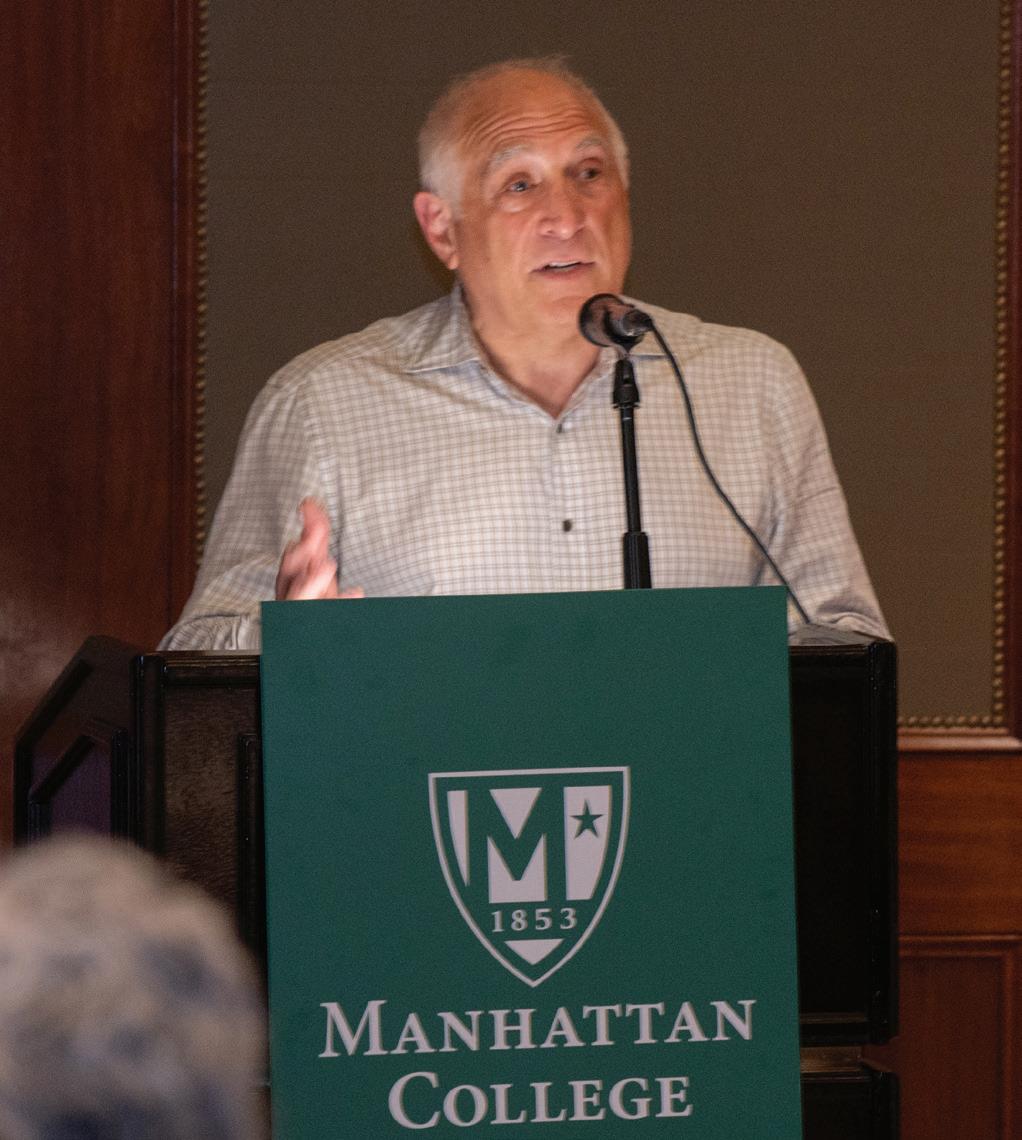
Steiner proved the truth of those words as he described lessons he learned growing up poor in Flatbush, New York. Describing himself as “a relentless kid,” he related his early business success in establishing a paper route. He gained the most customers (and won a box of chocolate) by offering an additional service: delivering bagels and milk from the local store, along with the newspaper.
“As a 12-year-old kid, I got into an 80-yearold woman’s head and figured out what had value to her,” Steiner said. The lesson? “Stop selling,” he advised. “Start serving, start solving.”
After graduating from Syracuse University with a degree in accounting, he worked in the hospitality industry and opened a successful sports bar in New York City, which captured the attention of professional athletes who asked for his help in opening their own bars. He eventually decided to open his own sports marketing business, which became Steiner Sports. Throughout his career, during which he partnered with storied sports teams including the New York Yankees, Dallas Cowboys and Notre Dame, he remembered the lessons learned from that paper route.
“When I meet with Derek Jeter or anyone else,” Steiner said, “I’m not thinking about what I can get from them, but what I can do for them.”
One of the main takeaways on leadership that Steiner offered from his experience is to “lead with love, and double down on it every day.” He continued, “Turn up your empathy. Get out of your own head and get into others’. Add value in all your relationships … I urge all of you to cross roads of enthusiasm and curiosity.”
That curiosity is key to strong leadership, he said, noting that he starts meetings by asking if anyone has any ideas they want to share. “Get out of your office,” he urged, “and ask people what’s broken? What needs to be fixed?”
At the conclusion of Steiner’s remarks, Riverso presented the lifelong Syracuse fan with a set of Manhattan-branded glassware, which was duly appreciated. Attendees then had the opportunity to converse one-on-one with Steiner. But before he left the podium, the lifelong sports aficionado offered one last “inside baseball” word of advice: Never eat ballpark food until the second inning — food served during the first inning is probably left over from the previous game.
MA nHATTA n .EDU N 21
Sports marketing entrepreneur, author and media personality Brandon Steiner shared his insights from his Brooklyn childhood, decades-long career, and interactions with athletics legends at the Horan Lecture in October.

College Examines the Potential of Artificial Intelligence

(This page) Yong Sup Song, a professor of Christian ethics and theology at Youngnam Theological University in South Korea, is the featured speaker at the first of three artificial intelligence (AI) lectures at College this fall. He explores how AI can effectively adopt Korean cultural and religious traditions to enhance its connectivity with humans. (Facing page, from left to right) Christiaan Hiemstra and Ash Brown, both from Bloomberg L.P., discuss how AI will impact the design of the workplace with moderator Enrico Forti, assistant professor of management and marketing at the College. Michael Grabowski, professor of communication, hosts a conversation about the ethical implications of AI and quantum computing with Robert Geraci, professor of religious studies, and a panel of industry experts.
MANHATTAN COLLEGE HOSTED THREE LECTURES THIS FALL ON VARIOUS TOPICS RELATED TO ARTIFICIAL INTELLIGENCE (AI). It’s clear from all of the discussions that nobody can predict how far AI technology will progress or what role it will play in the far future. We can, however, make every effort to stay informed of new technological advancements and discover how to integrate them into our daily lives.
Korean Cultural Religious Values on the Development of Moral AI
The first artificial intelligence lecture, sponsored by the Religious Studies department and the Kakos School of Arts and Sciences, featured Yong Sup Song, assistant professor of Christian ethics and theology at Youngnam Theological University in South Korea. The subject of his lecture was the development of moral artificial intelligence in relation to Korean cultural religious values. Robert Geraci, professor of religious studies and faculty director for Veteran Success programs at Manhattan College, introduced Song as a friend and colleague who pushes the boundaries of his research on artificial intelligence. Song addressed how artificial intelligence can adopt Korean cultural and religious traditions, regional values, and virtues found in the martial art Hwarangdo in order to connect with humans.
“AI robots will no longer have to be considered tools for humans, but instead, they can be seen as new partners for us to make meaningful relationships,” Song said. His focus was not on the crisis of robots replacing humans, but, rather, he focused on having symbiotic relationships with artificial intelligence.
He expressed that there is an intersection
where religion, culture, science and technology influence each other in the development of AI and highlighted the importance of the martial art Hwarangdo as a means to help artificial intelligence. Considered one of the most comprehensive systems of self-defense and combative techniques in the world, Hwarangdo has been developed in accordance with the ancient principles of Um-Yang, which emphasizes balance in life and harmony with others and nature.
“For AI to grow prosocial, they must learn from the good parts of human nature,” Song said. “The idea and stories of Hwarangdo should contribute to the development of prosocial moral artificial intelligence by providing virtues and various Korean cultural and religious traditions, regional values and virtues found in Hwarangdo.”
To end the lecture, Geraci shared his perspective of the lecture’s impact on students.
“It is my hope that these discussions will lead students to understand and appreciate the need for broad cultural learning,” he said.
The Ethics of Artificial Intelligence and Quantum Computing
Prashant Reddy, managing director and chief architect for AI and data at JPMorgan, Geraci and Steve Randich, executive vice president and chief information officer at the Financial Industry Regulatory Authority (FINRA), joined the Manhattan College community for a conversation about the ethical implications of AI and quantum computing.
Moderated by Michael Grabowski, professor of communication and director of the Game Design and Production program, the event was conducted in a conversational style, based on contributions from the panel and questions from the audience.
To open the discussion, Grabowski asked the panelists what they thought about the promises and risks of AI.
“One of the main impacts I worry about is
ON CAMPUS 22 N spring 2024 LECTURE CIRCUIT

labor displacement,” Reddy said. “A lot of jobs that we have been prepared for and went to college for may not exist in five to 10 years. What we thought was the least likely thing to be automated, which was creativity, is one of the first things we lost.”
Grabowski then asked about what ethical frameworks we should use when we think about the development of AI. Geraci expressed his belief that the government should have some involvement in funding protective technologies against AI. He mentioned the idea of “deepfakes” in the media, which are AI-generated photos or videos that make fake events look realistic and hard to decipher if they’re true or not. To address this ethical concern, Geraci suggested that the government fund ways to detect them in the media.
In transitioning to discussing quantum computing, Grabowski asked the panelists what their concerns were about how quantum computing has progressed online.
“I think the biggest and most noteworthy risk of quantum computing is its ability to allow hackers to encrypt data,” Randich said.
On the other hand, Reddy suggested that quantum computing could be a complete game changer when it comes to simulating physical systems. Despite the fact that it can be scary, Reddy opined it was worth the risk.
As the second AI lecture was coming to an end, Grabowksi asked the panelists what students can do to prepare for a world that has AI and quantum computing in it. All the panelists advised that AI should only be used

as a tool to help students and not replace their own work. They emphasized how important it is for individuals to recognize the ethics of AI and quantum computing, in order to prevent harm, bias and misuse of such technologies. Prioritizing ethics will help build trust and ensure that these technologies will benefit humanity.
AI and Workplace Design
For the last AI lecture of the year, the College invited Christiaan Hiemstra, the global head of design and workplace design strategy at Bloomberg L.P., and Ash Brown, the global head of user experience at Bloomberg L.P., to address how artificial intelligence will impact the physical design of the workplace. The event was moderated by Enrico Forti, the Gabriel Hauge Assistant Professor of Strategy in the department of management and marketing at Manhattan College.
These prominent experts from the workplace design industry provided insights on the interactions of flexible work schedules, remote work and how AI technology will affect the design of the work environment in office buildings and home offices.
Forti began the discussion by having the panelists describe their jobs and what makes them interesting.
“User experience design is the process of figuring out who your user is,” Brown said. “Figuring out what problems they have and figuring out what tools you have at your disposal to solve it in a way that will deliver something valuable and that will be
functional for the user.”
Hiemstra described what occupational designers do and how one of the most interesting projects he has worked on was post-pandemic.
“People’s requirements for space changed drastically,” he said. “Owners thought of ways to save space and downsize and change the whole structure of the office to make it more collaborative.”
The speakers reviewed the history of AI development, their initial experiences with AI technology, and what that technology means for future workspaces.
“It’s all about usage of space,” Hiemstra said. “Something like AI can help figure out something for you and really place a more accurate picture that would take people multiple strategies and much longer time to figure out themselves.”
To wrap up the discussion, Forti opened up the floor to any questions from students.
“If workplace design is personalized with AI, how do you think an occupier’s work-life balance might be affected?” asked Alexa Fox ’24.
Hiemstra explained that the new and upcoming technology in work spaces is giving people a choice and providing variety.
“The technology is allowing others to have control over their own environment,” he said.
Forti ended the discussion with thoughts on how artificial intelligence can enable changes in the workplace at low costs that scale and increase productivity.
MA nHATTA n .EDU N 23

FDIC Chairman Discusses Journey in Public Service for Annual Gargano Lecture
IN FEBRUARY, MANHATTAN COLLEGE HOSTED FEDERAL DEPOSIT INSURANCE CORPORATION (FDIC) Chairman Martin Gruenberg for its annual Gargano Lecture Series. This year, the lecture series was sponsored by the O’Malley School of Business and co-sponsored by the Political Science department, Beta Alpha Psi, Economics and Finance Society, Investment Club, and the University Neighborhood Housing Program.
The lecture featured a fireside chat format with moderators Donald Gibson, dean of the O’Malley School of Business, and Jumelia Abrahamson ’09, director of programs at the University Neighborhood Housing Program (UNHP). President Milo Riverso ’81 gave the opening remarks to an audience of more than 150 students, faculty and guests.
Gruenberg, who has more than 40 years of experience in banking and international finance, was sworn in as chairman of the FDIC board of directors in January 2023 and has been a member of the FDIC board since 2005, previously serving as vice chairman.
Gruenberg focused his lecture, titled Making a Difference in Government, on
encouraging students to consider civic engagement careers, opportunities for public service, and also the importance of the FDIC in local issues such as affordable housing.
To begin, Gruenberg briefly discussed the FDIC’s core mission and related its importance back to when President Franklin D. Roosevelt gave his own fireside chat during the Great Depression.
“The fundamental role in the FDIC is maintaining the public’s confidence in banking services,” he said. “When people have that confidence, they put their money in the bank, making the banking system work, and the economy work overall.”
Abrahamson noted how the FDIC can directly affect local communities. “The FDIC has a real impact here in the Bronx,” she said. “Directly in the lending that takes place in New York City and multifamily buildings and also in the banking services that our residents have access to in the Bronx.”
In response, Gruenberg used the example of Signature Bank, a New York State-based bank whose failure was the third largest in U.S. history in 2023. Signature Bank was one of the

largest multifamily lenders in New York City.
He addressed how the FDIC has a responsibility to ensure the stability of the financial system, which pertains to the local communities. Gruenberg explained how the FDIC sought to support the Bronx community, given that Signature Bank’s failure affected a large portfolio of mortgage loans on vital multifamily affordable housing in the Bronx.
A Bronx native himself, Gruenberg grew up in a working-class family not far from Manhattan College’s Riverdale campus. He related his upbringing to his passion for public service and elaborated on how his journey led him to his current position.
“My upbringing in the Bronx shaped who I am today,” he said. “When you come from that kind of background, you understand how hard life can be.” He continued, “For me, public service was the natural path to take. I do it out of respect for my parents, but also because it excites me and gets me up in the morning.”
Toward the end of the fireside chat, Gruenberg encouraged students to consider a public service career. He said although the career path is challenging, the jobs provide enormous learning opportunities.
“There are multiple ways you can serve, and it’s a way to make a true impact in your local communities,” he explained. He urged students to think about what truly excites them and to pursue what they are passionate about.
The Gargano Lecture Series honors Ambassador Charles A. Gargano ’79, U.S. Ambassador to Trinidad and Tobago and former chairman and commissioner of the Empire State Development Corporation, as well as a member of the College’s board of trustees.
Alongside Donald Gibson, dean of the O’Malley School of Business, and Jumelia Abrahamson ’09, director of programs at the University Neighborhood Housing Program, Federal Deposit Insurance Corporation
Chairman Martin Gruenberg shares insights on working in public service and how it can impact local communities at the annual Gargano Lecture Series.
ON CAMPUS 24 N spring 2024
LECTURE CIRCUIT
Manhattan Welcomes Author of The Kingdom Began in Puerto Rico
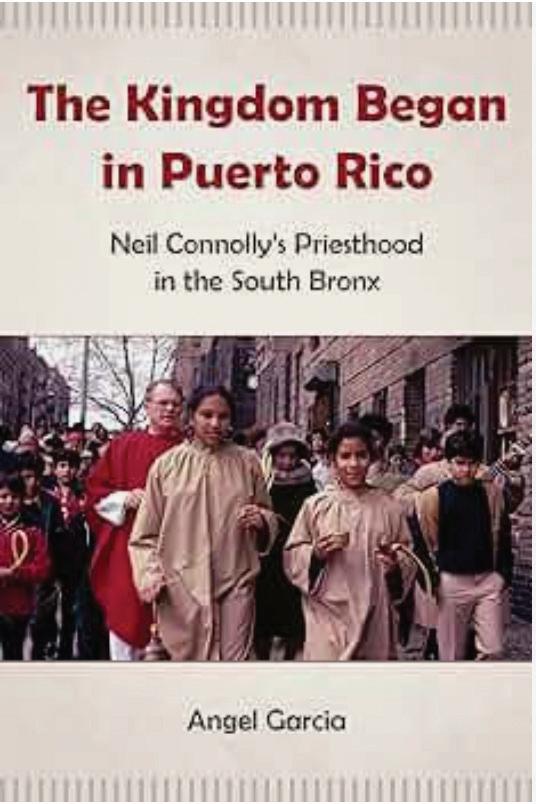
AS THE YEARLONG CELEBRATION OF MANHATTAN’S 100 YEARS IN THE RIVERDALE SECTION OF THE BRONX came to a close, author Angel Garcia visited the College to discuss his book The Kingdom Began in Puerto Rico: Neil Connolly’s Priesthood in the South Bronx (Empire State Editions, 2020). The book discusses Father Neil Connolly’s role in the improvement of the South Bronx, the importance of the time he spent in Puerto Rico, and how his experience helped transform the Bronx into the borough it is today.
Garcia is a longtime resident of the South Bronx and actively participates in social justice causes and worker cooperatives. He is a community organizer and executive director of South Bronx People for Change, a church-based direct action and membership organization co-founded by Father Connolly.
Sponsored by Campus Ministry and Social Action and the Political Science and Urban Studies departments, the event brought together students, faculty and members of the community to hear Garcia’s discussion of his book and its revelations about the history of the Bronx.
Garcia noted that in writing this book, he wanted to highlight a few heroes of the South Bronx, but after hearing about Father Connolly’s projects and campaigns, he was inspired to write a biography focusing on the priest and his work. What began as a story about the history of the Church, New York City and the rebuilding of the South Bronx evolved into an exploration of the question of what true priesthood looks like.
“By writing this story, it made me realize when it was all done, that we are all moving forward in history,” Garcia said. “We are all subjects of the power of historical forces, and we all need to consider our power at this moment in history, and how we can use our power to impact destiny in humankind.”
Father Connolly grew up as a devoted Catholic on Manhattan’s Upper East Side and
decided to join the priesthood after witnessing the kindness and support his family received from his parish. In the summer of 1958, he and a group of other priests and nuns went on a mission program to Puerto Rico, where he immersed himself in the language and culture, and discovered his true calling to help the Puerto Rican population in the South Bronx. He went on to serve this group from the 1960s to 1980s, assisting in their struggle to live a decent life after migrating to the United States. He believed that it was the Church’s responsibility to ensure the well-being of all, not just Catholics, in order to create the Kingdom of God on earth.
Meanwhile, social justice efforts and churches were also coming together in the 1970s and 1980s to address the needs of poor communities. Father Connolly challenged governmental entities that promised to help the poor only to abandon them. He spoke out against ill-conceived public plans that did not ultimately help people.
During the lecture, Garcia described the rampant government neglect of the South Bronx in the 1960s and 1970s. As the Puerto Rican population in the Bronx continued to grow, living conditions deteriorated, and many struggled to find affordable housing and jobs. According to Garcia, Father Connolly was one of the few who campaigned on behalf of the people.
“He helped bring them a God, a world of dignified and just living conditions for every single human being,” Garcia explained, adding that if Father Connolly challenged church officials too often, he would be in danger of losing his position. However, he was willing to make that sacrifice.
Garcia’s book presents a rich history of the South Bronx and calls for urban policies to begin with the people themselves while honoring a remarkable individual who exercised his influence for the benefit of the borough’s people.
LECTURE CIRCUIT
MA nHATTA n .EDU N 25
The author of The Kingdom Began in Puerto Rico, Angel Garcia, visited Manhattan College in celebration of Manhattan’s 100 years in Riverdale, Bronx. He discussed his book and its revelations about the history of the Bronx.

Irma Garcia Starts New Chapter as College’s Athletics Director

for student-athlete success and shares her excitement for the future of Manhattan College athletics.
“
by Kristen Cuppek
WHEN I WALK AROUND AND TALK TO YOUNG KIDS, IT’S ABOUT HEARING THEIR STORIES, and then interpreting their stories in a way that I want to ask them, ‘What chapter are you in? Where do you see this book ending? How do you want to end your next chapter? And how long is your book?’” says Irma Garcia, Manhattan College’s new director of athletics.
It’s a way to get students thinking about their future paths and aspirations, as well as to make them ask questions and consider different perspectives.
Garcia started her own new chapter on Aug. 1 and has been busy composing its pages ever since. She previously served as director of athletics for St. Francis College in Brooklyn, where she led the Terriers to record-setting Northeast Conference championships and NCAA Tournament appearances. Under her guidance, the athletic department grew in the numbers of student-athletes, program offerings and community support. The Terriers also led the way in graduation and overall GPA rates for students.
When she began that position at St. Francis in 2007, Garcia became the first Latina to lead an NCAA Division I athletics department. She was also one of the first women to lead an NCAA Division I athletics program in general.
Garcia was both surprised by and proud of this distinction, but her first reaction was to ask herself how she could use this status to help others.
“The fact is that it took a long time for that to really happen, and so I was a little bit taken back,” she explains. “So I said to myself, ‘What can you do with it?’ I really try to mentor women of color, predominantly Hispanic and Latina women, and give them a voice because that seems to be the issue. Since 2007, I’ve mentored so many women, and I’ve allowed them to hear my voice and taught them how to use their voice. It’s really been an honor to find out how many people whose lives I’ve touched.”
There are now a handful of other Latina athletics directors, but the number is still low, and Garcia wants to change that by helping young women find those opportunities and break into the field. Having had only male mentors to guide her when she was coming up in the athletics arena, Garcia says that she owes young women that support.
It’s support she would have liked to receive when she was beginning her career. The Brooklyn native studied physical education and health at St. Francis, and taught physical education and health after graduation. She served as the head women’s basketball coach at her alma mater for 11 seasons — and was even honored as the 1998 NEC Coach of the Year. But she had bigger goals.
SPORTS 26 N spring 2024
Irma Garcia, a veteran intercollegiate athletics administrator, continues to excel in her position as the College’s new athletics director. Prior to this role, Garcia served as director of athletics for St. Francis College in Brooklyn and as its head women’s basketball coach for 11 seasons. Garcia is recognized as the first Latina to ever lead a NCAA Division I athletics program and is a prominent leader among women administrators in college sports. She continues to prove her passion
“I love the alumni. Their stories and their passion about how much they love Manhattan College is so endearing. They’re very supportive of the student-athletes, and they’ve been very good to me.”
— IRMA GARCIA
“I wanted to coach, and I always wanted to be an athletics director,” she says. “It’s always been my dream to run a program.”
Garcia would title this new chapter at Manhattan College, Finding New Nuggets, because she looks upon all these new ideas and experiences as nuggets. “There are lessons here,” she notes. “I’m learning a lot. I’m learning different ways of how to do things, but I’m also helping people see ways to do things.”
One such nugget is change. The College has undergone substantial changes, and, of course, there’s bound to be change when you start a new job. But to Garcia, it’s not a negative.
“Change is always hard,” she explains. “But if you embrace it, and if you look at it differently, it’s something different then. This place has given me an opportunity to see those moments of change that I’m starting to embrace. How does that help me grow to be a better director of athletics for the student-athletes, for the College?”
She has discovered another nugget in the College’s alumni.
“I love the alumni,” she says. “Their stories and their passion about how much they love Manhattan College is so endearing. I love stories, and they have incredible stories. They’re very supportive of the student-athletes, and they’ve been very good to me.”
Garcia considers herself a “servant leader.” Hospitality is at the forefront of who she is, and she underscores the importance of listening and being collaborative.
“I will always be kind to everyone,” she says. “I think that’s something that the world is lacking, the kindness of really appreciating people for who they are and not being judgmental. You have to be transparent and share your ideas and not be afraid to say what you have to say in a kind way, but then accept ideas from other people who are different than you.”
Ronald Gray, former vice president of student life, saw many of these attributes in Garcia during the hiring process. He says that Garcia has been the perfect addition to the Manhattan College community.
“She has brought a lot of energy, passion and success to the role,” Gray says. “She understands and respects our Lasallian values. She is an unbelievable colleague, always looking for ways to partner and collaborate. She has just hit the ground running, making connections on campus, as well as in the community. I’m very, very thankful for her being here.”
Gray also points out Garcia’s love for the students. So it’s not a surprise that one of her goals is for the student-athletes to develop holistically.
“I want them to embrace not only being the athlete, but also being a student,” she says. “I also want every student-athlete, when they come in, to have an opportunity to have at least three internships. So
by the time they get out of here, they’re going to have a pretty good understanding of what the real world is like.”
Garcia also has goals for the coaching staff, whom she describes as dedicated and passionate.
“For our coaches, I want them to go out and understand that what they do as a coach is great, but to have a better understanding of the business model,” she says. “Our job is to bring in students. We just don’t just bring in student-athletes. But because we’re on the front porch, people are going to embrace the good things that are happening as Jaspers, and they’re going to want to come here.”
Throughout the years, Garcia has received several accolades, including the 2015-16 Division I-AAA Under Armour Athletic Director of the Year Award and being named the National Association of Collegiate Women Athletics Administrators Administrator of the Year for the 2014–15 academic year. Already a pioneer for women’s athletics on many fronts, Garcia became the first former women’s player/coach to ever be inducted into the Basketball Old-Timers of America Hall of Fame and was also honored with the Metropolitan Basketball Writers Association Distinguished Service Award.
But if you ask her about her accomplishments, she turns the attention toward her staff and students. Plus, she notes, she has so much more to do.
“I am well aware that I’ve accomplished a lot in the time that I’ve been a director of athletics and that I’m very proud of, but I’m very proud of my coaches, staff and student-athletes,” she says. “In this job, it’s not about me.”
So, how does her story end? Garcia doesn’t know; she’s still writing it.
“My story is still going,” she says. “I’m so blessed. The ability to still continue to do things that I love, I mean, I love what I do. The fact that we are able to help so many kids and really inspire people and help people. And to see it differently. Because I’m learning a lot here, how to see things not in the way I usually do.”
MA nHATTA n .EDU N 27

SPORTSSHORTS
GUNNAR STUDENHOFFT IS DRAFTED TO MAJOR LEAGUE SOCCER
Gunnar Studenhofft ’25 was selected in the Major League Soccer (MLS) Draft by the Colorado Rapids in the third round. This marks the second Jasper in Manhattan history to be drafted to the MLS. Studenhofft had a great fall season in 2023, where he started 13 of 13 matches and led the Jaspers in goals scored, including two game-winners, leading to All-MAAC First Team honors, and giving him placement on an All-MAAC Team. Overall, he was picked number 60 in the draft.
JASPER
MAKES HISTORY AT SWIMMING AND DIVING
CHAMPIONSHIPS
The men’s swimming and diving team completed the four-day MAAC swimming and diving championships by finishing ninth with 122 points. Joe Brennan ’25 became the first Manhattan swimmer to win a gold medal at the MAAC Championships, crushing his own personal record, as well as the Jaspers’ all-time record for the 100-yard breaststroke. The junior swimmer finished first with a final time of 54.29, earning the Jaspers 20 points. On the last day of the championships, Brennan again had a top finish in the finals, placing eighth in the 200-yard breaststroke.
GIALLUCA IS NAMED TO WOMEN’S SPORTS FOUNDATION PROGRAM
Rower Lydia Gialluca ’24 was selected to participate in this year’s Student-Athlete Mentoring Program, an initiative created by the Women’s Sports Foundation and NBC Sports. The Women’s Sports Foundation and NBC Sports sponsored student-athlete mentoring program is an initiative designed to inspire and support women collegiate student-athletes in translating the valuable skills they have acquired on the field of play into successful careers. Gialluca is one of 20 student-athletes who represent 12 colleges and universities across nine sports. Participants engage around topics including career development, networking and personal branding, interpersonal communication, interviewing skills and navigating the workplace.
WOMEN’S BASKETBALL SEASON ENDS IN MAAC QUARTERFINALS
The women’s basketball team ended its season in the MAAC Tournament quarterfinals in Atlantic City, falling to Canisius University. They finished the season 18-12 overall after going 11-9 in league play. In their final game, Manhattan was led by a trio of double-digit scorers: Nitzan Amar ’25, Jade Blagrove ’24 and Ines Gimenez Monserrat ’24. The score remained close in the second and third quarters, but Canisius led 58-55 in the last quarter, ending Manhattan’s season. The Jaspers entered the MAAC Tournament ranked first in the MAAC in free throw percentage (77.1), first in blocked shots (3.76), second in assists (14.21), second in assists/turnover ratio (0.88), second in scoring defense (56.7), and fourth in opponent field goal percentage (38.5).
GOLF FINISHES FALL SEASON WITH SECOND-PLACE FINISH
The golf team finished the Metropolitan Intercollegiate in second place shooting a combined 600 (+40). The final race was a tight one for the title
as Manhattan finished one stroke behind Saint Peter’s to be tournament champion. Akshay Mandadapu ’27 and Luke O’Grady-Rodgers ’27 both shot 75 (+5) for the Jaspers, while Colby Norton ’24 shot 76 (+6). The Jaspers finished the fall season with their best finish and performance of the semester.
SEVEN CROSS COUNTRY ATHLETES ARE ADDED TO ALL-ACADEMIC TEAM
Seven men’s cross country student-athletes were named to the 2023 MAAC Men’s Cross Country All-Academic Team. These students include John Flanagan ’25, Walter Brady ’26, Brendan Lucey ’25, Dean Mayo ’26, Justin Jordaens ’24, Ryan Cleere ’25 and Brendan Chan ’24. To be eligible for the MAAC All-Academic Team, a student-athlete must complete two semesters at their institution and hold a cumulative GPA of 3.20. A total of 86 student-athletes earned recognition across the league.
SIX MEN’S SOCCER STANDOUTS ARE NAMED ALL-MAAC
Six men’s soccer players — Gunnar Studenhofft ’25, Nassim Akki ’26, Henry Hamilton ’25, Danny DiMarco ’24, Sebastiano Musu ’24 and Ayoub Boumelala ’25 — were named to the All-MAAC Teams, all voted on by the league’s 11 head coaches. All-MAAC First Team accolades went to Studenhofft, who has earned All-MAAC honors for the second straight year after collecting Second Team All-MAAC nods last season, and Akki, a two-time All-MAAC First Team honoree. Hamilton and DiMarco were named to the All-MAAC Second Team. They are both two-time All-Conference honorees and both picked up All-MAAC Second Team accolades a year ago. Musu and Boumelala earned All-MAAC Third Team recognition.
SCAGLIONE AND LAUTENSLAGER EARN ALL-MAAC HONORS
Andria Scaglione ’23 and Jared Lautenslager ’25 from the cross-country teams earned All-Conference honors at the 2023 MAAC Championships held in Montgomery, New York. The women’s team placed seventh overall with 184 points. Scaglione placed ninth overall with a time of 21:41.5. On the men’s side, the Jaspers placed eighth with 233 points, and Lautenslager placed 12th overall with a time of 25:14:6.
MILETIC AND CURRAN BRING HOME TOP MAAC HONORS
The volleyball team earned a pair of top honors from the MAAC. The team’s coach, Mauro Miletic, was named the MAAC Coach of the Year, and Mikalah Curran ’27 was named the MAAC Rookie of the Year. Miletic’s Coach of the Year honor is the second in Manhattan history for the volleyball team. He helped guide the Jaspers to eight more wins than the year prior, including a five-match win streak. Curran became the second Jasper in the team’s history to be named the MAAC Rookie of the Year. She was also named to the MAAC All-Rookie team. She finished her freshman season averaging 2.99 kills per set, collecting 27 service aces and 17 assists. Curran was the second on the team in points (309) and points per set (3.40).
SPORTS 28 N spring 2024
NATIONAL GIRL AND WOMEN IN SPORTS DAY CLINIC
The Manhattan College Athletics Department hosted its annual National Girl and Women in Sports Day (NGWSD) clinic at Draddy Gymnasium. There were nearly 100 girls aged 5-12 in attendance for the all-sports clinic. The participants were able to learn from members of the soccer, volleyball, lacrosse, softball, basketball, track and field, and rowing teams, as they rotated through all the circuits. The goal of NGWSD is to engage with young children ages 5-12 in their community. This celebration inspires girls and women to be active and realize their full power at a young age.
WOMEN’S BASKETBALL WINS BATTLE OF THE BRONX
In November, the women’s basketball team was victorious in a 58-44 win against Fordham, the first win against the Rams since Dec. 18, 2010. The Jaspers took a 31-21 lead into halftime, backed by a 13-point performance from freshman Tegan Young ’27. Nitzan Amar ’25 finished with a game-high 17 points, six assists and three steals. Young recorded 16 points, and Anne Bair ’25 made 14 points and four assists, giving the Jaspers three players in double figures.
SWIMMING
AND DIVING TEAMS ARE HONORED BY CSCAA
The men’s and women’s swimming and diving teams earned College Swimming and Diving Coaches Association of America (CSCAA) academic recognition for their achievements in the classroom. Both programs were named to the Scholar All-America Team. The women’s team posted a 3.47 cumulative GPA, while the men’s team recorded a 3.06 cumulative GPA. During the past 25 years, the women’s program has made the list nearly every semester. The CSCAA recognizes coach Eric Rasmussen for being instrumental in the success of the program.
BLOG POST ON 50TH ANNIVERSARY OF THE FOOTBALL TEAM
Patrick Boyle ’75, trustee emeritus, discovered a blog post recounting the history of Manhattan College in the 1970s and remembering the 1973 Jasper football team, their hardships, teams they played and memorable games. The official football team at the College was founded in the 1890s and ended in 1942 due to World War II. It was revived as a club team in 1965 and financed by student activity fees and fundraising efforts. This blog, entitled Like comic Rodney Dangerfield, Manhattan College football got ‘no respect’ mentions other former alumni and football players, such as Paul Fitzpatrick ’74, John Danaher ’74, John Bruckner ’74, Douglas Dowd ’75 and Frank Smyth ’75.
FUN FACTS
190
Student-athletes earned a GPA of 3.5 or higher in the fall.
200
Women’s basketball head coach Heather Vulin earned her 200th career win on Dec. 3, 2023 in a 68-52 victory over University of Maryland, Baltimore County.
1st
4
Joe Brennan ’25 became the first swimming and diving student-athlete to win gold at the MAAC Championships. He won the 100-yard breaststroke with a time of 54.29.
The men’s and women’s track and field teams brought home four gold medals from the 2024 MAAC Indoor Championships: Alex Kristeller ’24 (men’s weight throw), Kristin Stickdorn ’24 (women’s weight throw), Andria Scaglione ’23 (women’s 5,000 meters) and Noah Jefferson ’23 (men’s 400 meters).
3rd
Gunnar Studenhofft ’25 was selected in the Major League Soccer Draft by the Colorado Rapids in the third round.
1st
Bridget Hurlman is in her first season as the head coach of the softball team. She spent six seasons as an assistant coach at Manhattan College from 2009-15.
2The volleyball program earned a pair of postseason MAAC individual awards. Mauro Miletic was named Coach of the Year, while Mikalah Curran ’27 was named Rookie of the Year.
46
3
Members of the men’s cross country, women’s cross country, volleyball, men’s soccer and women’s soccer teams earned MAAC All-Academic Team honors.
Nassim Akki ’25 (men’s soccer), Sami Derrico ’24 (women’s soccer) and Maike Bertens ’25 (volleyball) all earned College Sports Communicators All-Academic Honors.
10
Jaspers were named to their respective AllMAAC team for outstanding accomplishments in their sports.
MA nHATTA n .EDU N 29


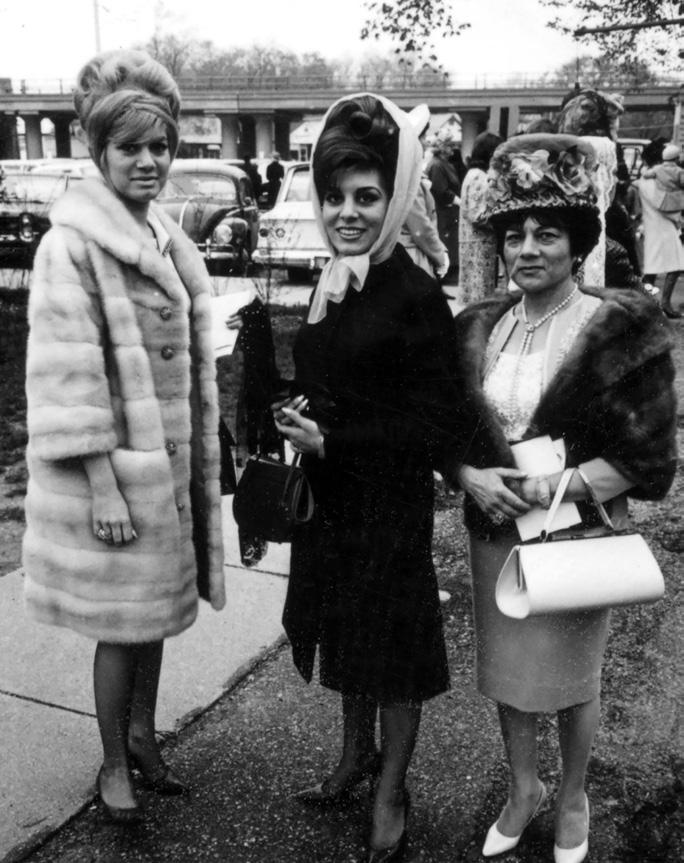


30 N spring 2024 1 5 4 3 2
Written by Kristen Cuppek | Research by Amy Surak
Manhattan College opened its doors to female students in 1973, and women have been making their marks on campus ever since. While today, women make up almost half of the College’s student body, field nine DI athletics programs, and often hold the top positions in many student clubs and activities — not to mention the many alumnae who helm major companies and industries — their introduction and establishment on campus has been an evolution, one that is still unfolding.
As the College celebrates 50 years of coeducation, we look back upon some of the major moments, recognize the tenacious trailblazers, and get a glimpse of the everyday scenes of campus life, captured in 50 photographs from the past five decades. While there are too many milestones and pioneers to include them all, the following pages provide snapshots of their inspirational progress.
1. Marybeth McCall ’74 is the first woman to be inducted into Epsilon Sigma Pi at the Fall Honors Convocation in 1973. 2. Nuns processing at Commencement in 1951. From 1928 until 1954, the Extension Division for Sisters offered training for nuns who went on to teach in Catholic schools throughout the tristate area. 3. Formed in 1935 , the Ladies Auxiliary, pictured here in 1966, was composed of mothers of students and wives of alumni who raised funds for the care of the College. 4 Mary Lynch , associate professor of biology, was named assistant dean of the School of General Studies in fall of 1976 — the first woman named to a deanship. She joined the faculty in 1967. 5. At the Alumni Dinner on March 2, 1974, Patricia Keegan ’73 delivers the closing benediction. 6. A scene from campus in 1973-74.
7. The editors of Chalk Dust , the journal of the School of Teacher Preparation, gather in March of 1977. 8. Patricia Ruback Kehrberger ’69 is the first laywoman to earn an undergraduate degree and major in engineering. 9. Leonora Mirone , associate professor of chemistry, became the first female faculty member when she joined Manhattan in 1957. 10. Women at the forefront of STEM education in the 1970s.
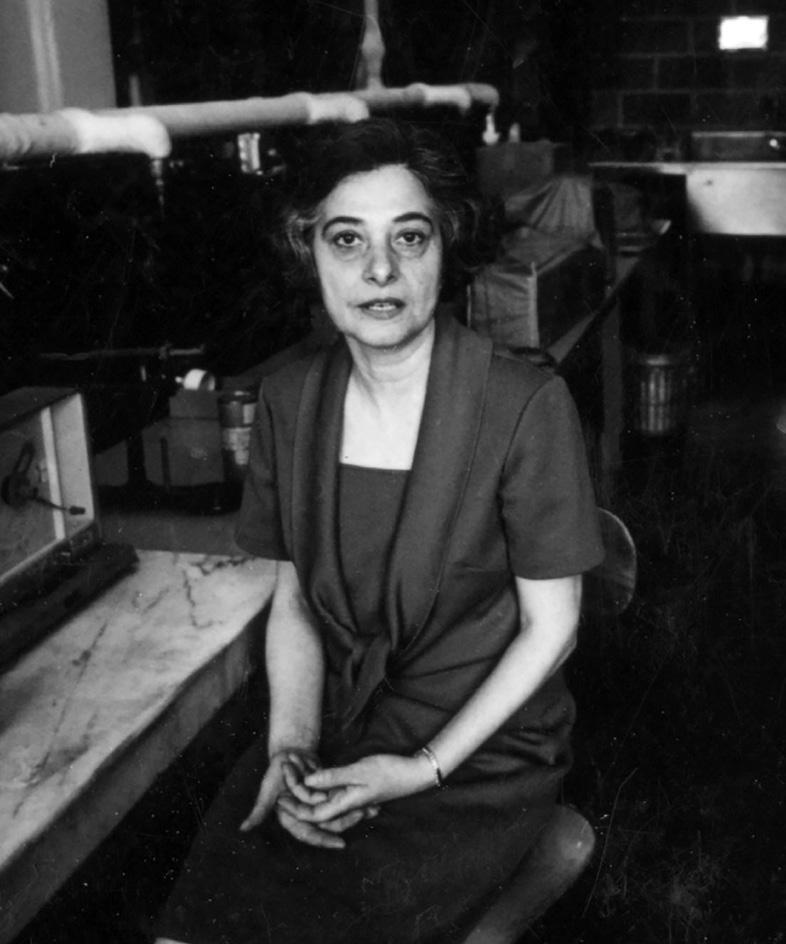
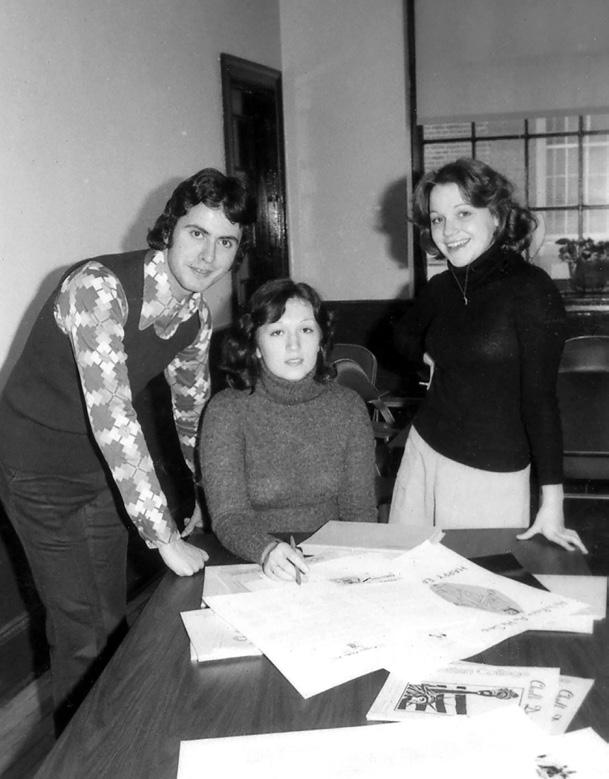
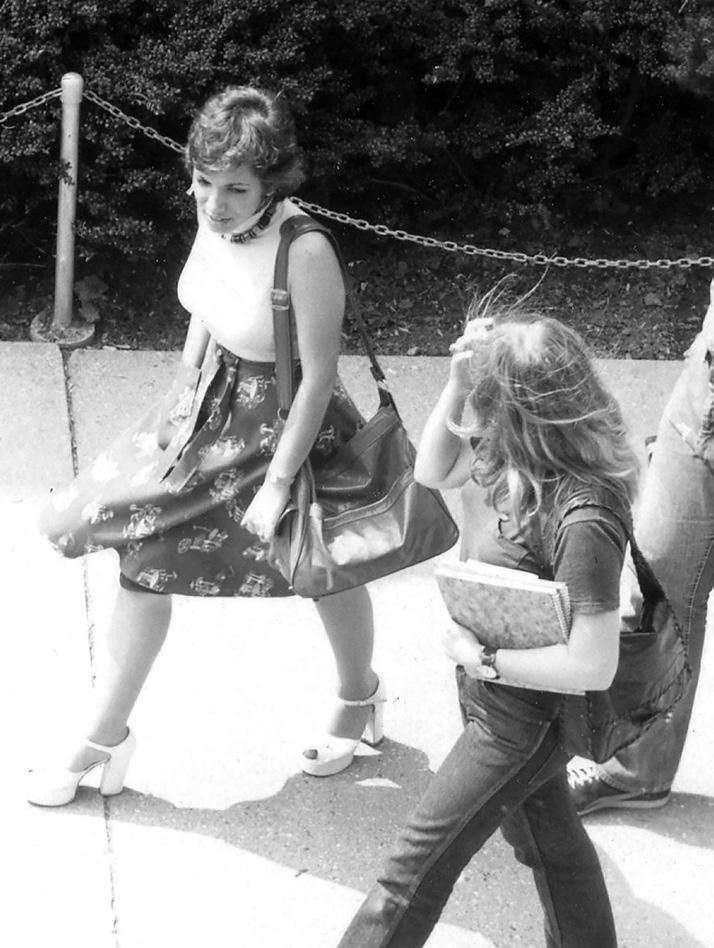


MA nHATTA n .EDU N 31
9 7 10 8 6
While there had been a female presence on campus in earlier years, it was mainly through the Cooperative Program formed with neighboring women’s college, the now University of Mount Saint Vincent, in 1964. It was renamed the Coeducational Program in 1970 when a more formal arrangement between the two institutions was organized. But it wasn’t until the 1973-74 academic year that women were officially allowed to enroll at Manhattan College. Out of approximately 3,000 full-time undergraduates, 43 women matriculated at the College that initial year. Another 192 women also attended part time. The 1960s and 1970s saw a lot of “firsts” for women at Manhattan, which continued into the 1980s, as more female students pushed for and founded sports and activities to suit their interests and skills.
11. A scene from the Quadrangle in spring of 1978. 12. Alpha Sigma Alpha was the first sorority established at the College in 1981. 13. DJ Jean-Marie Carbajal spins some records at WRCM campus radio in the mid-70s. 14. The Pipes and Drums band, circa 1983. Barbara McWilliams ’79 and Collete Fuller ’79, both of Irish descent, thought that the College, with its strong Irish heritage, should have a bagpipe band. After a few years of organizing and raising funds, the Bagpipers became fully active in the fall of 1981. 15. Marie McGovern , the first woman to serve on the College’s board of trustees (from 1971 to 1982), with Brother President Stephen Sullivan, FSC, at the dedication of the plaza named in her honor on Feb. 27, 1983. This ceremony was part of the 10 years of coeducation celebration. 16. Hanging out near campus in 1981. 17. Resident Student Association members help with Moving in Day in 1984. 18. Catching up with friends and the news in 1984. 19. Volleyball was the second women’s sport to become varsity in 1979. Margaret Kreher ’82 goes for the block during that first season. 20. The team that started the women’s athletics program, basketball, was promoted to varsity status in 1978. During the 1986-87 season, the Lady Jaspers boasted a 20-11 record and won the MAAC Championship, earning their first trip to the NCAA Tournament. 21. Education students present to the class. 22. A moment of reflection from Commencement in 1984. 23. The Quadrangle staff in 1986-87. 24. Jaspers engage in an arts and science classroom in the 1980s. 25. Students working in a computer lab in 1988.
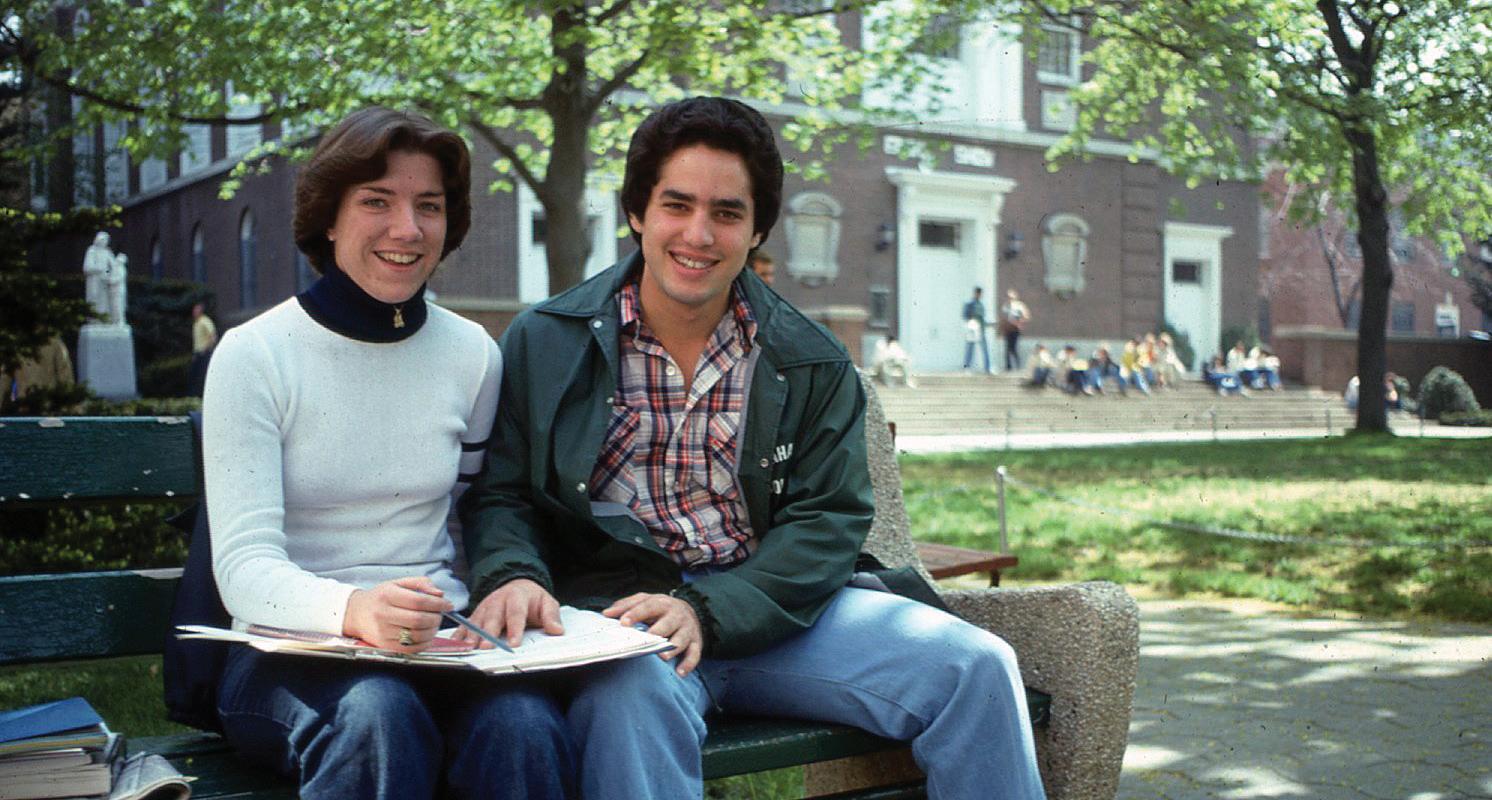



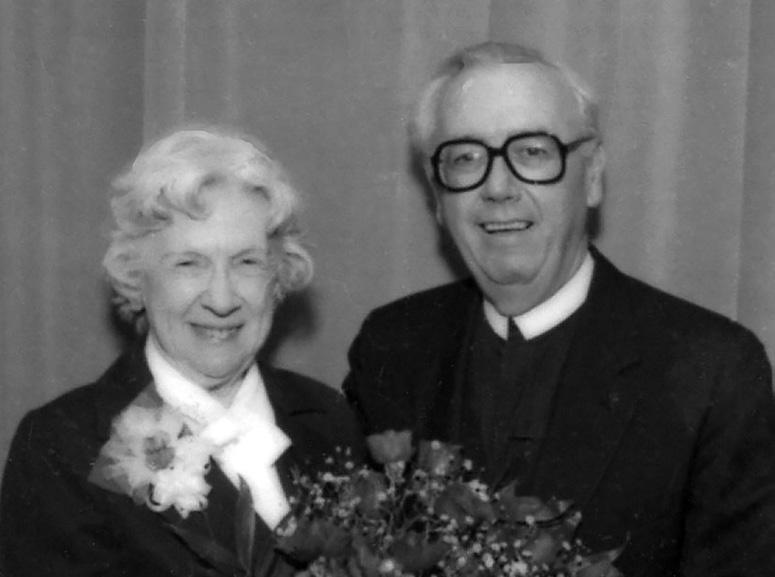
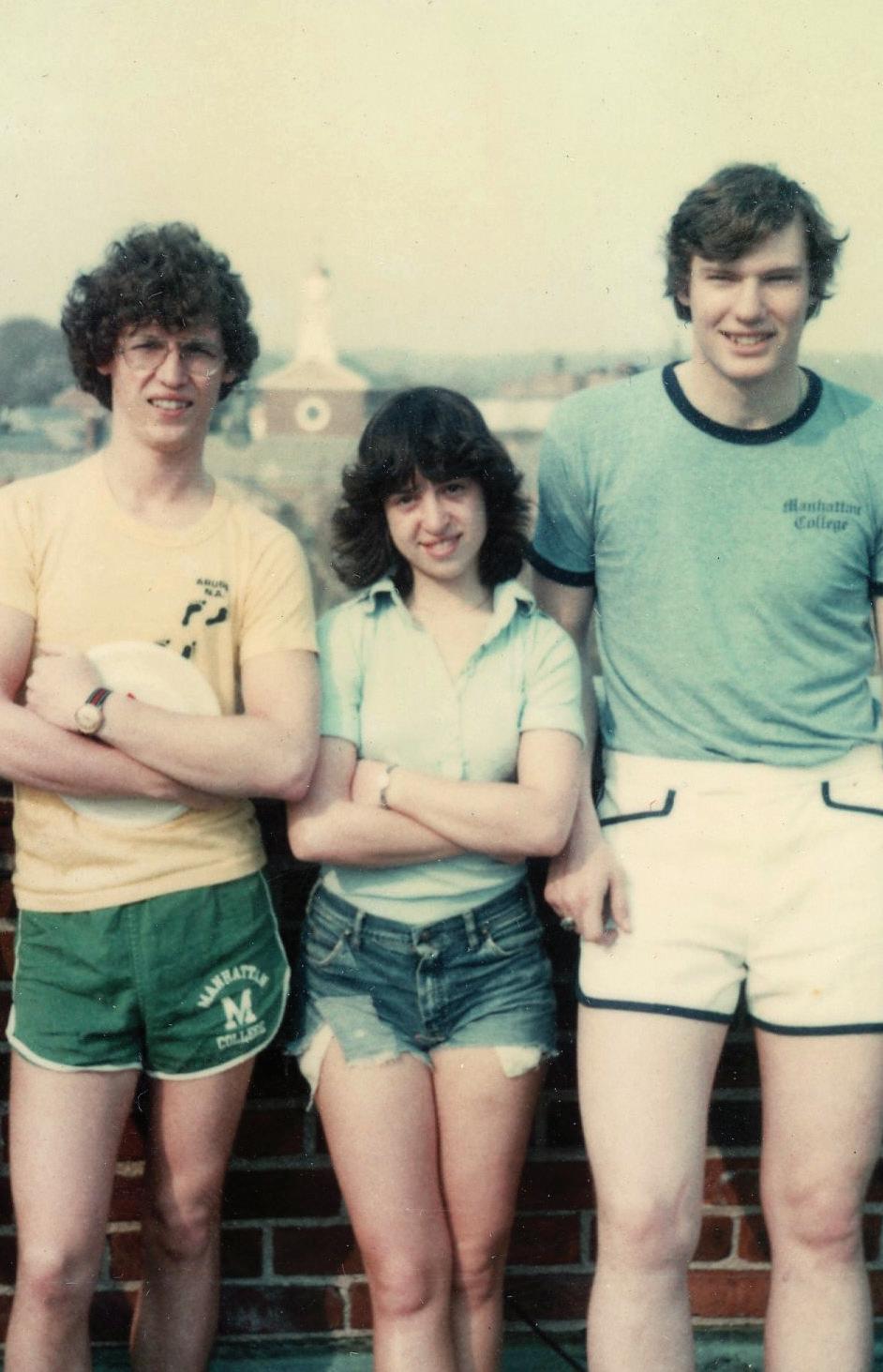
32 N fA ll spring20152024
11 13 14 15 16 12




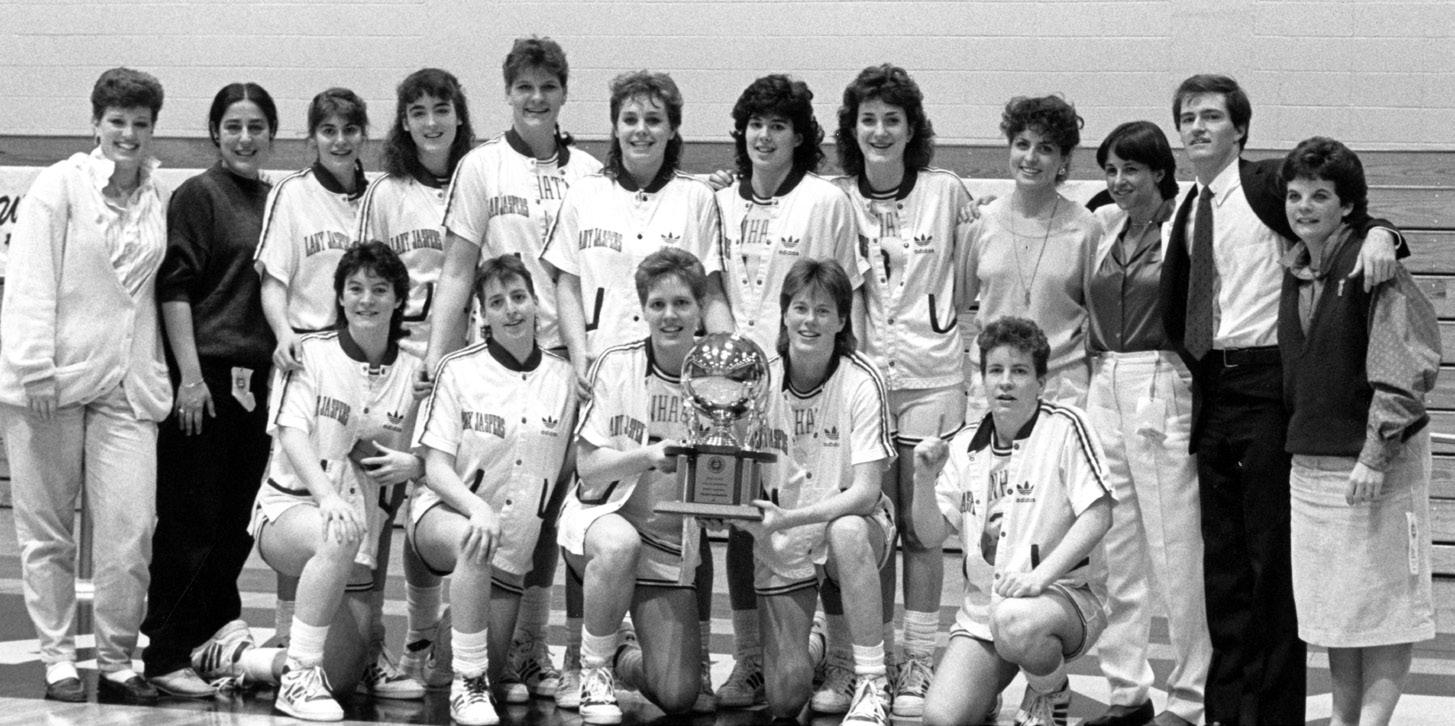

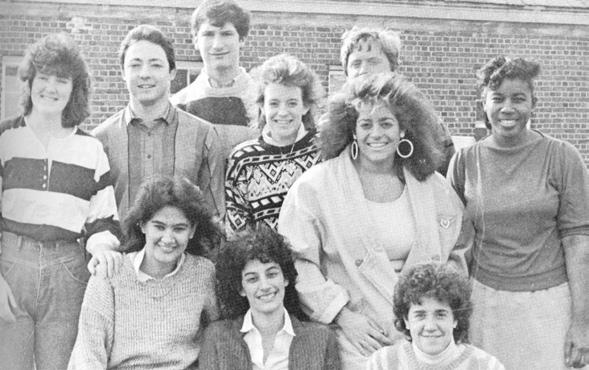
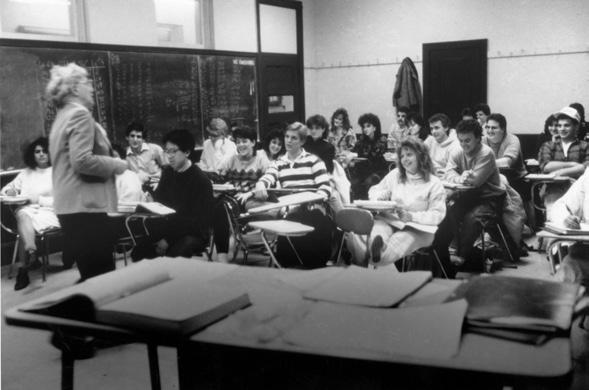
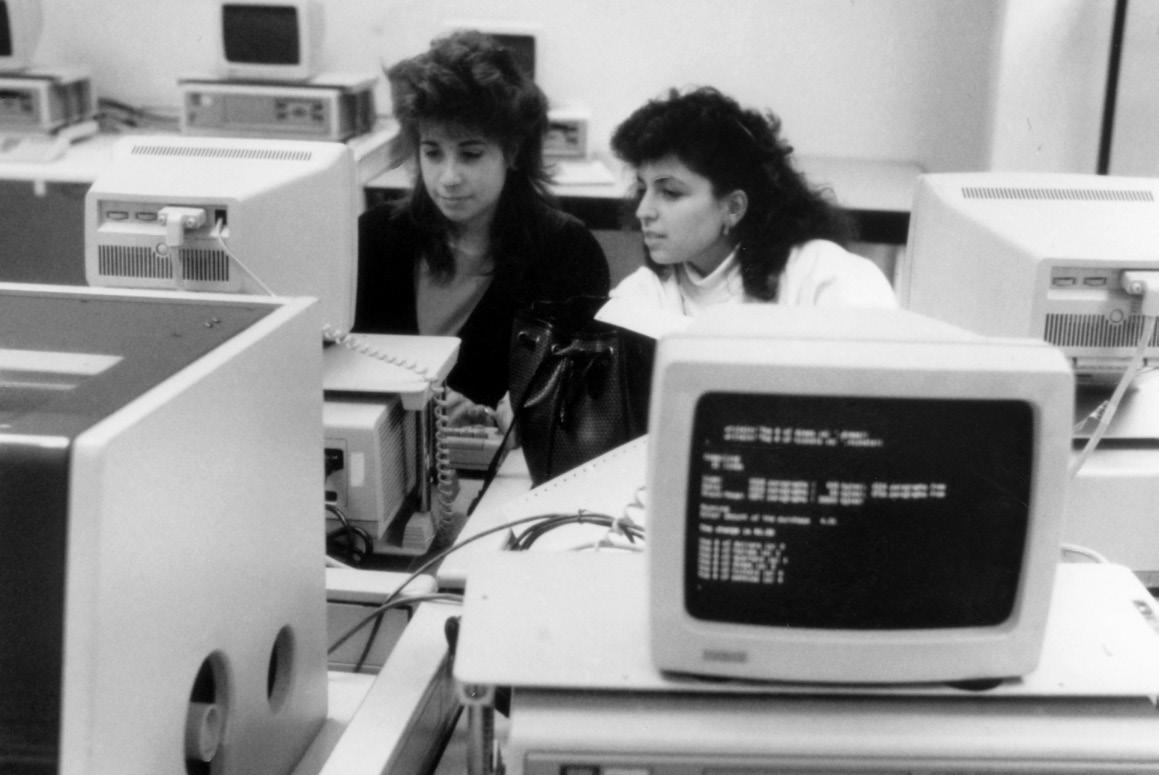
MA nHATTA n .EDU N 33 17 19 20 21 22 23 24 18 25



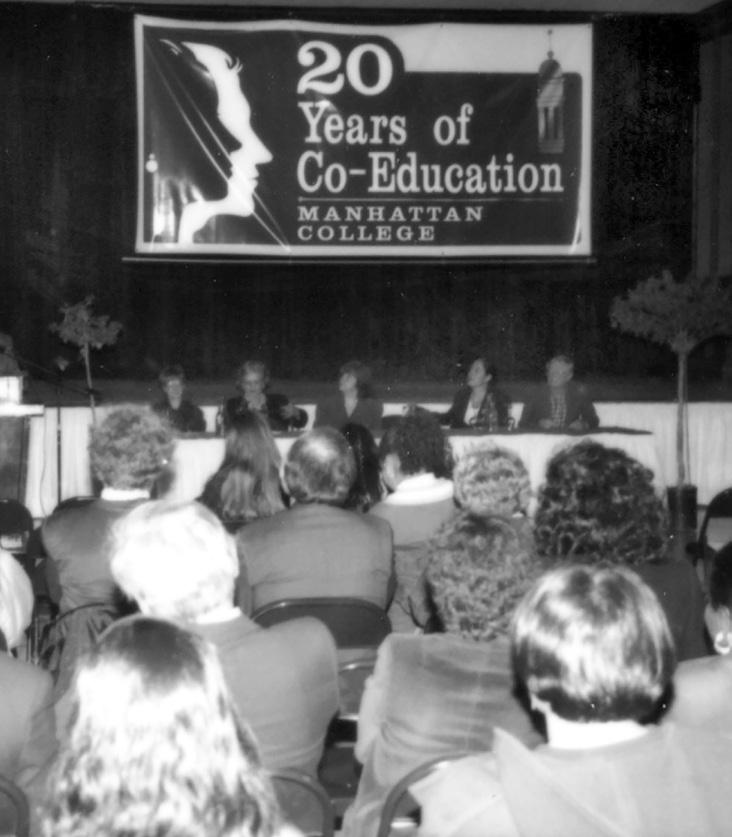
26. Orientation leaders gather for a group photo in 1992. 27. Marianne Reilly ’82 is the first woman inducted into the Athletic Hall of Fame in 1992, as well as the first female to score 1,000 points in basketball. She also served as the College’s first female athletic director, appointed in 2016. 28. Dine Potter ’97 becomes the Jaspers’ first female Olympian when she represented Antigua and Barbuda at the 1996 Atlanta Games. 29. Graduates at Commencement in 1994. 30. The College kicks off its 20 years of coeducation celebration in March 1993. 31. Building on their momentum , the Lady Jaspers were the MAAC champions once again and took another trip to the NCAA Tournament in 1989-90. 32. The Manhattan College Singers perform in Europe in 1998. 33. The women’s lacrosse team is elevated to Division I in 1997. 34. A sweet moment among friends in 1998-99. 35. Alumnae gather at the College’s Sesquicentennial Celebration in 2003. 36. A group of Jaspers get ready to rock out at Quadstock on campus in 2002. 37. The softball team wins the MAAC Championship for the first time in 1999. Heather Marshak ’00, Julianne Soviero ’02 and Christine Lamb ’01 share a victorious hug. Softball became a varsity sport in 1981. 38. Graduates applaud one another at Commencement in 2004. 39. Education students confer with Corine Fitzpatrick, professor of counseling and therapy, in 2000. 40. A student works on a lab experiment in 2005.




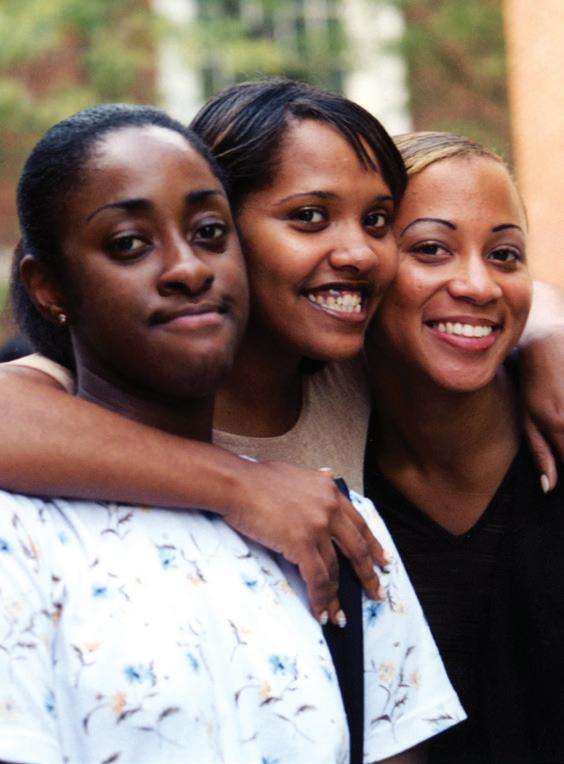
34 N spring 2024 29 30 31 32 33 34 28 26 27
By the 20th anniversary of coeducation in 1993-94, women comprised 42% of the undergraduate population, and 47% of new full-time, first-year students. The College held a yearlong celebration of this major milestone with a mix of career seminars, workshops and commemorative events, made all the more meaningful by the participation of alumnae, faculty and friends who served as moderators.
The 1990s bore witness to more debuts as female Jaspers sucessfully established themselves even further into campus life, academics and activities. Women’s sports were growing and thriving. Female athletes excelled at all levels of competition, including globally, when Dine Potter ’ 97 became the College’s first female Olympian when she sprinted in the 1996 Summer Games.
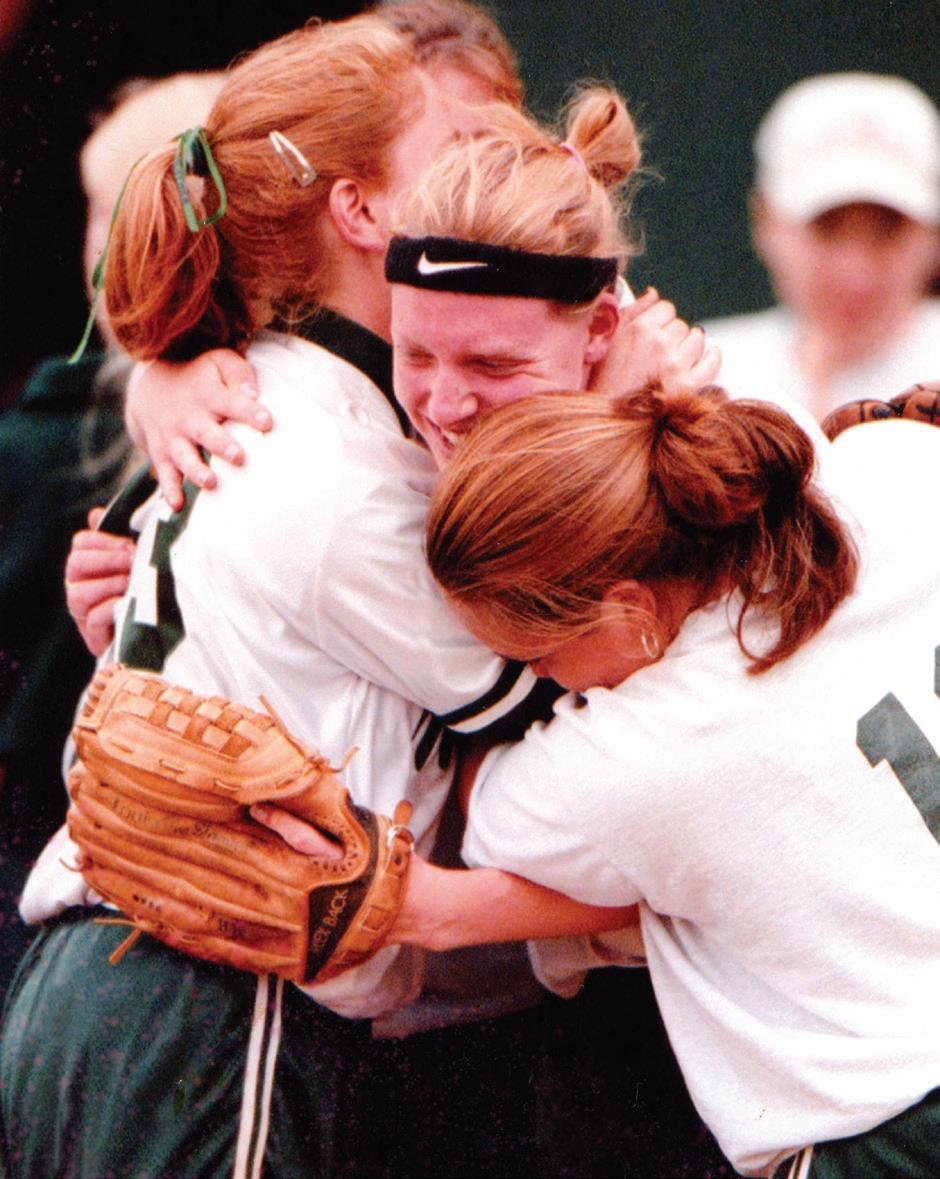




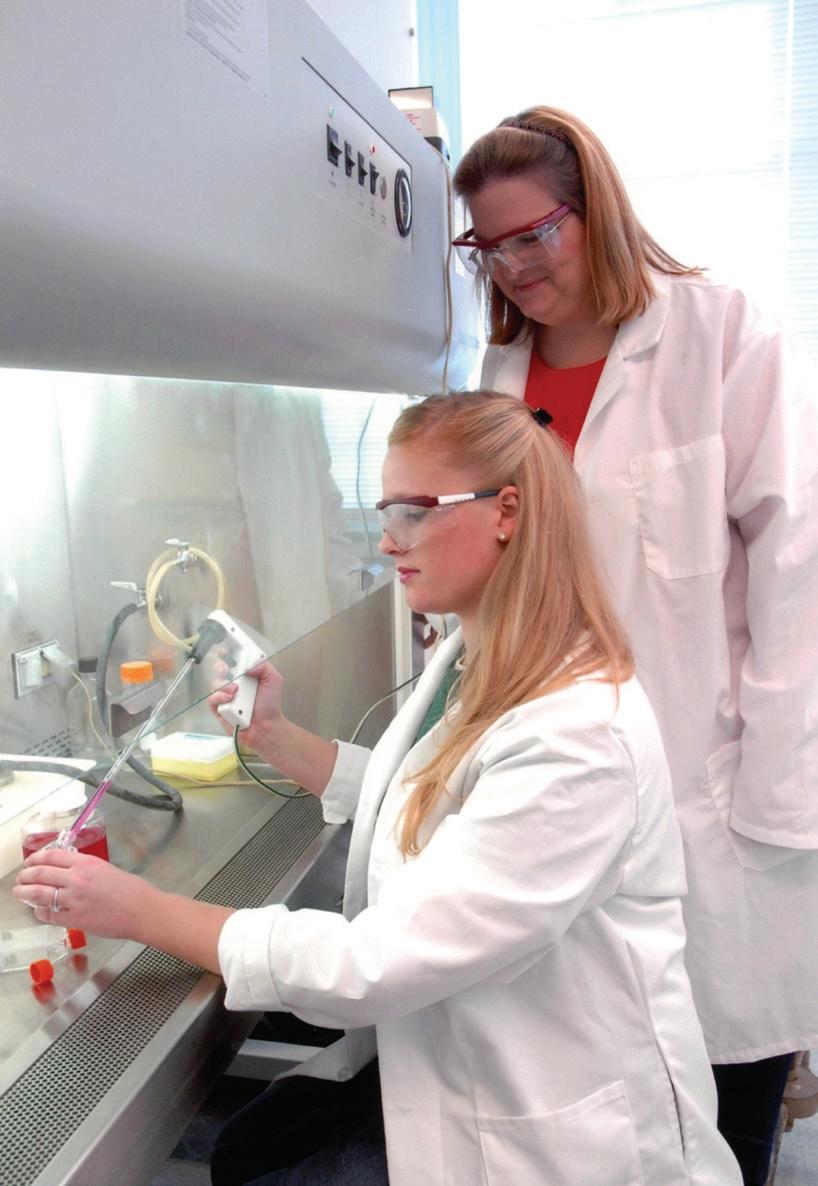
36 37 38 39 40 35 MA nHATTA n .EDU N 35
In the past decade, Manhattan College has continued to see its female students, faculty and alumnae achieve even greater accolades and compete on national and international stages. Women have comprised four of the past six valedictorians at Undergraduate Commencement. The College had a recordbreaking year for Fulbright Awards when three alumnae earned the prestigious honor in 2019-20. When the Jasper Dancers took home the DI Hip-Hop title in 2019, it was the first time that any Manhattan College team had won a national title since 1973. Softball star Elena Bowman ’16 was the unanimous MAAC Player of the Year in 2015. Female faculty members are sought-after industry experts, bringing in grants from esteemed organizations such as the National Science Foundation, and lead cutting-edge curriculum additions and research efforts. Manhattan alumnae build bridges, report the news, work at NASA, educate children, tour with their own bands, and find success in every sphere. And the list goes on and on. If today’s Jaspers are any indication, there’s no telling how far Manhattan women will go in the future.
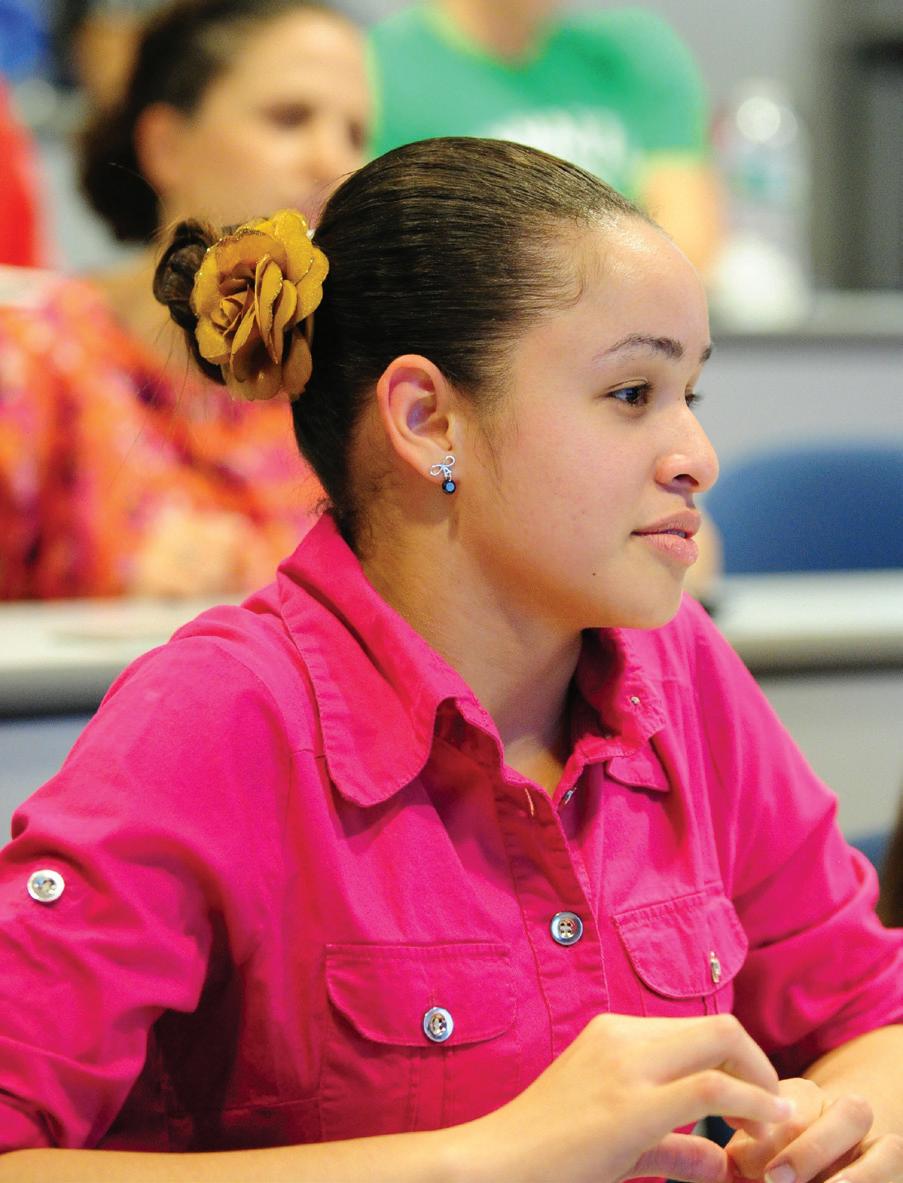
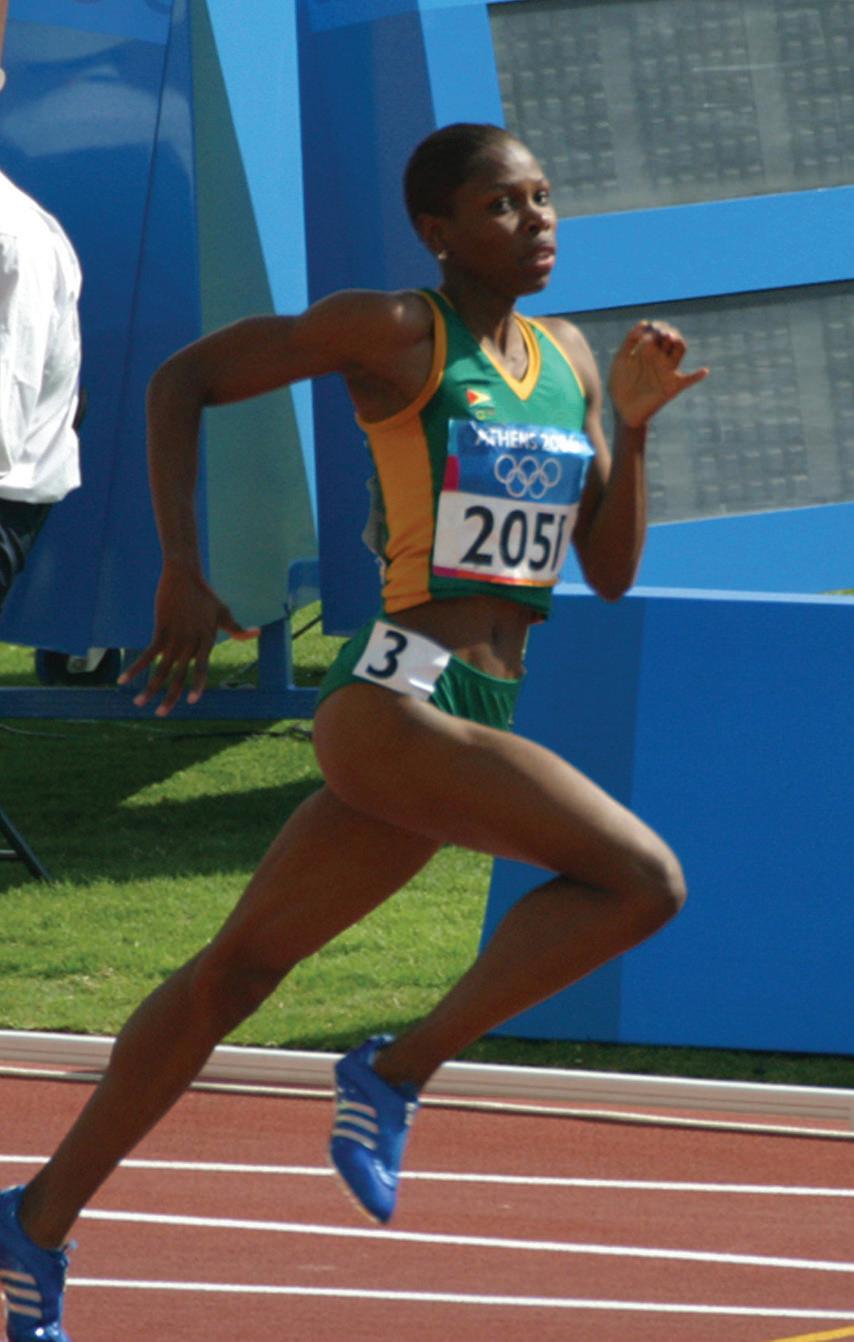
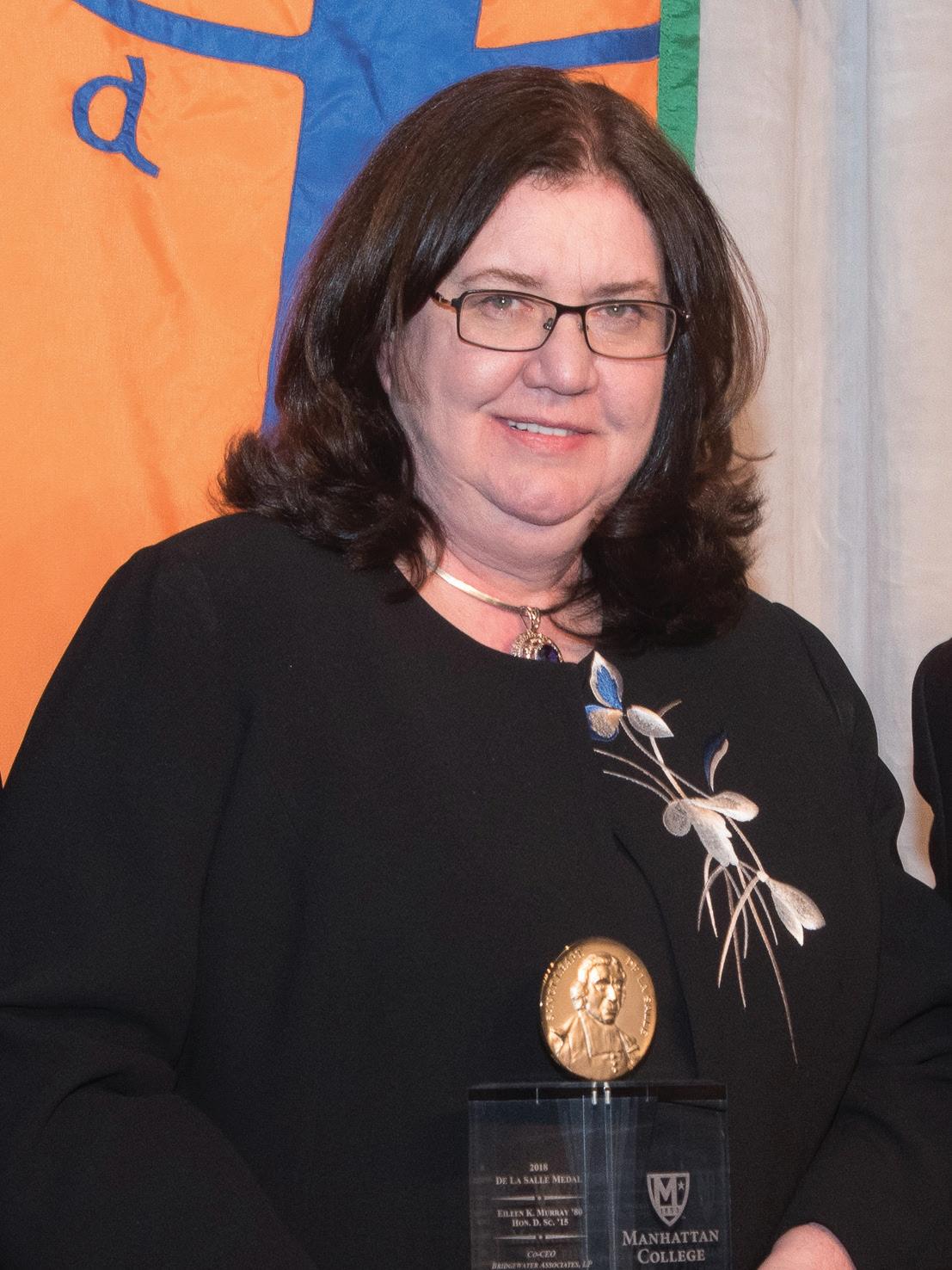

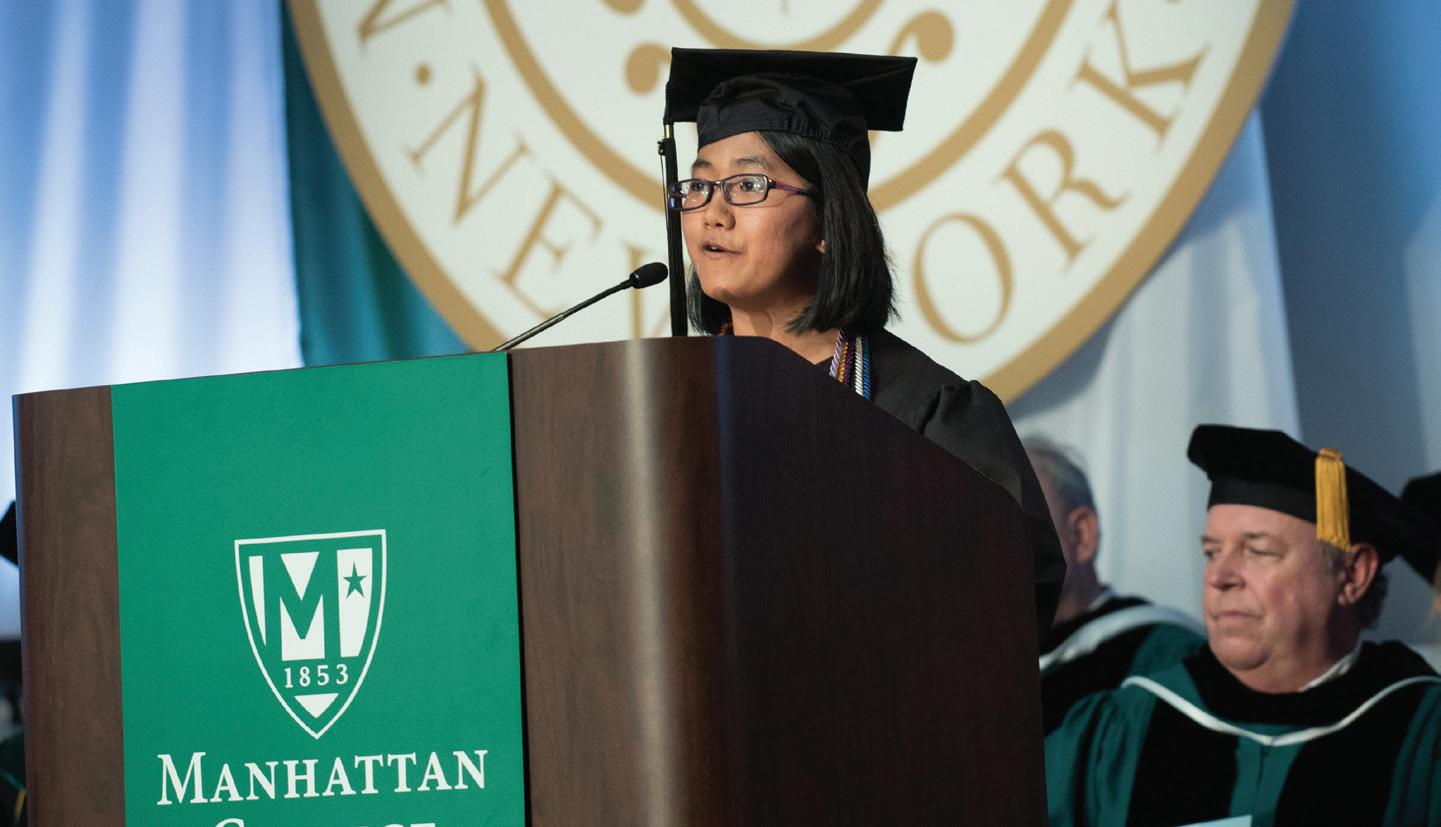
36 N spring 2024
41 43 42 44 45
41. Aliann Pompey ’99 is the first woman at Manhattan to win an NCAA National Championship when she wins the 400-meter event at the 2000 NCAA Indoor Championships in a time of 52.27 seconds. Pompey represented Guyana at the Summer Olympics on four separate occasions (2000, 2004, 2008 and 2012) and has competed at the World Championships five times. 42. Eileen Murray ’80 is the first alumna honored at the De La Salle Dinner in 2018. At the time, she was co-CEO at Bridgewater Associates LP, a premier asset management firm. 43. A few Jaspers walk down the path along the recently opened Kelly Commons in 2015. 44. A student attentively listens in class in 2013. 45. Cambodian-born Kimsy Tor ’15 moved to the U.S. at the age of 18 to begin her freshman year at Manhattan College. Four years later, the mathematics whiz addresses her fellow classmates as the 2015 valedictorian at Commencement. 46. The Center for Career Development launches W.I.S.E. (Women Inspiring Successful Enterprise) in 2018, a professional development program that matches female students with an eight-week paid summer internship. 47. In a VR: Perception & Production class, a student explores human perception in natural and virtual environments in 2022. Students are introduced to the Unreal Engine and build a VR environment in which perception deviates from natural reality. 48. The Women Gender and Resource Center opens in 2018, signaling a commitment to combine resources, support and advocacy for students having experiences related to gender, sexuality, including sexual assault prevention and gender justice. 49. The Jasper Dancers win the 2019 National Dance Alliance Championship in Division I Hip-Hop in Daytona Beach, Florida. 50. In a General Chemistry lab, Maria De La Paz Gonzalez ’26 analyzes synthesized salt for oxalate content during a lesson in oxidation-reduction reactions in the Higgins Engineering and Science Center in 2022.



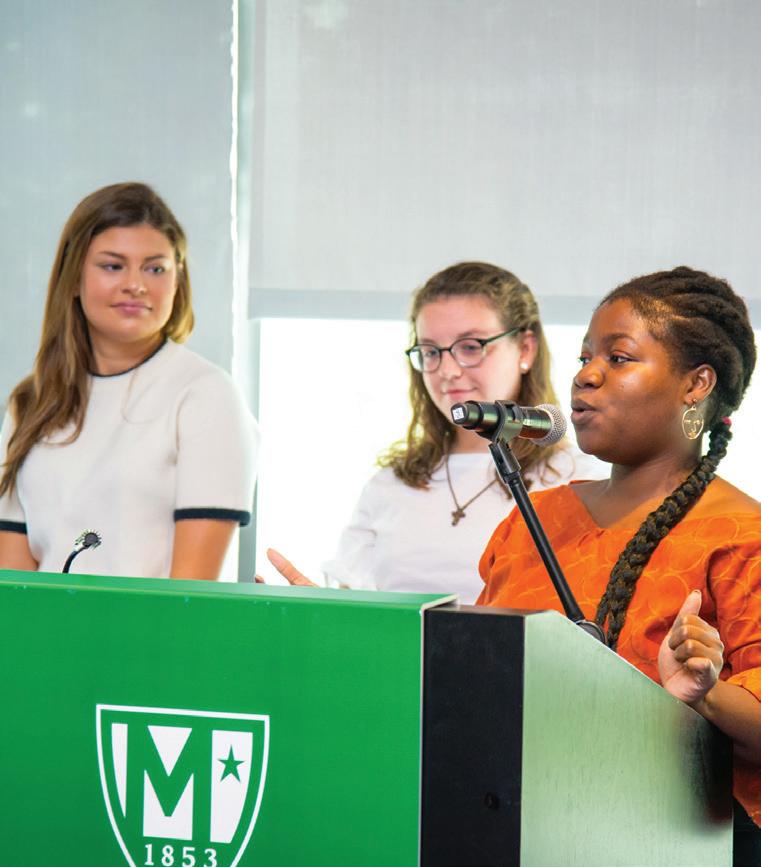
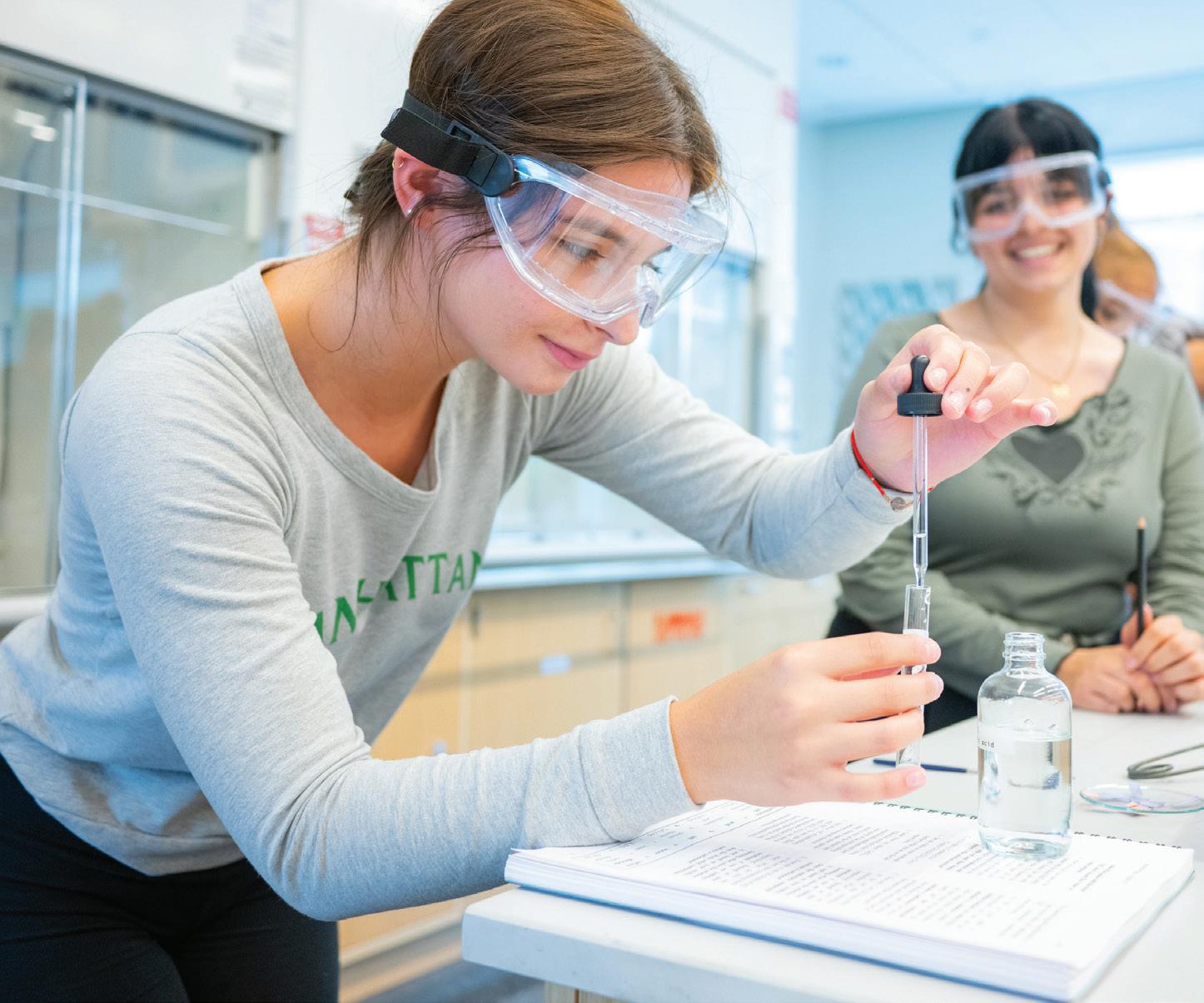
MA nHATTA n .EDU N 37 46 49 50 47 48
by Cecilia Donohoe


“ACE National is about 70% minority and women. That’s why we started, and it’s succeeded beautifully. We now, with our 70 affiliates across the United States, pretty much have every major engineering firm, every major architectural firm, every major contractor and subtractor, plus the unions including the bricklayers and the ironworkers. They are all involved.”
The late Charles Thornton ’61, ’13 (Hon.Eng.) recorded those words as part of a video message shared with high school students who visited Manhattan College in December 2023 for ACE Mentor Day, which promoted an organization he founded in 1994. Now celebrating its 30th anniversary, the ACE Mentor Program introduces approximately 10,000 young people to the construction industry each year — and the possibilities and potential it holds for their education and careers. From the very beginning, Manhattan College has been a vital partner, and, as you’ll read here, remains one to this day.
How It Started: “Let’s Take Care of Business”
In the late 1980s through early 1990s, the construction industry was in a bind: there weren’t enough students graduating with engineering degrees to fill demand. As a May 1990 New York Times article noted, “… the number of students studying science and engineering is expected to decline as the college-age population shrinks.”
The article also quoted Betty Vetter, executive director of the Commission on Professionals in Science and Technology, who said: “Even if we hire every engineering graduate in the coming years, it is unlikely there will be enough technical talent to meet skyrocketing demand because there are so few students in the pipeline.”
Unsurprisingly, Manhattan College, like many institutions around the country with engineering programs, was feeling the pinch. Walter Saukin, associate professor of civil and environmental engineering, and a longtime nurturer of young engineering talent through his summer engineering programs for high school students, recalls that period vividly.
“The industry itself was experiencing a trend in the loss of manpower,” he says. “The saying went, ‘For every five that we lose, we pick up one.’”
Seeking to recruit a new crop of engineers to satisfy demand from the construction industry, Manhattan College leaders including Joseph Lestingi ’57, dean of the School of Engineering, reached out to alumni for help in generating young people’s interest. Chief among those alumni was Thornton, co-founder of the pioneering engineering firm Thornton Tomasetti, who took an active interest in addressing the issue. (Thornton passed away in December 2023. See obituary, page 63.)
“Charlie was a high-energy particle, always moving,” Saukin notes. “The kind of guy who is not going to wait. He’s going to say, ‘Let’s go and get them ourselves. Let’s take care of business.’”
Thornton turned to his employees and asked them to give back by mentoring high school students. He also brought firms like Turner Construction on board and reached out to local high schools.
38 N spring 2024
(Left) Former ACE mentee and current Dr. Charles Thornton – ACE Mentor Program Scholar at Manhattan College, Stephanie Santos ’27, shares a practical construction exercise she completed with her fellow mentees. (Right) Charles Thornton ’61, founder of the ACE Mentor Program, views an ACE student project presentation to pupils in 2001.
“They brought in some architects, and they realized that they had something; they could sell the industry versus just engineering,” explains Thornton’s daughter, Diana Eidenshink, who has served as the president of the ACE Mentor Program of America since 2017. “Then they really started to put together a plan for helping these kids get to college. They did a scholarship program, and it took off.” Thus, the ACE Mentor Program (denoting architecture, construction and engineering) was born.
In 1994, ACE’s first year of operation, 17 firms banded together to create three teams, each organized like a typical design and construction team. Approximately 90 students from New York City area high schools participated. Volunteers from each of the firms served as mentors and worked directly with the students to introduce them to the broad range of people and projects within the construction industry.
Saukin, who had been running his summer engineering program at Manhattan since 1982, was one of many members of the College community who aided the budding venture. He shared his mailing list with ACE, providing the organization with hundreds of potential participants. ACE, in turn, has been a sponsor
of his summer programs from its early days.
“Once ACE began rolling, they began supporting the summer program immediately,” he says. “And I would publicize ACE in my program. So if I got 600 names, they got 600 names of kids who expressed an interest.”
ACE Expands: “Engage, Excite, Enlighten”
In 1998, the growing mentor program expanded beyond New York to New Jersey, and then to Connecticut the following year. Jaspers continued to serve as its bedrock.
Milo Riverso ’81, president of Manhattan College, joined the organization in 1998, when he received a call from Thornton and Rino (Ray) Monti ’52, chief engineer of the Port Authority of New York and New Jersey. At the time, Riverso was president of the School Construction Authority of New York City.
“They briefed me on ACE’s purpose, and it sounded like a good purpose,” he recalls. “The thought was to engage, excite and enlighten. Those were the three E’s: Enlighten high school students on the career path of doing architecture, construction and engineering. Excite them about it. And then engage them by
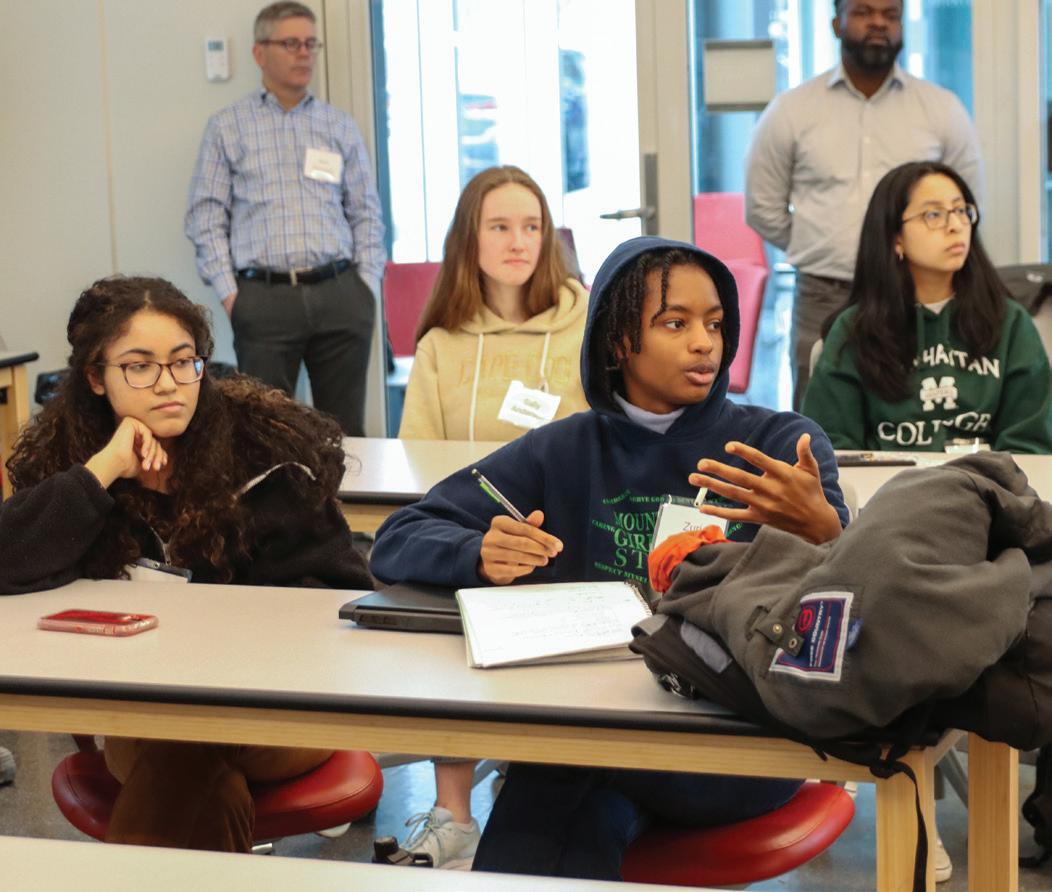
getting them to go to college.”
He served on the board of the Greater New York affiliate for 10 years. In 2008, Riverso received another call from Thornton.
“He said, ‘It’s time for you to become chairman of the board,’” Riverso says. He held that role for eight years, during which time he worked to raise scholarship funds and created the ACE Foundation for New York. During his tenure, the number of mentoring teams grew from 15 to 43.
“You had an owner mentor, an architect mentor, a mechanical engineer, an electrical engineer, a structural engineer and a construction manager,” he explains. “The industry stepped up to produce those mentors. Now there are 150 firms, 600 mentors and 1,800 students registered in New York City.”
Riverso later joined the board of the National ACE Mentor Program and remains a member of the executive committee of the board of directors for the national organization.
“ACE was born out of a need for engineers for enrollment, and Charlie came up with a very elegant solution,” Riverso concludes, referencing Thornton’s 2014 memoir, A Life of Elegant Solutions (CreateSpace, 2014).


Fly on the Wall: An ACE Mentoring Session
(Left) Zuri Jackson, a high school senior, is in her second year of participating in ACE. Her team is led by Ozzie Calderon ’97, ’99 (M.S.), of Yonkers Contracting (middle photo). At a recent session, several mentors gave presentations on various aspects of the construction process for a substation at JFK Airport, including bidding, estimating and mandatory drawings. (Right) Samuel Brown ’23, a recent hire at Yonkers Contracting, shared with students his experiences as an engineer during his first 26 days on the job. Jackson says, “Getting to see their [the mentors’] perspective and hear about the project and any other similar projects that they have worked on is a very enriching experience. I’m very excited to work with them.”
MA nHATTA n .EDU N 39
How It’s Going: “A Win-Win for Everyone”
ACE’s aims complement Manhattan’s Lasallian mission and longstanding history of educating first-generation college students.
“We realized very early on that there are many high school students out there who, regardless of race or gender, really are just looking for help,” Eidenshink says. “A big part of our mission is to help bring in a better-prepared, more diverse workforce for the construction industry, and help youth identify a career path and hopefully break the cycle of poverty and show them that there are some wonderful things out there for them to do.”
Ben Boivin ’09, ’15 (M.S.), director of admissions for Manhattan College, agrees. “We’re seeing incredible growth in the program from 1994 until today,” he says. “It just goes to show the power of a STEM education and what it can do for social mobility. These students have a lot of potential to go on and change the trajectory of their future, especially first-generation college students.”
All ACE mentoring teams follow a general formula. Between October and May, groups meet every other week and work on projects that are either theoretical or, in some cases, based on “real-world” construction projects outlined by mentors. Each team emulates an actual design team, with students guided through a design project by their architect, engineer, construction management and tradesperson mentors. Even the icebreakers, like building gumball bridges and popsicle stick structures, are based around construction industry concepts. Mentors assist the students as they work toward a final project, introducing them to the careers, industry vocabulary and various roles companies play in the construction industry.
Mentee Testimonial
NICHOLAS BADILLO ’24, ’25 (M.S.) participated in the ACE Mentor Program during his junior and senior years at Salesian High School in New Rochelle, New York. He worked with teams based out of the White Plains, New York, office of H2M Architects and Engineers. Now a senior at Manhattan, Badillo is double majoring in civil engineering and mathematics, with a minor in environmental engineering. He is also pursuing a master’s degree in environmental engineering. Badillo shared his memories of his participation in ACE, and how it has influenced him.
What are some takeaways from your experience as an ACE mentee? What ACE really taught is the big picture. That’s important for students to grasp, because oftentimes we see a building being developed and get the idea, ‘The construction workers are just following a Lego booklet to build it,’ but that’s not true. We learned about the inner workings of the building. We got acquainted with riser diagrams, where we drew the diagram of the utilities in the building. We got familiarized with AutoCAD software, which is how you draft architectural and engineering plans.
What did you find particularly interesting about the experience?
ACE is very interdisciplinary. So it’s not just the civil engineers or mechanical engineers. It’s also the people who would be interested in marketing a certain business in that development or maybe the artist interested in architecture, and they’ll be designing what material is used for the facade.
The teams meet for approximately 15 sessions, for about two hours after school, usually on the same day each week. In addition to these team sessions, there are also all-team activities such as “College Night” and field trips to construction sites. Meetings are held either in schools or at firm offices. At the end of the year, all of the affiliate’s teams gather for a final presentation night where they present their designs to other teams, their families, teachers, prospective mentors and program leaders.
ACE mentor programs are now active through 75 affiliates in more than 200 cities throughout the country, and the Manhattan College community continues to be at the forefront of recruitment efforts for ACE participants and mentors. In the original affiliate, ACE Mentor Program of Greater New York, the first three board chairs were all Jaspers: Thornton, John Magliano ’66, chairman emeritus of Syska Hennessy Group, and Riverso. Active board members include Arthur Alzamora ’03 (Langan), Andrew Hlushko ’83 (Collado Engineering) and Roxana Escobar Kariyannis ’08 (AECOM). And, of course, the ranks of dedicated ACE mentors are peppered with Manhattan alumni like Matthew Sangen ’14, ’16 (M.E.) (STV Inc.), Mario DiMondo ’15, ’16 (M.S.) (Collado Engineering) and Anthony Gallo ’14, ’19 (M.S.) (Keller).

Did participating in ACE help you solidify your college major?
I’ve been very committed to studying engineering, math and science from a young age, but ACE put me in the direction of infrastructure. I had toyed with chemical engineering as a major, but looking at environmental engineering and how that infrastructure gets put together, and how it contributes to public health was a very important career aspect for me.
Did ACE figure in your decision to attend Manhattan College?
ACE was a huge part of that decision. I had applied for the Dr. Charles Thornton – ACE Mentor Program Scholarship and received it, so that was a large part of the financial decision. But I was convinced by Dr. [Walter] Saukin, [associate professor of civil and environmental engineering]. I firmly believe that we have such an incredible group of professors, particularly in environmental engineering. I love those people over there.
Any other positives from your participation in ACE?
I think it’s important to have an idea of what the engineering industry really is like before you get to your calculus and your physics classes. You really have to have an idea of what this stuff means and what that even looks like.
40 N spring 2024


ACE Mentor Day
IN DECEMBER 2023, THE FIRST ACE MENTOR DAY was held at Manhattan in conjunction with the College’s Admissions office. A second event was held in March 2024. At both events, high school students and their families were welcomed to the Manhattan campus for tours, an information browse with representatives from firms that participate in ACE, one-on-one conversations with faculty and administrators, and résumé advice sessions. Two alumni panels shared their experiences with ACE and perspectives on the fields of architecture, construction and engineering.
At the March event, Stephanie Barros, a rising junior at Yonkers Middle High School, said that the day “definitely opened my mind to applying to the ACE program. Getting exposed to engineering, construction and architecture will help me decide if I want to study them in college.”
Her father, Fausto Barros, noted, “I believe that there are a lot of students who can benefit from programs like this that will guide you when you are preparing for college. One of the hardest things when you go to school is to decide what your major is going to be.”
Andrew Hlushko ’83, principal at Collado Engineering, participated on an ACE panel. He says, “From a student perspective, hearing from industry leaders and professionals while you’re in the program could do two things: help you decide that the construction industry is for you, or lead you to decide that it’s not for you. But it helps you learn a lot about many different aspects of the industry, different phases of engineering disciplines and guide you to a career or course of study.”
As a father was departing with his student, a high school junior who participates in an ACE team in Lower Manhattan, he stopped to share the family’s impressions of Manhattan’s mutually beneficial relationship with ACE.
“We don’t like it,” he said. “We love it!”
It’s a very unique partnership,” says Sue Veres Royal, executive director of the ACE Mentor Program of Greater New York. “We’re hoping other universities will use this as a model.”
DiMondo’s ACE team works with volunteers from H2M Architects and Engineers and meets in H2M’s offices in White Plains, New York.
“ACE can be that bridge from high school to what we do, so that when you step into college in freshman year, you’re not seeing everything for the first time,” he says. “It’s an eye-opener.”
Gallo has worked with mentees to plan a hypothetical park and amphitheater in Westchester County, in which students were given reallife constraints like zoning restrictions, budget and site selection.
“I see participation in ACE as an interview opportunity for students,” he says. “We’ve hired students as interns and then hired them out of college.”
Alzamora mentored for 10 years before transitioning to the ACE Greater New York board. He has run into people at meetings that he previously mentored who are now working in the industry. “To see that come full circle is a great feeling,” he said.
Two ACE teams are currently based at the College. Ozzie Calderon ’97, ’99 (M.S.), senior vice president at Yonkers Contracting Company, is the lead mentor of one of the teams. When applying to Manhattan, ACE mentees receive an application fee waiver, preferential application review, and are eligible to receive a $10,000 scholarship over four years. In addition, a Dr. Charles Thornton – ACE Mentor Program Scholarship is awarded to one incoming first-year student each year.
Anirban De, interim dean of the School of Engineering, says that when ACE scholars graduate from college, “They put ACE on their résumés, and I’m sure that makes them more attractive to employers who know about ACE when they’re hiring.”
As ACE celebrates its 30th anniversary, its partnership with Manhattan is going from strength to strength.
“It’s really nice that we’re in a position, as we celebrate our 30th year, where we’re really renewing the special relationship between Manhattan and ACE Greater New York,” says Sue Veres Royal, the affiliate’s executive director. “It’s a nice time to reflect on what the College and the organization have done together, and I think there’s a lot more that we can do together.”
Eidenshink reflects on her father’s legacy at ACE and, by extension, the College. “At his celebration of life, it was said over and over again: ‘Nobody ever said no to Charlie Thornton,’” she says. “He would tell them that there was no reason not to get involved. It helped companies with recruitment and the development of their employees. You were giving back to your community, you were giving back to your industry, you were helping your employees. It really was a win-win for everyone.”
MA nHATTA n .EDU N 41
(Left) Alumni engineers Natalie Kovac ’07, ’08 (M.S.), Arthur Alzamora ’03 and Roxana Escobar Kariyannis ’08 speak during a panel discussion about the benefits of participating in the ACE Mentor Program. (Right) Thirty years after ACE’s inception, Walter Saukin, associate professor of civil and environmental engineering, continues to promote the mentoring organization to aspiring construction industry professionals.

Pedro Sanchez ’24: A Leader to Others –and Himself
CIVIL ENGINEERING MAJOR PEDRO SANCHEZ ’24 DRAWS HIS INSPIRATION for a career in sustainable construction from his own life. “I grew up in affordable housing, and I can tell you right now that the quality is not there,” he says. “A factor of sustainability is also equity, so that’s how I want to give back to society.”
The Yonkers, New York, native graduated from Yonkers High School in 2016 with his sights set on studying engineering at Manhattan, but finances stood in the way. Instead, he earned an associate degree in engineering science from Westchester Community College and took civil engineering classes at City College until the pandemic struck in 2020.
“Remote classes were not a good environment for me,” he recalls. Sanchez took time off from school to work and save money in pursuit of his ultimate goal — a degree from Manhattan College.
In August 2021, having received a Trustee Scholarship from the College, Sanchez entered Manhattan’s civil engineering program. One of the most satisfying aspects of his studies are the interactions with his classmates.
“We spend hours studying and working on projects together,” he says. “We share the same struggles, we’re thinking about the same things, and we’ll just talk about it.” It’s not all work, all the time, he adds. “We enjoy ourselves.”
His contributions to group projects have also kindled his innate leadership qualities, Sanchez notes. “There are a lot of situations where I find myself being the study leader and am the one taking the initiative to get things going,” he says. “I’ll start off guiding people through the questions — teaching the material to other people means that I know it myself, too. And when I don’t know it, we all work together to figure it out.”
He also is an active member of the Manhattan College chapter of the Society of Hispanic Professional Engineers (SHPE). As internal vice president, Sanchez manages fundraising and logistics in order for club members to participate in workshops and attend conferences. They made the trip to the SHPE National Convention in Salt Lake City, Utah, last November and are planning for the upcoming regional conference in Miami.
A valuable lesson Sanchez has learned at Manhattan is the power of taking the initiative. Last year, when he was seeking additional financial aid, he reached out to faculty members and learned about a National Academy of Construction scholarship. The prestigious scholarship requires a nomination by an existing academy member.
“I went to Dr. [Moujalli] Hourani and Dr. [Anirban] De and asked if they knew anyone who could nominate me,” he recalls. They connected Sanchez with Milo Riverso ’81, former CEO of STV Inc. and, at the time, soon-to-be president of Manhattan College, and Lillian Borrone ’77, former assistant executive director of the Port

Authority of New York and New Jersey.
“I was excited to meet with them both on a video call,” he says. “I saw it as an experience that would help me get used to opening up to industry leaders.”
At the annual meeting of the NAC, held in Boston last October, the scholarship winners were announced. Surrounded by the leading lights of the construction industry, Sanchez realized the significance of his selection as one of only a handful of scholarship recipients.
“That was when I finally internalized that [in receiving the scholarship,] I had won a big award,” he says.
Looking to the future, Sanchez is headed to graduate school. His potential was recognized once again upon his admittance to the Earth, Civil Infrastructure and Climate graduate program at the University of California, Berkeley, where he will pursue an M.S. in Civil and Environmental Engineering. Berkeley also awarded him a departmental fellowship covering tuition, fees and insurance.
He says, “I do believe this program will lead me down a good path to pursue my goal of building sustainable infrastructure.”
He’ll also bring with him the valuable experience he gained at heavy civil construction company E.E. Cruz and Company Inc. “I held two internships with them,” he explains. “One was in the office, where I was doing estimating in order to submit a bid. That part is just as important [as the construction work itself] because if you can’t win a job, you’re not going to have a job.” He held a second internship at the company in the field, where he produced daily reports and documented work by subcontractors.
As his senior year nears its close, Sanchez reflects on his Manhattan education and sees how it has wrought big changes in himself.
He says, “People will look up to you when you’re a leader to yourself, and that’s when you can inspire others.”
42 N spring 2024 DEVELOPMENT
Newest Class of Patterson Scholarships Awarded
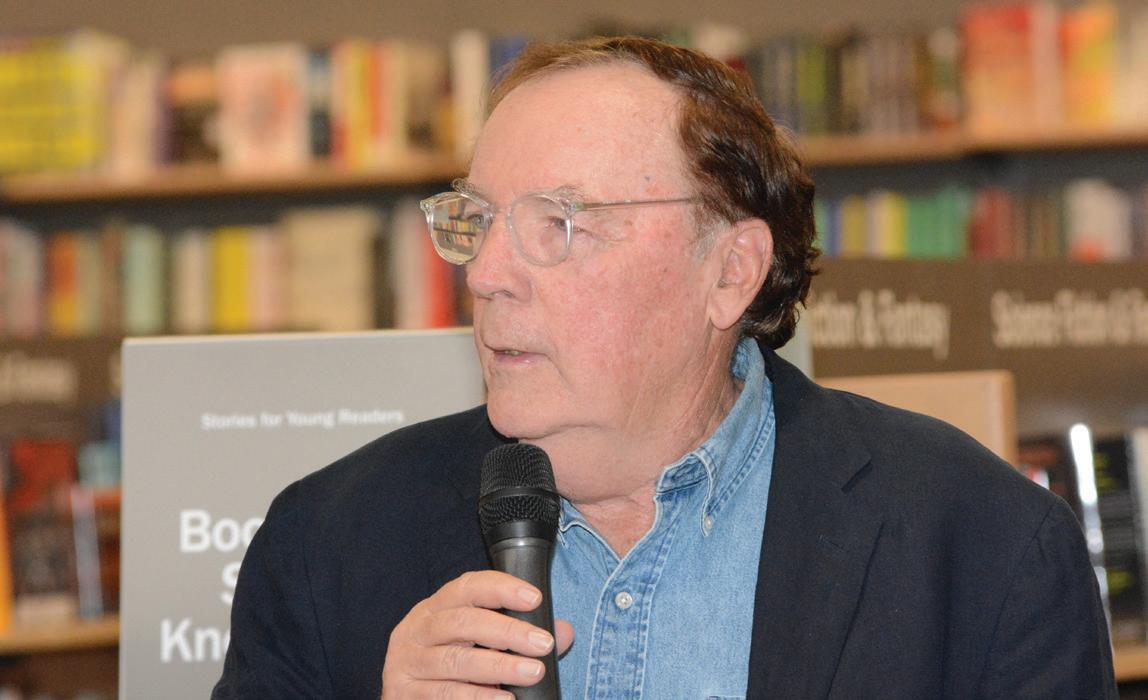
THE SCHOLARSHIP RECIPIENTS ARE:
Juniors
Lillian Alfanek, engineering (Yonkers, N.Y.)
Sage Clarke, liberal arts (Northport, N.Y.)
Ivanna Duran, liberal arts (Staten Island, N.Y.)
Karen Flores, business (Bronx, N.Y.)
Brian Oduor, engineering (Alameda, Calif.)
Elisa Ortiz, liberal arts (Mohegan Lake, N.Y.)
Sophia Rosellon, science (Kings Park, N.Y.)
Landen Scofield, education (Esperance, N.Y.)
Jorge Tapia, business (New York, N.Y.)
Alexandrea Velez, liberal arts (Milford, Conn.)
Seniors
Johely Aguilar, education (Bronx, N.Y.)
Daniel Angel, engineering (Bronx, N.Y.)
Andrew Chacko, science (Valley Cottage, N.Y.)
Liam Donahue, business (New Providence, N.J.)
Janita Dreher, liberal arts (Bronx, N.Y.)
Gemma Meade, education (Hackensack, N.J.)
Granit Oroshi, science (Tuckahoe, N.Y.)
Kevin Orozco, engineering (Mount Vernon, N.Y.)
Catriona O’Shea, education (New Hyde Park, N.Y.)
Ireland Walker, education (Wantage, N.J.)
TWENTY MANHATTAN COLLEGE STUDENTS from across the College’s programs have received a James Patterson ’69 Scholarship for the 2023-2024 academic year.
It is the 12th consecutive year that Patterson, the world’s best-selling author and philanthropist, has supported scholarships for 10 juniors and 10 seniors who have demonstrated academic excellence and involvement in activities tied to the College’s Lasallian mission. The scholarships are also awarded based on student need.
“James Patterson’s enduring philanthropy continues to have a profound impact on the students who receive these scholarships,” says Milo Riverso ’81, president of Manhattan College. “These students are among our most accomplished, having demonstrated exceptional academic achievement and unwavering commitment to their studies. The Patterson Scholarships provide them with a vital measure of financial security and support as they approach graduation, and hopefully inspire them to emulate Mr. Patterson’s extraordinary success.”
The scholarship program awards $5,000 to each of the 20 recipients. All seniors are eligible to apply to receive one of four additional $2,500 awards based on essay submissions that outline their plans after graduation.
“I am proud to support these outstanding students through my scholarships,” Patterson says. “Each of these recipients has demonstrated not only academic excellence but also a commitment to service. I am confident that they will continue to excel in their studies and make significant contributions to society.”
James Patterson is the most popular storyteller of our time. He is the creator of unforgettable characters and series, including Alex Cross, the Women’s Murder Club, Jane Effing Smith, and Maximum Ride, and of breathtaking true stories about the Kennedys, John Lennon, and Princess Diana, as well as our military heroes, police officers and ER nurses. He has co-authored No. 1 best-selling novels with Bill Clinton and Dolly Parton, told the story of his own life in the memoir James Patterson by James Patterson, and received an Edgar Award, 10 Emmy Awards, the Literarian Award from the National Book Foundation, and the National Humanities Medal.
He has established more than 400 Teacher and Writer Education Scholarships at 21 colleges and universities throughout the country. Patterson has also donated more than one million books to U.S. soldiers at home and overseas.
MA nHATTA n .EDU N 43

Planned Gifts Are a Personal Investment in Manhattan’s Ongoing Strength

MICHAEL KELLEY ’07 IS MAKING A STRONG PERSONAL INVESTMENT in his alma mater’s future. In addition to donating considerable time and talent as a member of the Board of Advisors for the Kakos School of Arts and Sciences, he is making a generous planned gift to Manhattan College.
“I’m deeply proud of my many ongoing connections to Manhattan,” says Kelley, who serves as vice president of Portfolio Management at Sequoia Financial Group. “Those associations continue to enhance my life and career. I decided to make a planned gift to help ensure academic excellence and access for future generations of Jaspers.”
Whatever their age or class year, a growing number of alumni and friends are choosing to make planned gifts to Manhattan. Essentially, a planned gift is an agreement to make a deferred total contribution. Jaspers have a variety of convenient, effective ways in which to use this vehicle to help keep the College strong.
Bequest
Many alumni and friends choose to name Manhattan as a beneficiary in their will. Gifts bequeathed to the College may include cash, securities or real estate and other personal property.
Life Insurance, Financial Account or Retirement Plan
An easy way to make a planned gift is to designate Manhattan as the recipient of a financial account. Donors also may include the College as a beneficiary of a retirement plan or life insurance policy — a simple way to contribute to the College’s lasting strength.
Charitable Gift Annuity (CGA)
This is an especially attractive way for alumni and friends to give. It provides a generous charitable tax deduction along with guaranteed income for life — starting immediately. A CGA requires no management fees, costing nothing to set up or sustain. For those with appreciated securities, it also is a great way to minimize capital gains taxes. Since the New York State Department of Financial Services highly regulates CGAs, you can be sure your investment is safe.
Deferred Charitable Gift Annuity
This giving vehicle is similar to the CGA. Donors may avail themselves of an immediate charitable deduction, generating a higher annuity rate by delaying the income payments until a time when you need them, such as retirement.
Trust
By establishing a trust, you also may provide yourself with income while giving to Manhattan College. Under a Charitable Remainder Trust (CRT), for example, you and/or your beneficiaries receive lifetime income. Upon passing, you automatically donate remaining assets to the College. A CRT may reduce your taxable income and lower or eliminate estate taxes.
A Personal Legacy of Giving
As Kelley demonstrates, friends and alumni are never too young to make a planned gift. Through any of the giving approaches outlined above, you may leave a personal legacy of your commitment to the College that transforms so many lives.
For more information on planned gifts, please contact the office of Planned Giving at (718) 862-7976, or email Elizabeth Plaushin at eplaushin01@manhattan.edu.
DEVELOPMENT 44 N spring 2024
The Fund for Manhattan: Keeping the College Strong for New Generations
THEIR FACES SAY IT ALL. Whether they are concentrating on classroom lessons, studying in the reading rooms of the O’Malley Library, or simply laughing with their fellow students, today’s young Jaspers continue to experience the abundant advantages of life and learning at our Riverdale campus.
These images convey the enduring value of the Manhattan College experience, a transformative education made stronger by the generous alumni, parents and friends who contribute to the Fund for Manhattan through the Annual Fund or the Anniversary Fund. They provide the necessary resources for various support services on which our students depend, such as internships and mentoring, campus life activities and financial assistance. The Fund for Manhattan helps bridge the gap between tuition revenue and general operating expenses that aid our students and campus community every day.
“As Jaspers, educated in the spirit of Saint John Baptist de La Salle, my fellow graduates and I deeply believe in supporting opportunities for new generations,” says Margaret (Meg) Walsh ’79, ’83 (MBA), ’92 (M.S.), who is in her fourth year as chair of the Fund for Manhattan.
For Walsh, contributing time and other resources to the fund is a way of expressing her gratitude for the education she received at the College. “Manhattan prepared us for our careers and made us part of a larger, caring community,” she notes. “Supporting the Fund for Manhattan sustains this experience for new generations.”

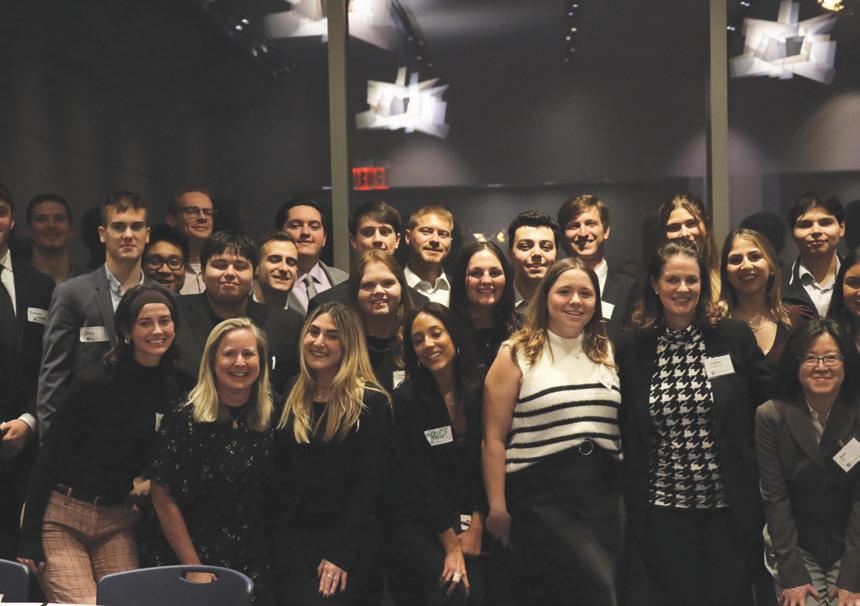

1. The Student Club and Activity Fair provides Jaspers with the opportunity to learn about the many clubs available at the College, including the Prelaw Society. There is always the opportunity to start a new club, as well.
2. Students engaged in the classroom is a hallmark of the Manhattan College experience. Smaller classes and dedicated teachers help our Jaspers get the most out of their classes, so they go on to achieve their career dreams.
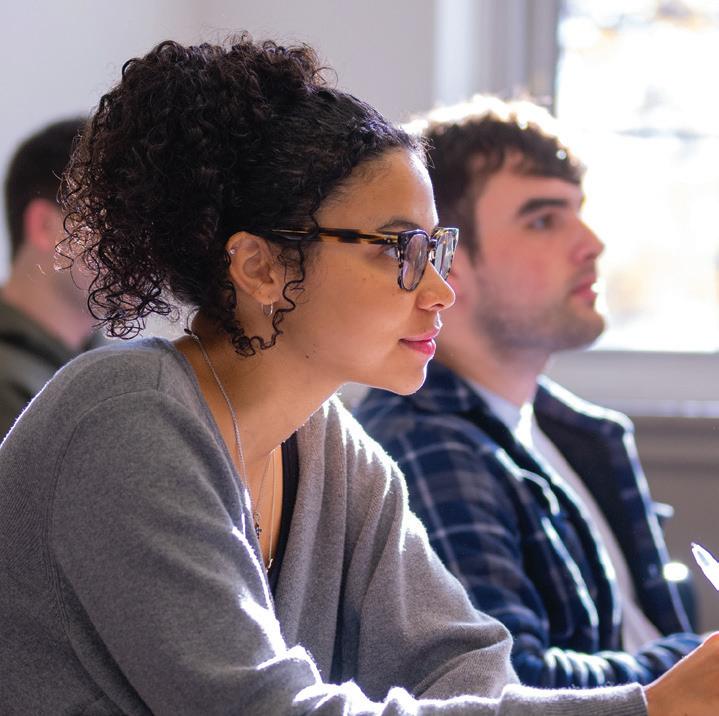
faculty and students who network and reconnect with fellow Jaspers.
4. Members of the Mini Baja Club design and build an off-road vehicle from scratch to compete in Baja SAE, an annual intercollegiate design competition run by the Society of Automotive Engineers.
MA nHATTA n .EDU N 45
3. Each semester, the O’Malley School of Business has a dinner to honor alumni who have made significant contributions to the business world. Hosted by the dean, the Alumni Association and student-led business clubs, this highly anticipated event draws alumni,
To learn more about helping to keep Manhattan strong by giving to the Fund for Manhattan, visit manhattan.edu/giving , call (718) 862-7701, or use the QR code.

Hall of Fame Inducts New Class
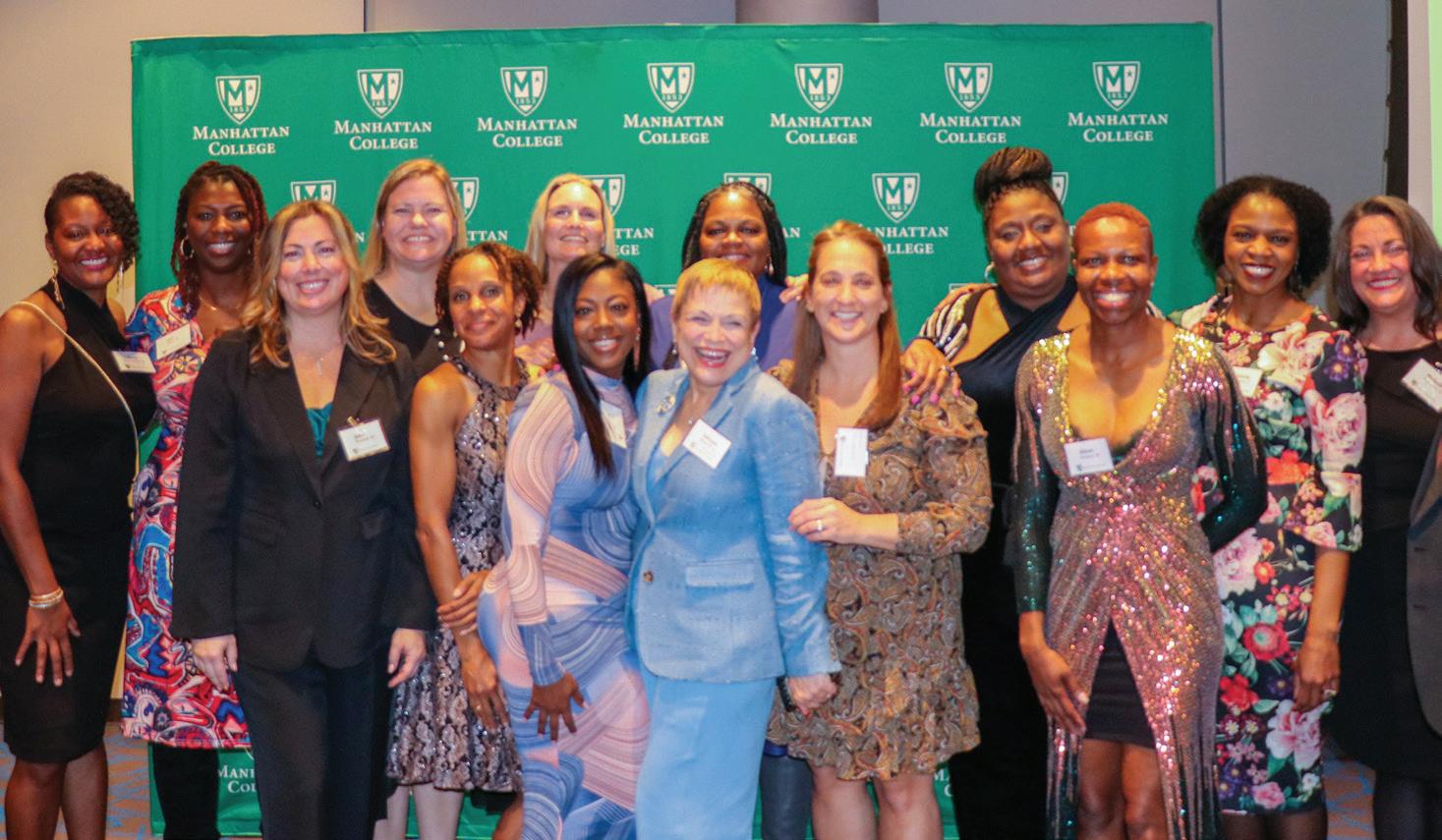
MANHATTAN COLLEGE HONORED THE NEWEST MEMBERS inducted into its Athletic Hall of Fame this past November and celebrated their indelible mark on Jasper history. The class of 2023 features athletes across four sports whose contributions to Manhattan span more than 40 years. This year’s class included Christian Haar ’99 and Michael Kenny ’71, men’s track and field; Mark Onorati ’11, Chad Salem ’11 and Thomas Waddell ’81 (posthumously), baseball; Thomas Romano ’11, golf; and the 19992000 women’s track and field team.
“We are pleased to honor this exceptional Hall of Fame class whose members each achieved outstanding accolades while representing Jasper Athletics,” says Irma Garcia, director of athletics. “We look forward to welcoming back and recognizing these elite student-athletes who elevated their respective programs during their time to deserve this prestigious recognition.”
Christian Haar ’99, a long jump and triple jumper for Manhattan College in the late ’90s, was a four-time NCAA All-American. The winner of numerous Mets long and triple jump crowns, Haar also took three IC4A triple jump championships. He won the MAAC Championship long and triple jump titles every year he competed (indoor: 1997, 1998 and 1999; outdoor: 1998 and 1999). Haar’s triple jump personal best of 16.18 meters puts him just behind Hall of Famers Kenneth McBryde ’87 and David Frazier ’94. As a professional athlete, Haar became a two-time Swedish triple jump champion and finished in the top three 20 times in the long and triple jump at the national championships. He now coaches the long and triple jump for the Tureborg Track & Field Club in Sweden.

Michael Kenny ’71, an All-American distance runner, was a member of the 1970 NCAA Championship distance medley team that placed first with a time of 9:49.2. Kenny ran his quarter-mile in 49.6 seconds. With several top-five finishes in 1970, he placed first in the two-mile relay to beat Navy and Penn State, two nationally ranked teams. He also won the 600-yard run with a time of 1:11.9. In 1971, Kenny anchored the mile relay team at the IC4A Championships and crossed the finish line in 48.4 seconds, the fastest leg of a new Jasper record. During his career, he also recorded several top-three finishes in the 440-yard run, 600-yard run, 1,000-yard run, one-mile relay and two-mile relay.
Mark Onorati ’11, a four-time All-MAAC honoree (two-time First Team, two-time Second Team) for baseball, still holds the Manhattan school records for hits (286), doubles (70), at-bats (812), and runs (235). Onorati, an outfielder, was named to the MAAC 40th anniversary team and helped Manhattan win three MAAC Regular Season Championships (2008, 2009 and 2011). During his junior year, he recorded 79 hits, becoming the first player in program history to record two 70-plus hit seasons. He went over the 200-career hit plateau, just the ninth player in Manhattan baseball history to do so. Onorati led the Jaspers with 19 doubles and 14 stolen bases and was second for runs scored, with 59. After taking the regular season title in 2011, the team went on to beat Siena 5-1 in the tournament championship game and advanced to the NCAA Tournament as the No. 4 seed in the Gainesville Region.
(From left to right) Members of the 1999-2000 women’s track and field team reunite as new inductees of the Athletic Hall of Fame. The team made a lasting impact, as many of their records still stand at the College today. Michael Kenny ’71 reminisces about his time as an All-American distance runner and proudly receives his recognition.
ALUMNI 46 N spring 2024
Thomas Romano ’11 is one of the top golfers in Manhattan program history. Romano became the first Jasper to be nationally ranked at 115th in Division I men’s golf after the completion of his senior season. He ranked fourth in Mid Majors for the East Coast during his sophomore season (2008-09) and was named to the MAAC 40th Anniversary Team. Romano also earned MAAC Player of the Month in September 2009, and was a three-time MAAC All-Academic Team member. He was a three-time team MVP, team captain in his senior year, and Athlete of the Year in 2009. He set school records in many categories, including for lowest career scoring average, lowest individual season scoring average, most rounds in the 60s, and most consecutive rounds under par. Undefeated in match play, Romano also had the most career wins and was the first freshman to win his first event. During his final year, Manhattan finished its campaign by winning four tournaments, two dual matches, and placing second in two invitationals. Romano also served as the basketball team manager for all four years.
Chad Salem ’11, an infielder, is a four-time All-MAAC selection from 2008-11 for baseball. A two-time American Baseball Coaches Association All-Northeast Region team selection (2010 and 2011), he was named to the MAAC 40th Anniversary Team. He helped the Jaspers win three MAAC Regular Season Championships (2008, 2009 and 2011) and was selected to the 2009 All-MAAC Tournament team. He was a captain of the 2011 team that recorded a 34-19 overall mark and a 20-2 conference record to clinch the regular season title. The team went on to beat Siena 5-1 in the tournament championship game to advance to the NCAA Tournament as the No. 4 seed in the Gainesville Region. Salem holds Jasper records for career home runs (42), career RBIs (214), and single season RBIs (68) in 2010. He ranks second in program history in hits (263), fourth in doubles (57), third in at-bats (752), and third in runs (201). After his college career, he signed a professional contract to play for the Evansville Otters in the Frontier League in 2011.
Thomas Waddell ’81 was a member of the baseball team in the late ’70s and early ’80s. The right-hander went on to sign with the Atlanta Braves as an amateur free agent in 1981. After three seasons in their farm system, Waddell was drafted by the Indians in the 1983 Rule 5 draft. He made his major league debut on April 15, 1984. For the season, Waddell went 7–4 with a 3.06 earned run average, 59 strikeouts and six saves in 58 appearances for the Indians, setting a club record for relief appearances by a rookie. Waddell pitched for the Cleveland Indians from 1984 to 1985, and again in 1987.
The 1999-2000 women’s track and field team swept the MAAC Championships. The Jaspers won the Indoor Championships with 213 points, 135 ahead of the runner-up. For the Outdoor Championships, Manhattan scored 253 points, 129 points ahead of second place. The team was highlighted by Olympian Aliann Pompey ’99, the College’s first-ever national champion after she won the 400-meter dash at the 2000 NCAA Division I Indoor Track and Field Championships. She also added multiple MAAC and Metropolitan titles to her collegiate résumé. A team captain, Pompey was ranked 12th in the world in the indoor 400-meter dash as a senior and was inducted into the Hall of Fame in 2009. Many indoor records from the 1999-2000 team are still standing: Tiffanie Poole ’00, 200 meters, 24.22; Pompey, 400 meters, 52.21; Pompey, 500 meters, 1:09.23; LaCole Fields ’00, shot put, 15.01 meters (49’3); Poole-Allen-Edwards-Pompey, 4x400-meter relay, 3:41.01. Outdoor records from the 1999-2000 team that still stand are: Pompey, 400 meters, 52.53; and Lisa Edwards ’00, 400-meter hurdles, 1:01.25.

MA nHATTA n .EDU N 47
Mark Onorati ’11 (left) and Chad Salem ’11 (middle) receive their awards alongside Irma Garcia (right), Manhattan College ’ s director of athletics. The two Athletic Hall of Fame members played together on the baseball team and were honored to celebrate this achievement as teammates again

Jasper Community Takes Center Stage at Yankee Stadium


College’s 100th anniversary of its location in the
to enjoy the game alongside fellow students, family, friends and
gathered on field together for a pre-game ceremonial event.
YANKEE STADIUM ROARED WITH THE ENERGY of more than 1,000 students, alumni, family and friends on Sept. 22, marking the celebration of the 100th anniversary of the College’s location in the Riverdale section of the Bronx.
The New York Yankees vs. the Arizona Diamondbacks game was the first event to kick off the College’s annual Family Weekend that ran through Sept. 22-24, during which family members immersed themselves in the Jasper experience by engaging in exciting events throughout the weekend. This year’s events included a family carnival featuring music, mini golf and games, a hypnotist show in Kelly Commons, a traveling animal show that featured wildlife from all corners of the globe, and a city excursion to the High Line.
As the Jaspers entered the stadium, they were welcomed with an exclusive Yankees hat featuring Manhattan College branding. Prior to the start of the game, there was an announcement and a pregame video that honored the presence of the Jaspers. President Milo Riverso ’81 also participated in a ceremonial event on the field prior to the first pitch. He was joined by staff from Student Engagement and the Athletic departments.
Throughout the game, the Jasper community took center stage with multiple appearances on the jumbotron — showcasing their pride for both Manhattan College and the New York Yankees. At one point in the game, the Yankees also made a special announcement highlighting how Brother Jasper of Mary, FSC, invented the 7th-inning stretch, a tradition adopted by the Major Leagues.
Founded in 1853, Manhattan College initially stood at 131st and Broadway. However, in 1923, the College relocated to its present campus in Riverdale. Since then, Manhattan has played a significant role in contributing to the vibrant community of the Bronx.
The game provided a spirited opportunity for students, alumni and families to gather and celebrate the 100th anniversary of the College’s Riverdale campus. The Yankees secured a 7-1 victory over the Diamondbacks, including three homers by captain Aaron Judge; thus, concluding Family Weekend on a high note.
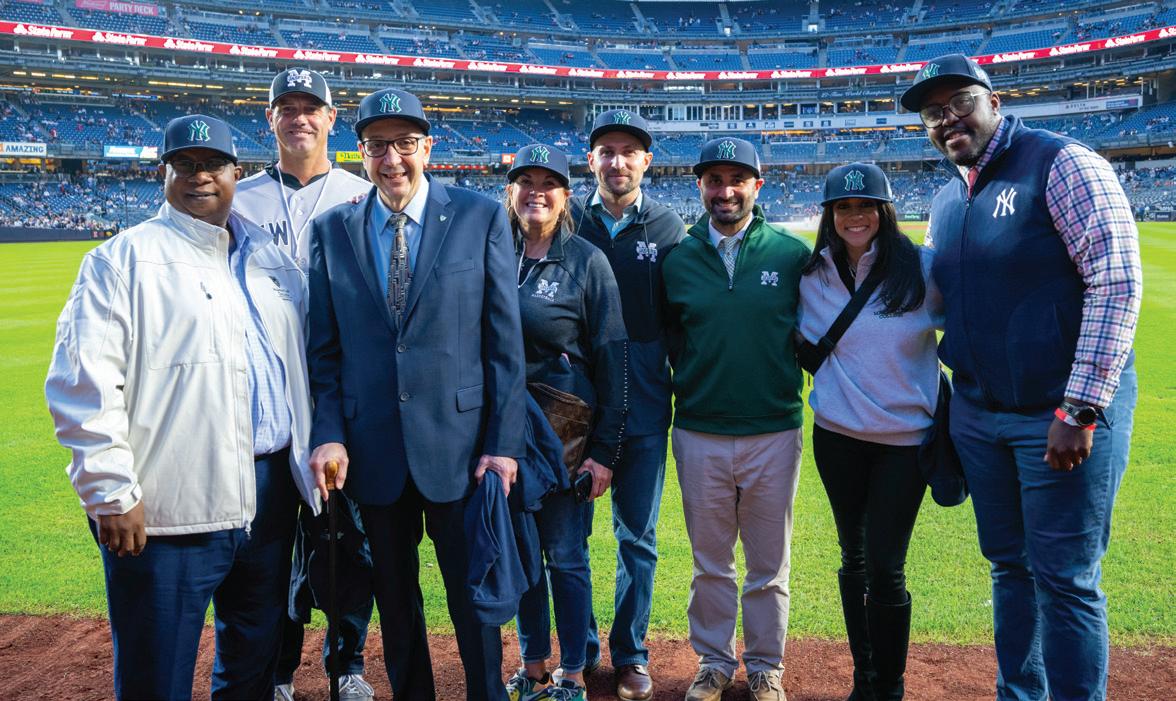
ALUMNI 48 N spring 2024
Isaiah Rosario ’25 (left) and Sean Hunnewell ’25 (right) radiate the Jasper spirit as they celebrate the
Riverdale section of the Bronx. The iconic Yankee Stadium served as the perfect venue for this milestone, where Jaspers were able
alumni. (Bottom) President Milo Riverso ’81 and staff from the Student Engagement and Athletic departments
Whatever Happened to … Homecoming?
IT WAS A CRISP MID-OCTOBER DAY in 1965 when a 40-piece marching band, uniformed officials and hundreds of spectators came out to Gaelic Park to cheer on the newly organized Manhattan football club, who handily defeated their rivals from New York University (20-14). Enthusiasm from the more than 300 alumni provided the soundtrack to the Jaspers’ triumph. The football game was just one event in a day jam-packed with well-organized homecoming activities. For decades, Manhattan alumni returned to their alma mater each fall to reconnect with old friends, visit faculty members, observe the changing campus scene, and enjoy the traditional homecoming celebrations. But this autumn ritual has slowly faded away. Whatever happened to homecoming?
With the oldest Catholic alumni association in the country, Manhattan College has been inviting its alumni to “come home” since the late 19th century. Originally, opportunities for the alumni to return to campus were offered through a course of lectures each year and an annual Memorial Day Mass. Alumni were encouraged to address undergraduates on their subject of expertise or interest. In 1905, for example, Daniel Cohalan, class of 1885, gave a lecture on The Value of Honesty as a Means to Success, a topic still relevant today. The annual Memorial Day Mass ceremonies allowed Manhattan men to return to campus to pray together in the chapel for the souls of those lost. Of course, the main alumni event, the banquet, had been held since the inception of the Alumni Society in 1869, but those elegant affairs took place in the glamorous landmark hotels around town rather than on campus.
The first time the term “homecoming” was introduced was in 1920, when the College began its campaign to raise the funds to build the new campus in the Bronx. At the time, Manhattan had nearly 1,500 living alumni and the association sought every opportunity to engage with them all. Homecoming centered around one event, the beefsteak dinner, a men-only, philistine affair enjoyed with great quantities of beer and meat. At these all-you-can-eat dinners, where nostalgia was the focus of entertainment, Jaspers dressed as butchers in hats and aprons (napkins and utensils were optional), consumed slabs of beef saturated with gravy and unlimited ale seated along grease-darkened oak tables in the “old” Manhattan College refectory hall. When the College relocated to the Bronx, the Alumni gymnasium provided the backdrop for the feasting, and the overall feel was merry and masculine.
After the Second World War, the College sought to widen the influence of the Alumni Society and strengthen the occasions that bound its members to alma mater. A more elaborate and varied series of events were scheduled for a full homecoming day that included Masses, lectures, concerts, tours of campus, cocktail parties and dinner dances. The guest list was also expanded to include the wives, “best girls” and children of Manhattan men. Throughout the 1940s and 1950s, activities were largely delineated according to gender

and age. Children were treated to pony rides, movies, magicians and barbecues under the supervision of female nursing students from the College of Mount Saint Vincent. Ladies were regaled with tea, luncheons, bridge and canasta parties and glamorous fashion shows. Men were invited to watch military demonstrations on the Quadrangle, which featured the Manhattan unit of the AFROTC staging sabre or Pershing rifle drills, cross country meets, or basketball skill exhibitions, and cigar and beer songfests. There were also plenty of comingling dinners and cocktail parties. Some homecomings were scheduled to coincide with special events. In October 1957, Jasper Hall was dedicated as part of the festivities, in 1962 a College Bowl contest was staged after a four-man Manhattan College team won three consecutive weeks on the popular CBS television quiz show, and, in 1979, the Athletic Hall of Fame celebrated its first ceremony as the main event of homecoming day.
A sporting event or exhibition became an essential part of the homecoming schedule, especially because athletics has always played an important and vibrant role in Manhattan collegiate life. After football was reintroduced to the College in 1965, for several years, homecoming orbited around the big game in Gaelic Park, which included the pre-game tailgate party. In the 1980s, when football started to decline, basketball, cross country, track and the Athletic Hall of Fame ceremony were the main activities of homecoming. By 1989, however, the concept of homecoming was dropped all together.
Today, alumni have many opportunities to “come home” to alma mater. Their zeal continues to provide the harmonious background to athletic games and meets. The Athletic Hall of Fame induction ceremony continues to be held each fall. And in the late spring, the campus buzzes with the activity of Reunion Weekend, a series of events held on campus to celebrate specific anniversary classes, which most resembles the homecoming of yesteryear.
FROM THE COLLEGE’S ARCHIVES MA nHATTA n .EDU N 49

ALUMNOTES
1953
David Hickie writes that he is turning 90 years old and doing well. Hickie is living in a retirement community in Scottsdale, Arizona, and enjoying the company of his four sons, 12 grandchildren and two greatgrandchildren. He thanks Manhattan College for his education and a great start to his life.
1954
Donald Costello will turn 90 years old in March and is still teaching as an associate professor of computer science at the University of Nebraska. He has helped start three computer science departments and three information technology facilities at the University of Nebraska, University of Wisconsin and Colorado State University. In his business career, he has managed information technology facilities, founded and sold two firms, and consulted with more than 100 firms, including the World Bank and the United Nations on information technology matters and management issues, especially in the area of cybersecurity.
1958
Robert Donnaruma retired from the New York State Thruway Authority as deputy executive director in 1998.
1959
Joseph Corless received an honorary Doctor of Science degree from Dominican University New York in recognition of more than 30 years of involvement in the community. As a past chair of the Dominican University New York Board of Trustees, Corless volunteered as a project engineer to oversee the multiple facilities that the university has constructed during his time on the board. He is a professional engineer with Corless & Associates and has 50 years of environmental and civil engineering experience, including construction management, general civil and municipal engineering.
1960
Geza Bottlik retired from the engineering faculty at the University of Southern California after 32 years of teaching.
Robert Gorman has been an athlete, coach, administrator and author. After playing
college baseball, he began a teaching and coaching career in East Meadow, New York. Gorman was the chairman of Nassau wrestling, a member of the Nassau County Athletic Appeals Committee, the county softball chairman, the North Shore secretary/treasurer, and secretary of the Nassau Football Coaches Association. Additionally, his love of baseball motivated him to write three books. Recently, he was recognized for his hard work and dedication by the Nassau County Sports Hall of Fame. He was thrilled to be a part of an induction ceremony that took place in September 2023.
1963
Albert Rosa published the 10th edition of The Analysis and Design of Linear Circuits (John Wiley & Sons Inc., 2023) alongside co-authors Roland Thomas and Gregory Toussaint. This engineering textbook guides students to explore, create and put their learning into practice. The Analysis and Design of Linear Circuits presents linear circuit theory, integrates active and passive linear circuits, allows students to understand and design a wide range of circuits, solve analytical problems, and devise solutions to problems. Rosa has 44 years of experience in practicing engineering, education and teaching, with nine years spent at the U.S. Air Force Academy in the Electrical Engineering department. Additionally, he has been a distinguished visiting professor for eight years and was the chair of the Engineering department for 17 years at the University of Denver.
Richard Sartore writes that he and his brother Edward Sartore ’62 recently traveled to Italy to visit family. Sartore adds that they enjoyed their time there and were proud to wear their Jasper hats while abroad.
1965
Franklin Ciofalo writes that he is enjoying retirement with his grandchildren, Gianna and Ava.
Patrick Keogh lives in a small Texas town called Llano, the midway point between his two children, both of whom are college professors. Recently he published a new
book, Live the FINER Life (Stonebrook Publishing, 2023), a blueprint for how investors and parents can build their family’s asset management business.
1968
Sister Regina Bechtle, S.C., received an honorary Doctor of Humane Letters from St. John’s University in May 2023 for her scholarly and pastoral studies on the life and writings of St. Elizabeth Ann Seton and her contributions to spiritual formation in the Vincentian tradition.
Stephen Hall retired from psychology practice after nearly 20 years at Cordell Associates, a medical group practice providing mental healthcare for children, families and adults in Dayton, Ohio. Prior to working there, he spent 20 years as an Air Force officer.
Richard Kenney celebrates his 28th anniversary as vice president of the executive council at Long Realty Company in Tucson, Arizona.
1969
John Loase released his 13th book, Sigfluence (Significant, Long Term Positive Influence: The Key to Purpose) (Austin Macauley Publishers, 2023). Loase thanks Manhattan for its role in preparing him for his career. He has taught math from the sixth-grade level to advanced statistics at New York University. George Lyons writes that he is the town councilman of Goshen, New York. He is also the president of the Goshen Volunteer Ambulance Corps and sits on the board of the Goshen Chamber of Commerce.
Michael Zino recently wrote Existence With and Without Time: Discovering the True Nature of Humankind (self-published, 2022), which explores topics such as religion, spirituality, values, myths and other beliefs through time. This book also navigates the search for the meaning of life in a vast and unpredictable world. Existence With and Without Time explores how to bring the wisdom of intelligence that is not our own into knowable reality through the use of myth, mindfulness and devotion to authenticity. Zino is a retired economist who
ALUMNI
50 N spring 2024
served as deputy director at the New York State Financial Control Board for almost two decades.
1970
Rocco Marotta and Eugene Ciccone write that they are still “in touch and sharing ideas.” They both work as physicians.
1971
William (Bill) Owens was elected chairman of the board of Arrow Financial Corp. after being a director of the company since 2015. Owens has also been a director of Glens Falls National Bank and Saratoga National Bank. He is a former U.S. congressman who represented New York’s 21st District from 2009 to 2014. Prior to serving in Congress, he served on the board of NBT Bank for 15 years and was chair of the compensation committee.
1972
Christopher Uchrin retired after 43 years of teaching at Rutgers University. Uchrin was a professor in the School of Environmental and Biological Sciences, and his research involved the mathematical modeling of contaminants in aquatic ecosystems.
1973
Paul Lachiewicz retired from clinical practice and surgery after a 40-year career in academic orthopedic surgery at The University of North Carolina at Chapel Hill and Duke University. He writes that he and his wife continue to ski in Colorado and have most recently traveled to Machu Picchu, Peru. They have two grandchildren.
1976
Michael Fidanzato thanks Manhattan College for helping him to prepare for medical school and writes that his son Jeffrey Deluca ’19 also finds himself wellprepared after graduating. Fidanzato is now retired after 41 years as a physician.
1977
Lillian Borrone was selected as an honoree by the Waterfront Alliance for her work and leadership as an assistant executive director for the Port Authority of New York and New Jersey. Waterfront Alliance honors those who have contributed to the vibrancy,
JASPER BOOKSHELF
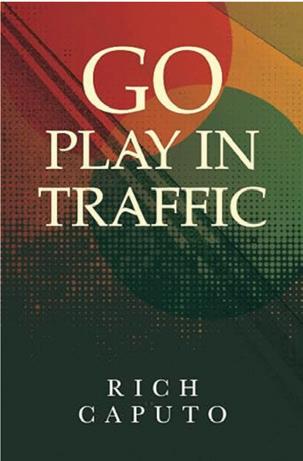


Richard Caputo ’61 self-published a two-volume memoir called Go Play in Traffic and Go Play in Traffic Again (2023). Caputo, who was born in the Bronx in the late 1930s, describes growing up and enjoying endless hours of roaming the streets of New York. The memoir also addresses his marriage, family and career as a mechanical engineer, along with his varied accomplishments. These include designing radioisotope thermoelectric generators for moon and solar system applications, teaching at San Diego State University, and organizing the first Doo Dah parade in Pasadena, California (a celebration of all things humorous, where people can dress up in just about any costume). After hearing stories about his life, Caputo’s family and friends encouraged him to write them down.
Ronald Herzman ’65 released Dante, Eschatology, and the Christian Tradition: Essays in Honor of Ronald B. Herzman (Medieval Institute Publications, 2023). This volume of essays by Herzman’s colleagues, students and friends celebrates his career and reflects the wide range of his scholarly influence, from biblical and early Christian topics to Dante, Langland and Shakespeare. He writes that two other Manhattan graduates, William Kennedy ’62 and Thomas Hefferman ’68, have essays in this volume, as well as Rick Emmerson, who was dean of the College's School of Liberal Arts from 2010-2014. Herzman has been a distinguished professor of English at SUNY Geneseo for more than 50 years and a major force in the promotion of medieval studies within academe and public humanities.
Robert Murphy ’70 published his fifth book, Gowanus: A Novel of Brooklyn Past and Further Past (Long Meadow Books, 2022). This engaging story mixes waterfront crime fiction with a background of real-world historical characters. Murphy explores the lives of dock workers and ship captains and their families in Brooklyn, New York, during World War I. He has been a professional writer since his 20s, working as a reporter, editor and columnist for local newspapers, a feature writer for magazines, and a writer and media relations supervisor for a major corporation. Murphy has also published blogs for the Huffington Post on topics including sports, religion and language. After years of experimentation and progress with writing, he has concentrated on writing short fiction mostly set in New York.
sustainability, economy, education and awareness of New York and New Jersey. Borrone set forth a blueprint for the future of the New York Harbor. Just this past year, the Port of New York and New Jersey handled more container volume than any other U.S. port. The Waterfront Alliance honored her extraordinary career encompassing decades of public service in senior policy and executive roles at the U.S. Department of Transportation, Urban Mass Transportation Administration; advisory roles in the private sector to major companies; and service leadership on national nonprofit boards such as the Eno Center for Transportation. William Bryk writes that he was elected to the Contoocook Valley, New Hampshire
school board last year.
Marco Damiani has spent his entire career in disability rights, fighting for full inclusion of people with intellectual and developmental disabilities in their communities. Damiani was featured in the Manhattan Power List presented by Schneps Media, which recognizes the most influential individuals in the borough. Currently, he is the CEO of AHRC New York City, a family-governed organization that provides a range of inhome support for those with developmental disabilities. Damiani leads a staff of about 5,000, supporting 15,000 individuals and their families.
MA nHATTA n .EDU N 51

1979
Frank Conroy was inducted into Iona Preparatory School’s hall of fame. He has been a social studies teacher there since 1994. Conroy was also inducted into the Catholic High School Athletic Association Hall of Fame for coaching at Salesian High School for five years and coaching Iona Preparatory’s varsity B basketball team for more than 25 years.
Kevin Reilly writes that he retired after a 40-year career in education and athletics. Currently, he is substitute teaching, volunteering, swimming and enjoying family time.
Joseph Seebode was selected as an honoree by the Waterfront Alliance. Seebode was recognized for his leadership, public service and passion to find and implement solutions such as natural resource protection and enhancement, port efficiencies and economic development for the region. He is the deputy district engineer and chief of programs and project management for the U.S. Army Corps of Engineers New York District. Seebode is an engineer and scientist, and the highest-ranking civilian leader in the U.S. Army Corps of Engineers New York District. Waterfront Alliance honors his deep experience in emergency response and his leadership during crises. His experience includes directing the Army Corps Regulatory Program, serving as program manager for the Port of New York and New Jersey, and developing an environmental restoration strategy for the New York-New Jersey Harbor Estuary. Seebode led response teams in the immediate aftermath of 9/11, after Hurricane Sandy, and during the initial phase of COVID-19, ensuring quick construction of emergency facilities.
Arthur Starr retired from CBS News after working 44 years as an audio supervisor. Previously, Starr was a robotic camera and video operator at WCBS-TV. His time at CBS News allowed him the opportunity to broadcast live from five political conventions and two Super Bowls. Additionally, Starr was in charge of all communications for several presidential debates, election night and inauguration broadcasts, as well as a live CBS This Morning from the White House. His final project involved the design and construction of a new audio room and intercom system for CBS News.
1980
Russell Schriefer is a leading political and corporate strategist, media consultant and founding partner of Strategic Partners & Media. Schriefer offers strategic counsel, coaching and crisis messaging to elected leaders and global CEOs. He was recently selected as a juror for the prestigious Peabody Awards, which honors storytelling that powerfully reflects pressing social issues. He writes that he is excited to contribute to recognizing excellence in media and storytelling alongside his colleagues. Christopher Sweeney and Yvonne Sweeney are looking forward to the birth of their daughter, who will join her brother, Christopher IV.
1981
Pasquale Bartolini thanks Manhattan College for a world-class education, which helped him celebrate 42 years of working at the Nine Mile Point Nuclear Station in Oswego, New York. Robert Rogers has been an associate information officer in the financial systems area at American International Group for the past 17 years. He and his wife, Mary Pat, have three children, Kate, Kevin and Kerry Anne, and two grandchildren. Recently, he spent a two-week vacation visiting six national parks in the U.S. and Canada, including Jasper National Park in Alberta, Canada.
1983
John Blaho became an elected fellow of the American Association for the Advancement of Science in 2022. Blaho is recognized with lifetime honors in the medical science section for substantial advances in the field of virology and the development of innovative training programs for commercializing basic science research discoveries.
1985
Steven Willard was named the 2024 executive vice president of the New York State Association of Professional Land Surveyors. Willard is a long-standing and active member of the Westchester-Putnam Association of Professional Land Surveyors Inc., of which he is a past president.
1986
Louis Colangelo is a mission area executive for special operations at Johns Hopkins Applied Physics Laboratory (APL). Colangelo is responsible for strategic planning, execution and performance of programs addressing the challenges of special
operations and the national intelligence community. Throughout his career, he has focused on the critical challenges of electronic warfare across the forces, the Department of Defense, and other government agencies. He is a recipient of APL’s Alvin R. Eaton Award, the U.S. Marine Corps Semper Fidelis Team Award, and the National Defense Industrial Association RADM Robert H. Gormley Combat Survivability Award for Leadership.
Mary McCue writes that she became a grandmother in May to Michael Jimi McPartland and looks forward to retirement.
1987
Christopher Lavoie is CEO of C.M. Lavoie and Associates Inc., a multidisciplined licensed professional corporation engaged in the practice of civil engineering throughout the United States. He was selected as the lead engineer for the design and construction of the Adoration Chapel at Our Lady of Mercy in the Diocese of Joliet in Aurora, Illinois. The firm provided complete architectural design, engineering and construction management services for the project.
1989
Catherine (Hissiger) Brainard presented a paper at the Decision Sciences Institute’s Annual Conference in Atlanta, Georgia, titled, “Given the high rate of special education teacher attrition, what factors may improve teacher retention?” Brainard writes that she is also approaching retirement following a career as a public high school special education teacher. She is completing a master’s degree in public and social policy from Empire State University as a segue to her next career advocating for formerly incarcerated individuals.
1996
Dahlia Henry-Tett writes that she is honored and proud to be recognized by Women We Admire as one of the top 50 women leaders in education in 2023. Henry-Tett is Northern Virginia Community College’s chief wellness officer, where she is responsible for the vision and direction of a comprehensive health and wellness experience for all employees. She forges relationships and works collaboratively with partners to design, redesign, market and promote wellness initiatives for the institution. With more than two decades of experience in the health and well-being industry,
ALUMNI 52 N spring 2024
Henry-Tett is an innovative college and campus community builder whose support and mentorship empower colleagues and students to navigate the complex demands of higher education.
2007
Daniel Russo, who has been the deputy schools superintendent for the Bronx since 2020, has joined Greenwich, Connecticut, public schools as the principal of New Lebanon School. Before becoming a deputy superintendent, Russo was the principal of P.S. 294: The Walton Avenue School in the Bronx for seven years. For his work there, he received the Community Education Council District 9 Action Committee Visionary School Leader Award twice. Russo looks forward to getting to know the students, staff and parents of the New Lebanon community.
2010
Eileen Leboff and Kevin Leboff write that they moved to Olney, Maryland, with their three daughters, Joanne, Dorothy and Frances.
2017
Samantha Bowers, also known by her stage name, Sammy Rae, participated in the second annual Sound on Sound Music Festival. The festival takes place in Bridgeport, Connecticut, and features world-class music and local food and drinks. Bower’s band, Sammy Rae and The Friends, performed alongside artists such John Mayer and the Red Hot Chili Peppers at the festival. Their high-energy shows have sold out across the U.S. and Europe.
2019
Isabel Velasquez Munoz was promoted to the position of vice president of insurance operations at Lenox Advisors in 2020. In this role, Velasquez is able to expand her skills and expertise in data analytics, strategic operations and innovation within the insurance industry. In addition, she oversees the diversity, equity, inclusion and belonging initiatives and leads the employee resource group. She writes that these endeavors have allowed her to drive positive change and foster a more inclusive and equitable work environment for more than 3,000 employees nationally. One of her most notable achievements is co-founding her own business, Misfits Unplugged, through which she can empower individuals in
their careers through podcasting, keynote speaking engagements and educational webinars. Velasquez notes that her Master of Science in organizational leadership degree played a pivotal role in providing her with the confidence and skills necessary to excel in her corporate career and venture into entrepreneurship. She also writes that she is grateful for the knowledge and insights that she gained at Manhattan College. Rena Wakama became the first female basketball coach to win the women’s AfroBasket Championship since its inception in 1966. As head coach of the Nigerian national women’s basketball team, D’Tigress, Wakama led her team to beat Senegal 84-74 in Rwanda’s capital, Kigali. She was previously the director of basketball operations at Manhattan College, which helped prepare her for the challenges that awaited her as head coach of D’Tigress. Wakama was in charge of managing budgets and coordinating travel and marketing for the Manhattan women’s basketball program. Her most significant role in this position was tracking the progress of prospective and current student athletes, which later proved instrumental in her ability to scout and recruit players for D’Tigress.
2021
Deirdre Heavey was selected by Fox News as one of seven reporters who will cover campaign events from the early primary states through the 2024 Republican and Democratic National Conventions in the summer. The reporters will be overseen by the Fox News political team, who will play a key role in the political news gathering operation. Heavey was hired at Fox News as a production assistant on the New York media desk, and works on daytime programming for Fox News Channel and field production with the New York bureau.
2022
Jassiel Toribio has been named a 2023 Excellence Award winner at Success Academy in New York City. These awardees go above and beyond in bringing culture and values to life and demonstrating a commitment to building a world where educational equity is a reality for children and families. She is currently an associate teacher at Success Academy Charter School – Harlem 2 Elementary, New York.
MARRIAGES
2015
Christine Heller and Dan Cronin, 4/29/23
2016
Paige Hughes and Josh Binfield, 10/7/23
Jo-Ann Mullooly and James Foy, 8/18/23
Paul Senica and Gerianne Martin ’18, 9/30/23
2022
Elyse Holmes DaSilva and Ronaldo DaSilva ’23, 8/19/23
BIRTHS
2010
Gabrielle Puglia-Pesce, son, Giordano Jude Pesce, 12/28/23
ADVANCED DEGREES
2019
Jenna Zawislak graduated from the University of Maine School of Law in 2022 with honors and distinction for pro bono service during her time at Maine Law. In 2023, Zawislak was admitted to practice law in the state of Maine, where she joined the Maine Indigent Defense Center as a defense attorney fighting for the rights of the accused and incarcerated.
MA nHATTA n .EDU N 53

Mr. Lawler Goes to Washington

FROM A YOUNG AGE, U.S. REP. MICHAEL LAWLER ’09 (R-NY) KNEW THAT HE’D LIKE TO RUN FOR OFFICE AT SOME POINT. He just wasn’t sure how, when or what office. He saw an opportunity to run for State Assembly in New York’s 97th District (his home district) in 2020, so he took it — and won.
“My general view was I had nothing to lose, and so you take the risk and you see what happens,” he explains. “You work hard, and you make the case to the public. But I think in terms of knowing that I wanted to run for public office, that’s something that I always thought I would do, but you never know how it presents itself, and you just have to be willing to go with the flow.”
Lawler acted on another opportunity in 2022, this time for a seat in New York’s 17th Congressional District, which includes Rockland and Putnam counties and portions of Westchester and Dutchess. In a major upset, he defeated the Democratic incumbent in a district that has 70,000 more registered Democrats than Republicans and only two
years after winning his first elected position in the Assembly. Lawler began his congressional term in January 2023, and has been busy working on the issues that matter most to his constituents ever since.
“It’s certainly been a real wonderful opportunity to serve and to represent the community in which I grew up, Rockland County, in Congress,” he says.
Lawler serves on the House Financial Services Committee and the Foreign Affairs Committee, as well as on nearly 50 congressional caucuses, including as co-chair of the AntiCongestion Tax Caucus.
His priority, though, is on the people in the district he serves, and finding solutions to many of the challenges they face.
“My objective is to represent them in Washington and be their voice, and make sure that we’re addressing the issues that matter to the district from the cost of living and affordability, which means lifting the cap on SALT [state and local tax deduction] and reducing grocery prices, energy prices, the cost of homeownership or rent.”
Lawler has been a driving force in passing a number of bills through the House, including the Special Envoy for the Abraham Accords Act, which will be an ambassador-rank position focused on Middle East peace and normalizing relations between Israel and four members of the Arab League.
“It’s something that when you can have a role in these different issues, whether it’s issues that impact your local community or your state, or whether it’s something broader that impacts our country or the international community, being able to put your ideas to paper and push to get it passed
into law is really a great experience,” he says.
Prior to his role in the State Assembly, he served as the deputy town supervisor in Orangetown and was a senior adviser to the Westchester County Executive. He also was executive director of the State Republican Party and previously founded his own government affairs and public relations firm.
In addition to a lengthy history of public service, Lawler is part of a long line of Jaspers to attend Manhattan College, going back to the 1920s, including his grandfather, John Lawler ’55, trustee emeritus. Lawler graduated with a double major in accounting and finance and was valedictorian of the class of 2009. He notes that his degree and the faculty have helped him along his career path.
“It has helped me tremendously in my career, having a greater understanding of our financial markets and budgeting and being able to utilize that background in the work that I do,” he explains. “I also worked as an intern for [Arizona Senator] John McCain while I was in college, and my proximity to New York City and New Jersey really allowed me to work in that capacity.” He connected with the McCain camp through one of his professors, Michael Sutera, a former adjunct.
When Lawler returns to campus to speak to students or participate in alumni events, he points out how their degree choice doesn’t necessarily limit their career options.
“Just because you major in something doesn’t mean that you have to be pigeonholed into that as a career,” he explains. “You can utilize that for anything you want to do, and I think that’s very true with what I did. And you should focus on what your interests are, and what you’re passionate about.”
As for what he’s focused on? His constituents, and running for reelection to Congress in November. But if another opportunity should arise, he is definitely open.
“I think in life, you have to be willing to take risks and to accept the opportunities as they come, but my objective right now is to continue serving in Congress and do the work that we were elected to do,” he says.
ALUMNI 54 N spring 2024
U.S. Rep. Michael Lawler ’09 joins third-, fourth- and fifth-graders at Montebello Elementary School’s career day in Suffern, New York, in November.
Atmospheric Expert Elected into the National Academy of Engineering
SONIA KREIDENWEIS ’83, UNIVERSITY DISTINGUISHED PROFESSOR IN THE DEPARTMENT OF ATMOSPHERIC SCIENCE AT COLORADO STATE UNIVERSITY
, is the newest Jasper and second alumna to be elected into the prestigious National Academy of Engineering (NAE), bringing the College’s total to 19.
Election into the National Academy of Engineering is among the highest professional distinctions accorded to an engineer. Kreidenweis was recognized by the academy “for elucidating the impact of aerosols on climate, linking chemical composition and cloud formation capacity.”
Kreidenweis, who feels humbled, attributes this honor to all of the people with whom she has taught and worked throughout the years.
“I am most thrilled for all of the students, researchers and collaborators who have worked on our research because this is really a recognition of the excellence of their efforts,” she says. “I am so proud that their cumulative accomplishments are being recognized this way.”
She is also happy to be recognized for interdisciplinary research because that is central to what she does and how she uses her degrees.
“I’m looking at issues around climate and applying these concepts from chemical engineering that include aerodynamics and aerosol physics that would relate to some of the things that an engineer would learn,” she explains. “So I’m very excited that the NAE has a section that is designed to address people working at the interface of disciplines on new problems.”
Kreidenweis started her career as an assistant professor of chemical engineering at San Jose State University, California, in 1988, before joining Colorado State University as an assistant professor of atmospheric science. She rose through the ranks, achieving the lifetime appointment of University Distinguished Professor. She also did stints as interim vice provost for graduate affairs
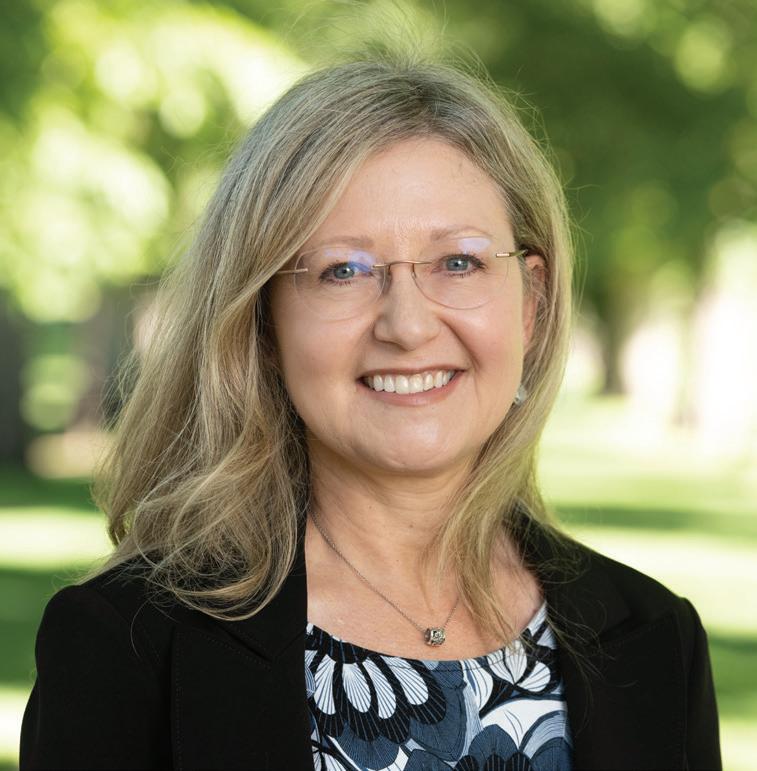
and dean of the Graduate School at Colorado State University, and research associate dean in the College of Engineering.
Kreidenweis, who received her bachelor’s in chemical engineering from the College in 1983 and went on to earn her master’s and Ph.D. in chemical engineering from California Institute of Technology, notes that her major was a good foundation for her career in atmospheric science.
“I think the choice of my major was a really great one because it included so much fundamental science and math that I really enjoy, which has really been so applicable to working in an interdisciplinary area,” she explains. “I worked with Dr. Joseph Reynolds and Dr. Louis Theodore [both chemical engineering], who became interested early on in air pollution and air quality, and that really sparked my interest.” She is also grateful for the academic scholarship that supported her through her studies at the College.
Kreidenweis has garnered a long list of awards and honors, including induction into several honor societies and winning the Draddy Medal for General Excellence in Engineering at Manhattan College. She is a former president and fellow of the American
Association for Aerosol Research, a past member of the executive committee and fellow of the American Meteorological Society, and a fellow of the American Geophysical Union. She was even named the Colorado Women of Influence’s Woman of Vision.
Her research focuses on characterization of the physical, chemical and optical properties of atmospheric particulate matter, and the effects of atmospheric aerosols on visibility and climate.
Currently, Kreidenweis is part of a team of Colorado State University researchers that was awarded a $12.5 million grant from the National Science Foundation to explore fundamental details about microbes that live in the air, or the aerobiome. The project, which she helped to conceptualize and serves as co-principal investigator, is named BROADN or Biology Integration Institutes: Regional OneHealth Aerobiome Discovery Network.
“We are basically looking at the microbiology in the air and trying to understand that as a system,” she explains. “It could be anything from bacteria, fungal spores released in a location, understanding maybe their local ecological influences, what their sources are. We’re working with people from all over the campus, and my group is bringing in the engineering expertise and aerosol physics, and understanding the atmosphere.”
Kreidenweis also spends time thinking about the particles in the atmosphere that influence clouds. She has a team collaborating on the Cold Air Outbreak Experiment in the Sub-Arctic Region field campaign in Sweden and observing an Arctic phenomenon known as marine cold air outbreaks (CAOs). (CAOs and the clouds they generate may have far-reaching climate impacts.)
“Right now, a lot of our work is on polar regions, and the Arctic is really a sensitive area,” she explains. “We keep hearing about how it’s changing so rapidly, and clouds are really important in the water cycle there. So our work on the particles that cloud droplets and ice particles form on is instrumental to understanding some of those changes.”
MA nHATTA n .EDU N 55
Sonia Kreidenweis ’83, professor of atmospheric science, is the latest Jasper to be elected into the prestigious National Academy of Engineering and the second alumna.

Legal Eagle Reflects on Winning Cases — and Kudos
PIA E. RIVERSO ’82 VIVIDLY REMEMBERS DECIDING, AS A YOUNG GIRL, THAT SHE WANTED TO BE AN ATTORNEY. Her father, Raphael Riverso ’47, a civil engineer, contractor and real estate developer, often brought her to work, where she would sit in on meetings.
“There are always disputes on construction projects, and everyone would be talking,” she recalls. “When the lawyer spoke, everyone would listen to what he had to say. Being the youngest of seven children, I thought, ‘Wow, if I become a lawyer, it’s a great way to get people to listen to me.’”
Now a partner at law firm Rivkin Radler LLP, and with more than three decades of experience in the practice of commercial litigation, Riverso has built a distinguished career in construction law. She counsels owners, developers, architects, construction managers and contractors on various aspects of construction law, including contract negotiation, license agreements, payment disputes and other matters. In doing so, she has won a number of significant legal decisions — and accolades from her peers.
Just a few of the kudos she’s earned include being named a Super Lawyer in the Metro New York area in Business Litigation for 10 years running (no more than 5% of attorneys in each state achieve the Super Lawyer rating). In 2018, Riverso was selected as a fellow of the Construction Lawyer Society of America, an invitation-only honorary society, and in 2020, Crain’s New York Business named her a Notable Woman in Law Most recently, she was cited by the Best Lawyers in America 2024 in the category of Construction Law.
Of the acclaim, Riverso notes, “Dr. [Robert] Vizza [former dean of the Manhattan College School of Business] once told me that while other people can recognize what you’ve achieved in your career, you should always know internally what your goals are, what reputation you have built, and what you have achieved. Nevertheless, to have organizations of this caliber recognize my work is an incredible honor.”
Riverso was one of four out of seven siblings who graduated from Manhattan, including the College’s current president, Milo Riverso ’81. It was a family tradition that began with her father, a civil engineering graduate. She earned a bachelor’s degree in business administration and double majored in accounting and finance, graduating in three years by attending summer and winter sessions without a break until her senior year.
“In my family, the Lasallian values, the quality of education and the practical experience that one would receive as a Jasper were of great importance,” she says.
After graduating, Riverso went on to earn her J.D. from St. John’s School of Law in 1985. At the outset of her career, she worked on a case that provided a solid foundation for her future success. As a first-year associate, she was assigned to what was at the time the most significant insurance declaratory relief action arising out of contamination of the Rocky Mountain Arsenal in Colorado. (Declaratory
relief is a legal determination by the court that resolves legal uncertainties in a controversy.)
“That case gave me the exposure to attend and conduct hundreds of depositions, prepare and respond to numerous motions for summary judgement, participate in complicated pre-trial motion practice, and then conduct 18 months of a trial,” she says. “It was an unbelievable opportunity that gave me experience that most junior associates at a big firm do not have the opportunity to obtain. It truly developed my litigation skills, my writing skills, and my courtroom presence.”
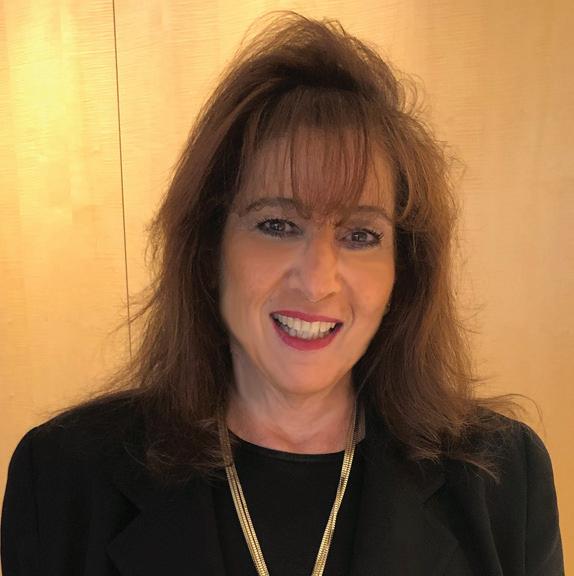
Later, when Riverso’s firm wanted to develop a construction practice, she stepped up. “My father and brothers with significant construction industry experience were great resources in helping me understand the issues since I didn’t have an engineering background,” she says. She also found that her business education provided her with fundamental knowledge that gave her an advantage in the field.
“I can read and comprehend financial statements, I understand damages, the methodologies to support claimed amounts, balance sheets, and financial transactions,” she says. “It’s a great background to have.”
Now a formidable practitioner of construction law, Riverso is a member of the Construction Law Committee of the New York City Bar Association. She also has served as both chair and vice chair of the Nassau County Bar Association Construction Law Committee.
With greater seniority and less time spent traveling for work, Riverso sought to help her alma mater. She became involved with Manhattan’s Women Inspiring Successful Enterprise (WISE) program and speaks on panels for students interested in pursuing a law career. She also joined the advisory board of the O’Malley School of Business. Giving back, she notes, is a “natural thing for a Jasper.”
“You want to afford opportunities to the students, and let them know that this is not an institution where you just get an education and leave,” she continues. “Manhattan College is an institution where you get an education supported by loyal alumni who will assist you throughout your career.”
ALUMNI 56 N spring 2024
Pia Riverso ’82 has been named a Super Lawyer in the Metro New York area in Business Litigation for 10 years running.
Ryan McPartlan ’18: Exploring a Career in Tech and Politics

IT’S LATE FEBRUARY, 10 MONTHS FROM ELECTION DAY, AND RYAN MCPARTLAN ’18 is in the midst of a busy day as an organizer for the political action committee (PAC) Progressive Victory. The Yonkers, New York, native is temporarily living in a house in Cincinnati, Ohio, along with seven other young people as they train to become state leads in swing states during the runup to the November 2024 general election. Beginning in May, he will be the state lead for Pennsylvania.
While the PAC focuses on rallying young people for progressive Democratic candidates via the internet, organizers like McPartlan also do a significant amount of doorto-door canvassing to encourage voter engagement and connect with voters of all stripes, including those who are undecided or who lean Republican.
“We mostly want to have friendly, positive conversations … showing them that we’re people trying to defuse the tension because we’re in historical levels of polarization,” he says.
Canvassing days are long but rewarding. One family he spoke with was interested in voting but had not registered, unsure of the voting process.
“I showed them how to look at their candidate websites, how to look at their issue pages, how to determine what issues were important to them,” McPartlan recalls. “We spoke for 30 minutes, and those people are very likely lifelong voters now.”
Having majored in computer science at Manhattan, he aims to balance his pursuit of a related career with his interest in politics by spending every general election year helping with political causes, and then returning to work as a software developer. It’s where he has spent most of his career to date.
McPartlan got a foot in the door while still a student at Manhattan, when he entered a coding competition run by the workforce development startup Correlation One. He came away with first place and an internship with the company, which he then parlayed into a full-time job.
The company began providing talent upscaling in areas like data science, cybersecurity, basic computer science and technical skills for people in developing nations.
As one of only three full-time web engineers, McPartlan gained broad experience at Correlation One — experience that, he believes, would not be possible at a larger software company.
“I could do anything and have a huge impact,” he says. “I was building the infrastructure, the website where students can submit assignments, where teachers can download assignments, grade them and reupload them … Many students didn’t have fancy computers, so we had to give them cloud computing resources so that they could run their code.”
After five years with Correlation One, McPartlan went on to work as a software engineer at Google, but confesses that he missed the breadth and scope of work that he was able to do in the startup environment.
“It takes years and years [at a large tech company] to gain the amount of influence to make the big, important decisions,” he says.
As a young alumnus, he is happy to share a few tips for current computer science students. The first is to take advantage of coding competitions. “These opportunities are criminally underutilized,” he notes.
Second, “Changing jobs frequently is good idea. Exploring a bit, knowing that you have leverage, and career capital and making the most of it.”
Lastly, he advises, “Network. Everyone should be in a group chat with their Manhattan College friends. Networking is just being a good friend, showing that you’re competent, and putting a deliberate effort into doing that.”
Whether working for a startup, for a tech giant or in the political realm, McPartlan has kept in close contact with his former computer science professors at Manhattan.
“Dr. [Ankur] Agrawal, Dr. [Kashifuddin] Qazi and Dr. [Igor] Aizenberg set me up with the tools to succeed, so I try to swing by once a semester to talk to students about my career trajectory. I recently sat on an alumni panel,” he says. “I love participating in that ecosystem, giving back to students and being around Manhattan College.”
MA nHATTA n .EDU N 57
From startups to campaigns, Ryan McPartlan ’18 recommends changing careers and often.

INMEMORIAM
Manhattan College records with sorrow the deaths of the following alumni:
1947
Kenneth C. Appell, 6/14/23
1949
Thomas C. Byrnes, 7/8/23
William A. Ranke, 8/12/23
Gaspar J. Sacconi, 11/17/23
Joseph A. Tursi, 1/5/24
1950
James J. Cavanaugh, 11/28/23
Alfred J. Schrafel, 11/28/23
1951
Donald F. Brosnan, 5/2/23
Joseph E. Byrne, 10/9/23
Gerald D. Curtin, 11/16/23
Paul J. Murtha, 1/5/24
1952
Peter A. Carbone, 6/10/23
John J. Will, 5/24/23
Robert T. Williams, 7/19/23
1953
Cleto P. Caruso, 7/13/23
Arthur J. Dunne, 11/19/23
Kevin T. Ettinger, 5/10/23
William F. McCully, 6/30/23
Daniel J. Murphy, 12/2/23
Eugene Papay, 5/22/23
John W. Tobin, 10/23/23
1954
Herbert C. Canapary, 9/2/23
Isabel Charles, 11/26/23
John T. Maloney, 4/1/23
Michael J. Roche, 8/9/23
1955
Thomas P. Conlon, 10/2/23
Michael A. Cosenza Jr., 12/3/23
Clayton J. Dillon, 1/10/24
George A. Fioto, 1/13/23
William J. Murphy, 6/4/23
1956
Edward P. Coffey, 5/21/23
William M. Doran, 7/3/23
Francis J. Geiser Jr., 1/4/24
Brian S. Jones, 10/11/23
Carl A. Kjellberg, 10/4/23
George E. Massey, 11/2/23
Carl A. Moschella, 3/1/23
Charles P. O’Hara, 5/2/23
Thomas R. Tucker, 8/12/23
1957
Andrew M. Burger, 1/17/24
Theodore B. Burger, 10/11/23
William F. Makaus, 6/29/23
William P. Steponkus, 1/14/24
Christopher M. Sullivan, 7/31/23
John J. Uhran Jr., 10/2/23
1958
Charles J. Cavanaugh, 5/20/23
William M. Cuddy, 11/29/23
Thomas P. Krehnbrink, 8/7/23
Joseph J. Milone, 1/2/24
David D. Nicholas, 5/8/23
Simone Palasciano, 11/22/23
Charles T. Peterson, 8/11/23
James P. Phillips, 1/16/24
James B. Steiner, 9/8/23
Bernard J. Woerz, 12/1/23
1959
Edward J. Ahearn, 12/11/23
John K. Carron, 12/14/23
William J. Lenskold, 1/8/24
Rev. Msgr. John T. Meehan, 1/5/24
1960
Vincent J. Clerkin, 7/12/23
John P. Curley, 11/24/23
Kevin R. Guidera, 12/13/23
Robert B. Koch, 9/28/23
James P. O’Brien, 11/5/23
1961
Robert J. Camoin, 10/6/23
Donald J. Davey, 5/5/23
John W. Flanagan, 1/6/24
Terrence A. Galligan, 11/26/23
James A. Glenister, 1/17/24
James J. Kilroy, 9/24/23
John T. Power, 4/1/23
John R. Rueckel, 10/8/23
Charles H. Thornton, 12/12/23
1962
Salvatore J. Congello, 12/5/23
John Consentino, 5/31/23
Charles L. Crawford, 8/11/23
Joseph F. De Bernardis, 7/29/23
Frank P. Gambeski, 1/23/23
John M. Heavey, 5/8/23
Simone A. Muscarnera, 8/13/23
John P. Tedesco, 10/25/23
1963
Salvatore A. Alamia, 5/16/23
Lawrence T. Byrnes, 7/3/23
Francis J. Delea, 5/11/23
Paul A. Hickman, 9/23/23
Robert A. Martin, 11/11/23
Lorenzo A. Messina, 11/3/23
Michael J. Passarella, 9/22/23
Henry Petroski, 6/14/23
Joseph G. Schatz, 12/7/23
Michael J. Skelly, 9/12/23
Donald G. Sweeney, 11/27/23
Edward J. Wilkens, 12/16/23
1964
Stephen H. Dickmann Jr., 9/29/23
Barnett A. Epstein, 1/29/24
Robert E. Heath II, 4/8/23
Robert G. Kelly, 5/9/23
Raymond J. Murphy, 5/25/23
Harold J. Murray Jr., 6/12/23
Daniel J. Randall, 12/3/23
Thomas R. Siggins, 9/15/23
Stephen R. Troy, 11/18/23
1965
John C. Brereton, 12/20/23
John J. Giblin, 1/6/23
Thomas J. Guida, 4/28/23
Michael F. Linnane, 1/24/24
Robert McGoldrick, 10/19/23
Brian P. Murray, 2/22/23
James E. Saunders, 10/21/23
Gerard H. Schultheis, 9/4/23
John J. Valentino, 9/29/23
William H. Webber Jr., 5/28/23
Frank J. Yocca, 5/28/23
Donald R. Ziesig, 7/29/23
1966
Richard G. Fontana, 11/29/23
John A. Huie, 5/18/23
Edward P. O’Connor, 4/13/23
Geoffrey K. Orlando, 7/9/23
58 N spring 2024 OBITUARIES
1967
Steven Burchik, 2/25/24
Sr. Teresa Dermody, S.C., 12/25/23
Alan J. Hogan, 10/15/23
Bernard J. Martin, 1/29/24
George A. Montagno, 5/27/23
Brendan F. Neligan, 9/21/23
John P. Ricci, 1/25/24
Richard J. Walko, 10/2/23
1968
John F. Beauchemin, 7/30/23
Roger W. Cusack, 2/2/24
Peter M. Doshna, 8/14/23
Thomas M. Elgert, 12/25/23
John P. Lyons, 6/20/23
Jose F. Nhancale, 2/3/24
John M. Reynolds, 5/27/23
1969
William F. Bunte, 10/30/23
John R. Masterson, 10/2/23
Claire S. McMahon, 5/8/23
Arthur R. Sullivan Jr., 6/23/23
1970
Timothy W. Carr, 9/30/23
Martin D. Considine, 1/11/24
Joseph T. Crawford Jr., 12/24/23
Kenneth H. Gusciora, 10/17/23
Robert A. Maddalena, 11/27/23
William J. Mealey, 12/11/23
Patricia A. Murphy, 7/8/23
Sr. Florence M. Rice, SHCJ, 10/17/23
Daniel W. Walsh, 12/12/23
1971
Patricia A. Crowley, 10/14/23
Gerald Doherty, F.M.S., 1/23/23
James H. Finneran, 5/16/23
Paul J. Gray, 12/3/23
Michael Maselly, 8/20/23
John A. Milano, 11/29/23
Richard P. Power, 1/26/24
1972
Gregory V. Driscoll, 4/1/23
Rev. Gregory P. Lyttle, 6/27/23
William J. Sammis, 7/4/23
Richard P. Shouldis, 11/10/23
1973
Margaret Bowler, 10/14/23
Donald M. Gallagher, 7/12/23
Edward T. Hicks, 1/12/24
John J. Montague III, 8/7/23
Barbara F. O’Brien, 1/1/24
Daniel M. Piccolo, 9/29/23
1974
Joseph J. D’Alessandro, 11/3/23
Charles J. Fausti, 8/24/23
John S. Tesoriero, 10/3/23
1975
Anthony J. Dilodovico, 8/11/23
George Magyar, 10/13/23
Patricia W. Ruckel, 10/7/23
Joseph A. Valdes, 1/6/24 1976
John T. Landers, 10/16/23
Patrick J. Sullivan, 10/16/23
1977
Arthur Carosi, 10/21/23
William C. Duffy, 9/24/23
Michael S. Lamonica, 1/8/24
Elaine Meranto, 6/3/23
1978
Kenneth Balban, 2/18/23
George J. Gintoli, 12/1/23
Lawrence P. Moretti, 8/17/23
1979
John A. Bracco, 1/5/24
Alexander J. Cestaro, 1/15/24
Theresa H. Foiles, 9/24/23
John M. Garbowski, 1/3/24
Morris L. Johnson, 10/12/23
David W. Kay, 5/15/23
Mary C. Shugrue, 4/28/23
John C. Springsteen, 11/20/23
1980
Estelle H. Brocks, 6/25/23
1981
Kim A. Bowden, 7/16/23
William J. Mackey, 3/27/23
1982
John F. Degnan, 11/1/23
1983
Dennis J. McSweeney, 5/23/23
Donovan E. Morgan, 4/28/23
Brian J. Reynolds, 4/16/23 1984
Richard T. Iervolino, 5/24/23
James R. Tepperwien, 8/31/23 1985
Joseph E. Morales, 3/20/23 1987
Janet E. Lupo, 10/11/23 1988
Eileen Baxter, 9/8/23
1989
James A. Dauterman, 7/14/23
Debra A. Molinaro, 12/31/23 1990
Julia A. Sutton, 1/13/24
1991
Sarah R. Davis, 7/15/23 1992
Ancel Y. Bowlin, 1/5/23
Kevin M. Hurley, 11/8/23
Michael E. Shanahan, 12/26/23
1993
Edward T. Geraghty, 4/16/23
1997
Joseph Brady, 5/13/23
2000
Shana R. Clavijo, 6/16/23
Ruth E. Mazzarella, 5/26/23 2022
Makayla T. Tralongo, 8/28/23
MA nHATTA n .EDU N 59

Henry Petroski ’63
HENRY PETROSKI ’63, a member of the National Academy of Engineering, renowned author of more than 20 books, Manhattan College honorary degree recipient, and civil and environmental engineering professor at Duke University for four decades, died on June 14, 2023. He was 81.
Petroski, who graduated from Manhattan College with a bachelor’s degree in mechanical engineering, was known for making difficult engineering and science concepts understandable for the general public.
“He excelled at explaining physical and engineering concepts to an audience of non-specialists,” says William Walters, executive director of Manhattan’s Mary Alice & Tom O’Malley Library. “He demonstrated how complex scientific, economic and cultural factors come together in the design of the objects we use in our everyday lives, and he was an effective advocate for engineering education that focused on both scientific principles and creative ingenuity. His writing is always engaging and enjoyable to read, probably because he focuses on narrative — on storytelling — even when explaining complex scientific processes.”
After graduating from Manhattan, Petroski earned master’s and doctoral degrees in theoretical and applied mechanics from the University of Illinois at Urbana-Champaign in 1964 and 1968. While working toward his degrees, he found his passion for writing when one of his assignments was accepted into a literary magazine.
Petroski began teaching engineering at the University of Texas at Austin before joining Argonne National Laboratory as a leader of its research and development efforts in fracture mechanics.
During the course of his career, Petroski wrote numerous books and articles in publications including The New York Times, Washington Post, Los Angeles Times, Forbes and The Wall Street Journal. He was also a regular columnist for the magazines American Scientist and ASEE Prism
His first book, To Engineer is Human (Vintage Books, 1992), was meant to answer the question, “What is engineering?” Petroski used bridges and buildings to show how engineering is about design, and that failures are part of the design process.
His books, including The Pencil: A History of Design and Circumstance (Knopf Doubleday Publishing Group, 1992), and The Evolution of Useful Things (Vintage Books, 1994), gained commercial success and critical acclaim. Petroski’s most recent book, Force: What It Means to Push and Pull, Slip and Grip, Start and Stop (Yale University Press, 2022), explores the ongoing physical interaction between people and things that enable them to stay put or to move.
Petroski also continued a successful technical career at Duke University, where he was named the Vesic Professor of Civil and Environmental Engineering in 1993. His research was sponsored by the U.S. Army Corps of Engineers, the National Science Foundation, the Alfred P. Sloan Foundation and other organizations. He published more than 75 refereed journal articles in such publications as the
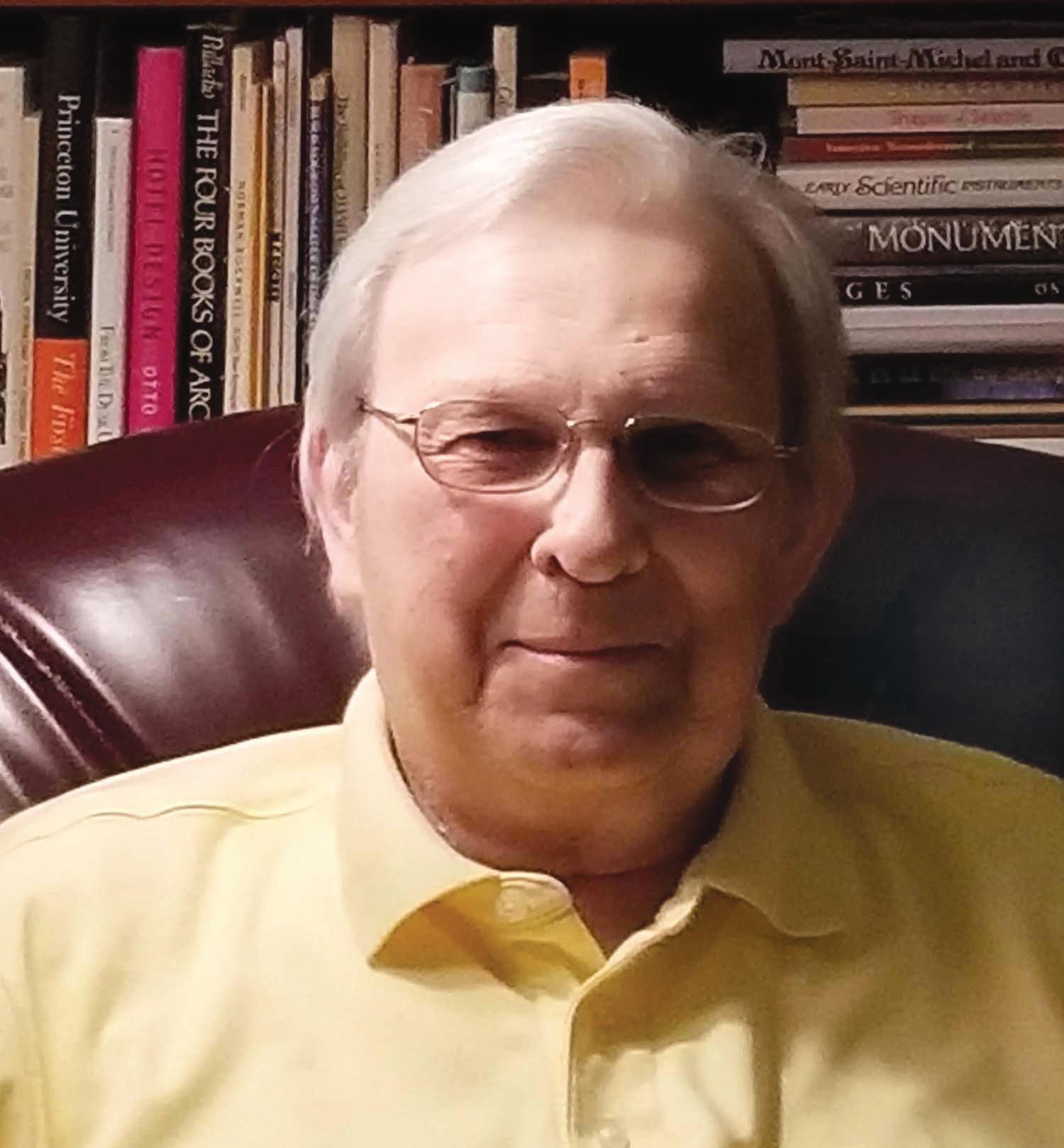
International Journal of Fracture, Engineering Fracture Mechanics, Journal of Applied Mechanics, Structural Safety and Research in Engineering Design
A distinguished member of the American Society of Civil Engineers, he was also a fellow of the American Society of Mechanical Engineers, and an elected member of the National Academy of Engineering, American Academy of Arts and Sciences, and American Philosophical Society. He held fellowships from the Guggenheim Foundation, the National Endowment for the Humanities and the National Humanities Center.
Honored throughout his career, Petroski received the Ralph Coats Roe Medal from the American Society of Mechanical Engineers; Washington Award from the Western Society of Engineers; and Civil Engineering History and Heritage Award from the American Society of Civil Engineers. He earned an honorary Doctor of Pedagogy from Manhattan College in 2003, and also received honorary degrees from Clarkson University, Trinity College (Connecticut), Valparaiso University, Missouri University of Science and Technology, and McGill University.
He is survived by his wife, Catherine Petroski; his daughter, Karen Petroski (T.J. Bross); his son, Stephen Petroski (Laura); and two grandsons.
60 N spring 2024
OBITUARIES
Michael Passarella ’63
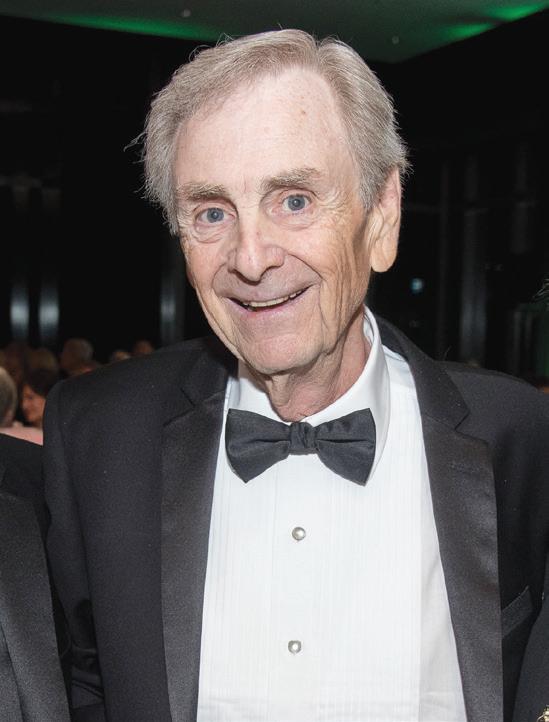
MICHAEL PASSARELLA ’63, a retired executive of Price Waterhouse and longtime trustee at Manhattan College, died on Sept. 22, 2023. He was 82.
Passarella shared his business expertise while serving on the Manhattan College Board of Trustees from 2002-17. In 2012, he was appointed vice chair, and in 2017, he was named a trustee emeritus. During his tenure, he served as a member and chair of the Committee on Finance and Investment and as the inaugural chair of the Audit Committee.
“It was a pleasure working with Mike on the board of trustees,” says Milo Riverso ’81, president. “He brought his business expertise and blended it with his love for everything Jasper. He will be missed, especially in the bleachers at Draddy.”
Passarella was a dedicated and generous donor, contributing to major College fundraising campaigns, including the Raymond W. Kelly ’63 Student Commons, and consistently contributing to other campaigns and events. A dedicated Jasper basketball fan, he rarely missed a game, especially those played at Draddy Gymnasium.
“Mike was one of the most remarkable trustees and friends that I encountered in my career,” says Thomas Mauriello, senior vice president for college advancement. “His financial acumen was only overshadowed by his extraordinary love and passion for all things Jasper. We all lost a dear friend and will miss him greatly. And basketball games will simply never be the same without him.”
A native of Manhattan, Passarella was born in Greenwich Village and grew up in Inwood. He graduated from Manhattan College with a bachelor’s degree in accounting in 1963 and began his career as a certified public accountant at Price Waterhouse, where he became an audit partner in 1975. Passarella managed Price Waterhouse’s U.S. securities practice before becoming PriceWaterHouseCooper’s global capital markets audit leader, a position he held from 1998 until his retirement in 2002.
From 2005 to 2014, Passarella served as a member of the Board of Directors and chairman of the Audit Committee of The Unum Group, an insurance holding company. He was a director and audit committee chair of Archipelago Holdings, an all-electronic U.S. stock market, and Nyfix Inc., a provider of electronic securities trading solutions.
In addition, he was a decades-long supporter of Catholic Big Brothers and Big Sisters and a dedicated member on the board of TheaterWorks.
Passarella is survived by his wife of 60 years, Ann; his children, Lynn Passarella (Scott Rogers), Susan Donovan (John), and Michael Passarella (Elizabeth); and eight grandchildren.
Father Greg Lyttle ’72
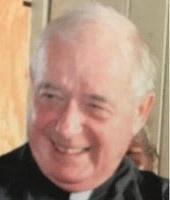
FATHER GREG LYTTLE ’72 (M.A.), who served as a member of the College’s Campus Ministry team during the 1980s and 1990s, died on June 27, 2023. He was 81.
Father Greg began working with Campus Ministry in 1984. During his tenure, he helped run retreats, celebrated Masses and worked with students who were preparing for their sacraments. While at the College, he also served as one of the Catholic chaplains for the Kolping Residence in the Bronx and for Marian Woods, a home for elderly religious sisters in Hartsdale, New York.
“Father Greg gave all new meaning to the phrase ‘an easy style.’ Working with Brother Gabriel Healy, FSC, and Sister Kay Hennessy, the three of them formed a team that welcomed Jaspers to experience the sacramental life of the Church and helped them explore paths on the way to adulthood,” says Brother Robert Berger ’73, FSC, associate professor of religious studies. “Armed with a ready smile, a listening ear and a nonjudgmental attitude, Father Greg lived his life for others, whether they be students, faculty, staff, alumni/ae or administrators. May he now enjoy the Presence that he introduced so many to while he generously lived out his priestly ministry for years at Manhattan College.”
Father Greg began his training at the Maryknoll Seminary in Ossining, New York, and earned a Master of Arts from Manhattan College in 1972. His mentor and spiritual director, Father Ronaldo Borzaga, a professor at the College, introduced Father Greg to the Order of the Compagnia di San Paola in Milan, Italy, in the 1970s, and Father Greg was ordained in 1975. He began his ministry as director of religious education at St. Peter the Apostle in River Edge, New Jersey, his hometown parish. He also served as director of religious education at St. Patrick’s Church in Yorktown, New York, before he began at Manhattan College.
Throughout his priesthood, Father Greg traveled and shared his ministry. In Milan, he was elected as secretary of priests for the Society of St. Paul. In the Bahamas, he celebrated Mass at a number of churches for Christmas and Easter.
In 1995, Father Greg served as the Catholic chaplain at the veterans affairs hospital in the Bronx. He retired in 2009 and moved to West Virginia to care for his mother. While in West Virginia, Father Greg continued to celebrate Mass at parishes in Princeton and Bluefield, as well as at other churches in the state.
He is survived by a large family of siblings, nieces and nephews.
MA nHATTA n .EDU N 61

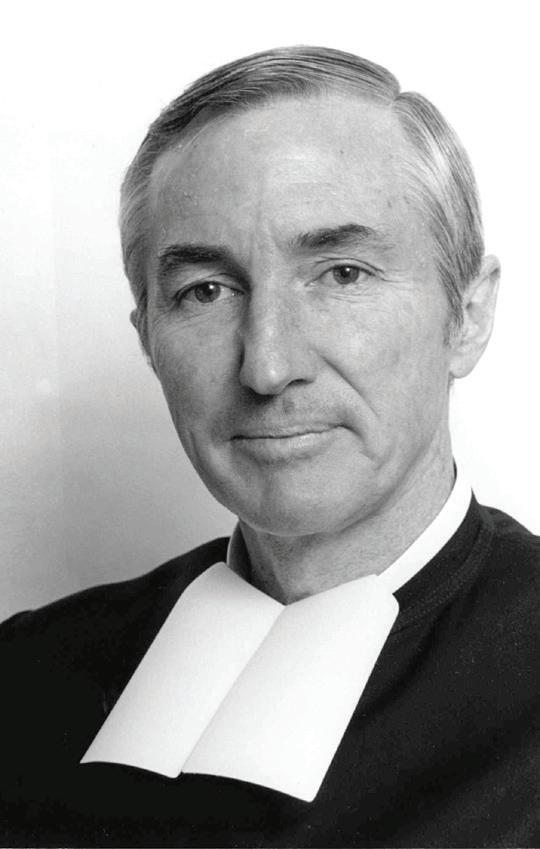
Brother John Muller, FSC
BROTHER JOHN MULLER, FSC, former executive vice president who held a number of leadership positions during his more than 50 years at Manhattan College, died on June 4, 2023. He was 89. He began his career at Manhattan College in 1970 as an assistant professor of government and politics and rose to the rank of associate professor emeritus. During his tenure, Brother John served as director of the Urban Affairs program and was a member of the College Senate. He also was a member of the Pre-law Advisory Committee and the St. Thomas More Law Society.
Winsome Downie, assistant professor emeritus of government, recalls working with Brother John when he was a member of the faculty. “Brother John Muller was caring and considerate, as he graciously welcomed me into the Government department, and as the first director of the Urban Affairs (now Urban Studies) program, served as a valuable resource for me, as I subsequently succeeded him as the program’s director in 1984,” she says.
He was appointed executive vice president under Brother J. Stephen Sullivan, FSC, in 1982 and served in this position for a decade. While at the College, Brother John had held a number of other administrative positions, including director of institutional research, assistant to the president, and director of planned giving.

Brother John entered the novitiate in 1951. He received the religious habit, taking the name of Brother Benilde John in September of 1951 and pronounced his perpetual vows in 1958 in Barrytown, New York. He was elected as a delegate to the 40th General Chapter of the Christian Brothers in 1976.
He earned his bachelor’s degree in history from The Catholic University of America in 1956, where he was a member of Phi Beta Kappa and Pi Gamma Mu. He also earned his master’s and doctoral degrees in political science from Fordham University. Brother John was awarded academic fellowships by the National Endowment for the Humanities for historical, social and cultural studies of U.S. ethnic minorities and by the National Science Foundation for study within the Institute of Public Policy Analysis at the University of Minnesota.
Brother John taught at a number of schools before he began his tenure at Manhattan College: Ascension School and Good Shepherd Elementary School in Manhattan; Lincoln Hall in Lincolndale, New York; and Cardinal Spellman High School in the Bronx. He also served at Resurrection School in Harlem from 2003 to 2008, before returning to Manhattan College as a resident and active member of the community.
“Let us return to John’s religious name,” said Brother David Van Hollebeke, FSC, who was a Christian Brother with Brother John for 72 years, during his eulogy. “When the French Brother Benilde was beatified, Pope Pius XII stated that Benilde became a saint not only by praying but because he went ‘through the terrible daily grind’ and ‘by doing common things in an uncommon way.’ ... That was how Brother Benilde John Muller lived his life.”
He is survived by many nieces and nephews.
Father James Cerbone Jr., SDB
FATHER JAMES LEE CERBONE JR., SDB, chaplain for the department of Campus Ministry and Social Action at Manhattan College from 1998 through 2007, died on Dec. 19, 2023. He was 74.
Father James worked with students to prepare for the sacraments and oversaw liturgies and all chapel needs. He also ran pilgrimage trips around the world for students and other members of the College community.
“Father James was a servant to the students and a believer in the mission of the Church-evangelization,” says Brother Daniel Gardner, FSC, executive director of Campus Ministry and Social Action. “He practiced both
at Manhattan College with faith and love.”
“Being a Salesian, he had a special care for students who had troubles in life and school,” notes Lois Harr, then the director of Campus Ministry and Social Action. “He would take the time to reach out and try and find a good situation for them.”
A native of New Jersey, Father James entered the novitiate at Don Bosco College in Newton, New Jersey, as a Son of Mary in 1969. He made his first profession of vows in 1970 and graduated from Don Bosco in 1972 with a Bachelor of Arts degree in philosophy and minors in history and classics. He left the Salesians that year to enter the Immaculate Conception Seminary of the Newark
OBITUARIES 62 N spring 2024
Charles Thornton ’61
CHARLES THORNTON ’61, ’13 (HON.), a member of the prestigious National Academy of Engineering and, who during the course of six decades, was instrumental in building and designing some of the most famous buildings in the world, as well as creating pathways for educating generations of engineers, died on Dec. 12, 2023. He was 83.
The co-founder of Thornton Tomasetti, Thornton and fellow alumnus Richard Tomasetti ’63 grew their New York engineering firm into an international organization known for its innovation and creativity.
“Charlie Thornton was a visionary, foreseeing the needs of structural engineering education, the building industry and the public it serves,” Tomasetti says. “He was equally dedicated to mentoring everyone in our firm and future generations through his founding of the ACE mentoring program. His support of Manhattan College through teaching, being a trustee, donating a room in the engineering building and contributing to the establishment of the Thornton Tomasetti Chair, the first one in the Civil Engineering department, will be felt for years to come. His numerous innovative projects throughout the world are a tribute to his engineering prowess and his education from Manhattan College.”

ideas as possible.’ Charlie, of course, was much more than a good engineer. He was a truly great one.”
Beyond constructing buildings, Thornton also believed in supporting the building of the next generation of engineers. He was a founding member of the ACE Mentor Program, a nonprofit organization that gives high school students the opportunity to learn about careers in engineering, architecture and construction. The ACE Mentor Program, which serves more than 10,000 students each year, now reaches high schoolers in more than 70 metro areas. It even received the Presidential Award for Excellence in Science, Mathematics and Engineering Mentoring from President Barack Obama in 2010, which Thornton accepted at a White House ceremony. (Read more about ACE, page 38.)
Known for taking on projects others thought impossible, he left his mark with iconic landmarks around the world, including pavilions at the 1964 World’s Fair in New York City, the Petronas Twin Towers in Kuala Lumpur, Malaysia, and Chifley Tower in Sydney, Australia.
“Charlie was dedicated to finding solutions — and putting them into action,” said President Milo Riverso ’81 in his remarks for Thornton’s memorial service. “Parsimony, after all, is a core precept of our profession. As the physicist and mathematician Freeman Dyson once noted, and I quote: ‘A good scientist is a person with original ideas — a good engineer is a person who makes a design that works with as few
He received numerous awards and recognitions throughout the years, including an Honorary Doctor of Engineering from Manhattan College at its 2013 Commencement Exercises. Other honors include the Fazlur R. Khan Lifetime Achievement Medal and the Benjamin Franklin Medal in Civil Engineering. He was inducted into both the National Academy of Engineering and the National Academy of Construction. He was also named an honorary member of the American Institute of Architects and the American Society of Civil Engineers.
Thornton was awarded his bachelor’s degree in civil engineering from Manhattan College, and went on to earn his master’s degree in civil engineering and his doctoral degree in structural and engineering mechanics from New York University.
He is survived by his wife Carolyn; his daughters, Diana, Kathy (Brian) and Becky; and his son, Charles III (Kathleen); his seven grandchildren; two great-grandchildren; and brothers, William ’60 (Joan) and Robert (Gerry).
Archdiocese in New Jersey. But he returned to the Salesians in 1973 and made his perpetual vows in 1977. Father James was ordained in his home parish in 1980.
He completed theological studies at the Pontifical College Josephinum in Worthington, Ohio, while living with the Salesian community in Columbus from 1976 to 1979. Father James went on to earn a master’s degree in divinity at the Josephinum in 1980. Later, he studied accounting at Notre Dame, and earned a Master of Science in accountancy in 1983, followed by a master’s in religious education from St. Joseph Seminary in Yonkers, New York, in 1990.
Father James began teaching at Don
Bosco Prep in 1974, where he taught history, English and theology and was a moderator of a number of clubs. As a deacon, he was assigned to Don Bosco College and taught theology in 1979-1980. He also served as treasurer at the Marian Shrine in Haverstraw, New York. For seven years, beginning in 1984, he was an assistant in the treasurer’s office at the provincial house in New Rochelle, New York. Father James served as assistant pastor at Mary Help of Christians on 12th Street. During a leave from the Salesians, he served as assistant pastor at Holy Trinity Church in Poughkeepsie, New York.
Father James held a number of ministries after Manhattan College, including St. James
of the Marches Church in Totowa, New Jersey, and Don Bosco Prep, where he taught and worked in campus ministry.
He is survived by his sisters, Susan Cerbone and Gloria Malecki; and his nephew, Richard Malecki.
MA nHATTA n .EDU N 63
Photo courtesy of Salesian Provincial Archives Photo credit: Thornton Tomasetti

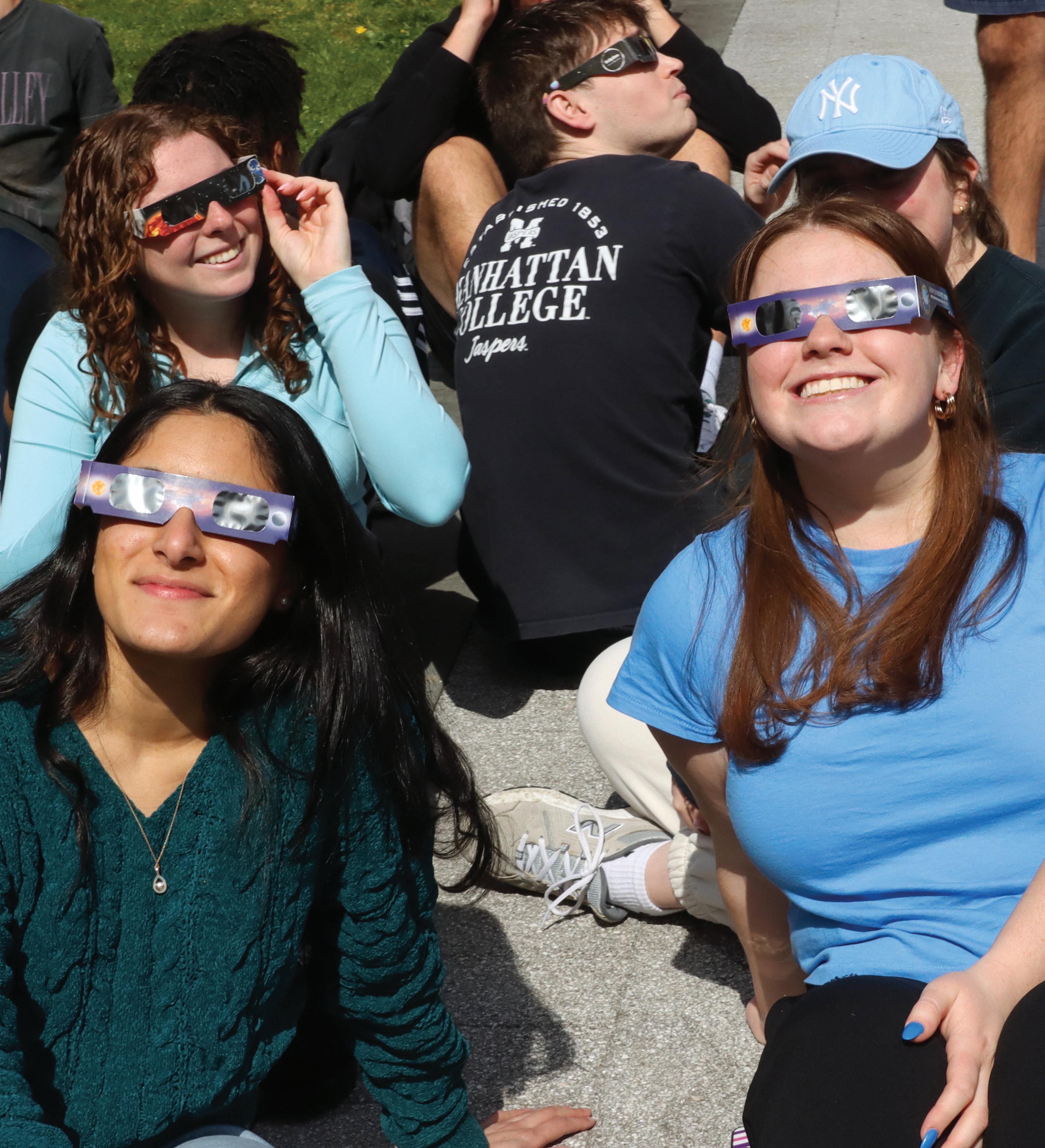
BY
64 N spring 202 4 PARTING SHOT
PHOTO
RYAN WERNER
Donning their protective eye glasses, students, along with faculty and staff, packed the Quad on April 8 to witness the solar eclipse. The moon covered about 90 percent of the sun at 3:25 p.m. in the Bronx, giving the College community a stunning glimpse of the celestial event.
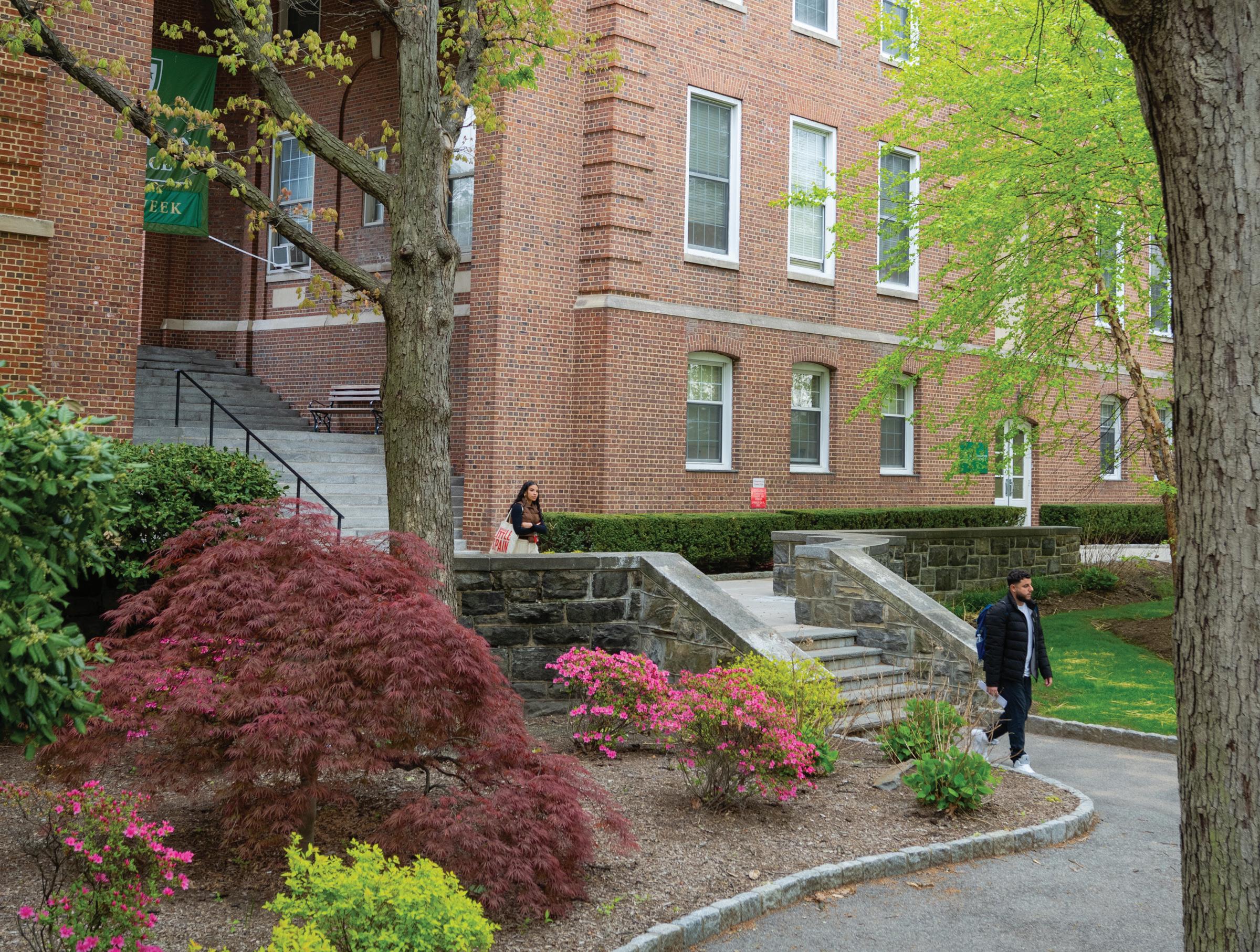
Published by the office of Marketing Manhattan College 4513 Manhattan College Parkway Riverdale, NY 10471 NON-PROFIT ORG. U.S. POSTAGE PAID BURL, VT 05401 PERMIT NO. 19
1853
A LASALLIAN CATHOLIC COLLEGE SINCE
Spring returns to campus, bringing pops of bright colors, abundant blooms and eagerly awaited warmer temperatures.































 JIMENA GONZÁLEZRAMÍREZ, ASSOCIATE PROFESSOR OF
JIMENA GONZÁLEZRAMÍREZ, ASSOCIATE PROFESSOR OF
 PARISA SABOORI, PROFESSOR AND CHAIR OF THE MECHANICAL ENGINEERING DEPARTMENT
PARISA SABOORI, PROFESSOR AND CHAIR OF THE MECHANICAL ENGINEERING DEPARTMENT







































































































